How to solve common puppy problems
From barking to jumping up, here's how to solve 10 of the most common problems you may have with your puppy.
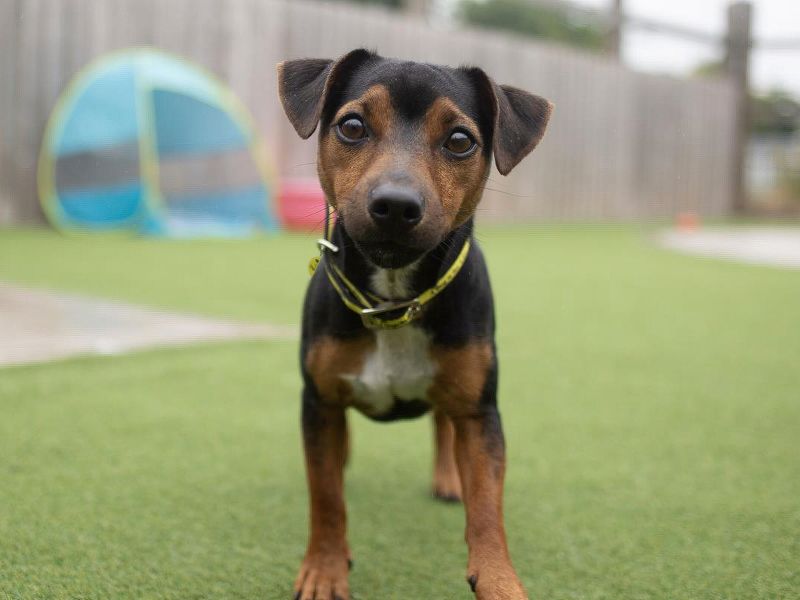
Puppies aren’t born knowing how they’re expected to behave. This is why you may find some of their behaviours problematic. Don’t worry – this is normal and puppies simply need to be taught in a careful and positive way. That way, they learn what they can and can’t do.

Most common puppy behavioural issues
To help, here’s a list of behavioural issues alongside the solutions. These will help you to understand your dog’s behaviour and deal with any problems.
Solution: It’s normal for dogs to bark. But, if they do it constantly – or always at something in particular – it can be problematic. It’s important to act early. Doing so will prevent normal barking (or the reasons for barking ) from developing into something more serious.
The key to reducing and even preventing barking is to understand why your dog is barking in the first place. Then remember:
- don’t tell your puppy off for barking
- ignore them and wait until they stop
- reward them when they remain calm and quiet, not only as soon as they stop barking
- if they bark because they are scared, try and avoid the triggers for this
- show your pup there’s a calmer way to tell you what they want
- make sure they are getting enough exercise and don’t get bored.
You need to teach your pooch to be confident and calm from when they’re a puppy. Your pup should experience the hustle and bustle of life early on, in a positive and gradual way. This includes learning to be calm when alone and getting used to people coming in and out of the house .
This will give them the best chance of coping well in future unusual and unexpected situations.
2. Frequently seeking attention
Solution: Dogs are social creatures. But, is your pooch clingy? Do they follow you around the house? Are they constantly seeking attention? Then you need to teach them how to spend time alone . This is important to avoid separation anxiety from developing.
You could use a baby gate to do this, so you can introduce time apart while allowing them to still know you are there. Make sure they have a cosy bed and a long-lasting treat with them. Then, gradually move further away from the gate and slowly start to increase the time you leave them for.
3. Unsure when being handled
Solution: Your pup will need to interact with, and be handled by, various people throughout their life. But, whether it’s a vet or a dog groomer, it can be worrying or confusing. This is why you need to teach them to feel comfortable when being handled.
To do this:
- Handle your pup on parts of their body they are comfortable with.
- Keep an eye on their body language to ensure they remain comfortable. If they stay calm and relaxed, move your hand away and then reward them with a treat.
- Gradually increase the length of time you handle them for. Stop if they move away, use their mouth on your hand or show signs of worry.
- Once they are comfortable, move to other parts of their body such as ears, tails and paws.
- Over time, you can introduce grooming equipment and new people. You can also do it in different environments.
- Touch their collar (increase the time you hold it for and reward them.) Plus, teach them to wear a harness .
4. Hide or move away when approached
Solution: If your pup appears to lack confidence or is a little shy, don’t worry! There are lots of things you can do to help:
- learn to recognise when your pup is feeling worried and avoid things they find scary
- if your pup is worried, don’t force them to interact and give them space
- provide a cosy den at home so your pup has the option to hide away for some quiet time should they choose to
- reward bravery and don’t be tempted to coax your pup into a scary situation
- train your pup using kind, reward-based methods , and avoid telling them off
- have fun with your dog and engage them in things they enjoy. This will build up a bank of positive experiences that boost their confidence.
5. Pulling on the lead
Solution: It’s not unusual for dogs to pull but you need to teach them to walk calmly and on a loose lead. Firstly, continue to use the comfortable collar or harness you already have, to do this.
Now, start the training at home, rewarding and praising your pup for being close by. Then start to walk around, continuing to reward your pooch for staying by your side.
By this point, your pup should be walking nicely next to you. But, if they happen to pull, it’s important they don’t find this behaviour reinforcing. If they do, they’ll be more likely to do it again.
If the lead tightens, stop walking. Stand still, keep quiet and don’t move forward again until the lead is slack. Don’t jerk the lead back or tell your dog off – just stand and wait calmly and quietly. If your pup doesn’t turn back to you, try walking a couple of steps in the opposite direction to get their focus back.
Then, reward your dog when they walk nicely by your side again.
6. Mouthing, biting and chewing
Solution: Mouthing, biting and chewing are all normal behaviours. But, some pups can start doing it to you (or your furniture!) Although they won’t mean to hurt you, their little teeth can be very sharp. Here’s some do’s and don’ts to stop your puppy mouthing.

How to stop your dog chewing a...
7. going to the toilet inside.
Solution: It may take puppies a few months (and the odd accident) before they are completely housetrained . Don’t worry if it seems to be taking a while. Their bowels, bladders and the muscles that control them are still growing, after all.
- To stop your dog going to the toilet indoors, you need to show your dog where they should go. Then, reward them for doing their business somewhere appropriate. This will help them form good toileting habits.
- Give them plenty of opportunities to go to the toilet outside. This is particularly important while they’re learning to control their bowel and bladder.
- Learn to recognise the signs that show your pup needs to go to the toilet. This includes sniffing the ground, turning in a circle and starting to squat.
- If you see these signs inside, gently interrupt your pup, and take them outside to see if they’ll go to the toilet.
- If they go, reward them. If not, just quietly return indoors. But make sure to give them enough time to do their business before returning inside – patience is key.
- It’s important that you give your pup a reward as soon as they have been to the toilet. Then they’ll know that you are really pleased with this behaviour.
- Don’t tell them off if they have an accident indoors. This could make them anxious about you and make the problem worse.
- Make sure to clean up with a biological cleaning preparation. You want to ensure the smell is completely broken down and removed from the area.
8. Jumping up
Solution: Many dogs jump up when they are excited. It’s tempting to give puppies attention when they do it. But, this will encourage them to keep doing this into adulthood. Don’t tell them off – instead, stay calm and quiet. Teach them to keep all four paws on the floor and then reward them for doing this.
9. Ignoring you
Solution: Does your puppy always ignore you? Then you need to do focus training to get their attention.
Make sure your pup knows their name first. Then:
- say their name once, then when they look at you, mark and reward them
- repeat this until your pup is responding quickly when they hear their name
- if they’re not able to pay attention, avoid saying their name over and over again as they may learn to ignore it
- instead, try again in a quieter place with fewer distractions
- alternatively, use a treat to gain their focus - then say their name, mark and reward them
- remember that saying your dog’s name should always be positive for your dog.
Does your dog now know their name? Once they do, you can use it to gain their attention before asking them for something else, such as “come” on walks.
It’s also important to reward them when they voluntarily ‘check in’ with you. This will encourage them to offer attention. It will also help to build their focus on you when you’re out and about. On walks, simply watch your dog. Whenever they look at you, mark and reward them for ‘checking in’ with you.
You can also make your walks engaging by bringing your pup’s favourite toy. Get it out halfway round and ask for some basic, known behaviours at random timepoints. Alternatively, play a ‘find it’ game where you sprinkle some treats on the floor. This will all help to keep focus on you.
10. Not coming when called
Solution: If your pup ignores you when you call them then you need to brush up on their recall training .
- Teach your pup to respond to their name.
- Then use a recall cue such as “come” or “here.”
- Start in your garden and always reward them for coming back. Give them tasty treats, a fuss or play a game – use whatever reward your pooch likes best.
- Gradually increase the distance and add in distractions.
Don’t get angry if they don’t come back. We want to teach our dogs that coming back is always a good thing. That way they’ll be more likely to do it again.
Check out our Dog School classes where your pup will learn vital life skills. These will help prevent behavioural problems from occurring in the first place. Are you really struggling with your dog’s behaviour? Speak to a vet and they will be able to refer you to an accredited behaviourist.

If you liked this page, tell the world!
Related articles

How to stop your dog barking

How to stop your dog pulling on the lead

Finding behaviour and training...
Puppy Leaks
Tips & Tricks For Dog Owners
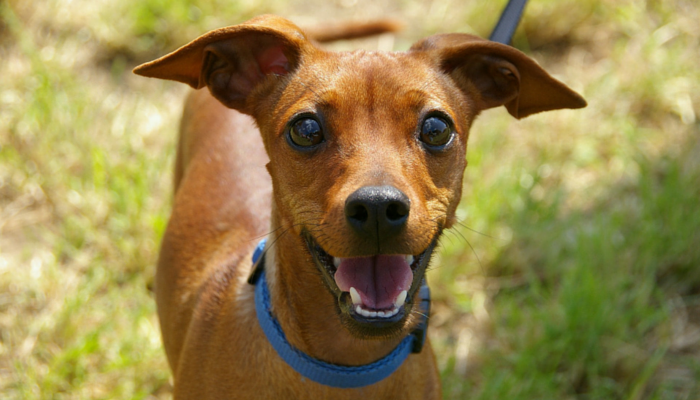
10 Fun Brain Games For Dogs
Last updated on February 1, 2024 By Puppy Leaks 17 Comments
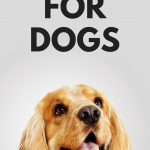
Looking for some fun and easy ways to entertain your dog and keep them mentally stimulated ? If so try adding a few of these fun brain games into their routine.
Brain games are a great way to bond with your dog, plus they’re good for teaching basic manners. Mentally stimulating activities like brain games enrich our dogs lives by giving them something meaningful to do, and because these activities alleviate boredom they can decrease the likelihood of our dogs developing behavioral issues such as excessive chewing or barking.
If you’re looking for some easy ways to challenge your dog’s mind (and keep them out of trouble) here’s 10 fun brain games for dogs.
Find the Treats
My absolute favorite brain game for dogs is a game of find the treats. It’s super easy to play (you just need treats), and it can be played pretty much anywhere.
Simple nose work game like find the treats will keep your dog mentally stimulated, and it’s a fun way to let them hone in on their natural sniffing and scavenging abilities.
How to play find the treats with your dog:
- Grab some treats and have your dog sit in a stay position
- While your dog is in the stay position put a few treats on the ground around them
- Give your dog a release command and tell them to “find the treats”
- Encourage them as they start picking up the treats
- Practice a few times until your dog understands what “find the treats” means
- Start placing the treats further away and repeat steps 3 & 4
- Start placing the treats in more challenging places that are out of sight such as under a rug or on a chair and repeat steps 3 & 4
Keep in mind that although dog’s have an excellent sense of smell that doesn’t mean they’ll automatically use it right away when playing this game. If they’re not used to sniffing things out it’ll take a little practice. That’s why gradually increasing the difficulty of where you hide the treats is important.
You’re teaching them to start utilizing their scent to find the treats rather than just relying on sight. Finding the treats themselves is rewarding for your dog, and the addition of your encouragement during the game can keep it exciting.
After your dog has a good concept of what “find the treats” means you can keep upping the game to make it more of a challenge for them. Since Laika’s been playing this game for years she’s gotten pretty good at it. She’ll hunt out those treats wherever I hide them — under rugs, on furniture, or on the window sill behind a curtain. All of those various hiding spots keep it exciting for her, and it’s a really simple way to keep her entertained.
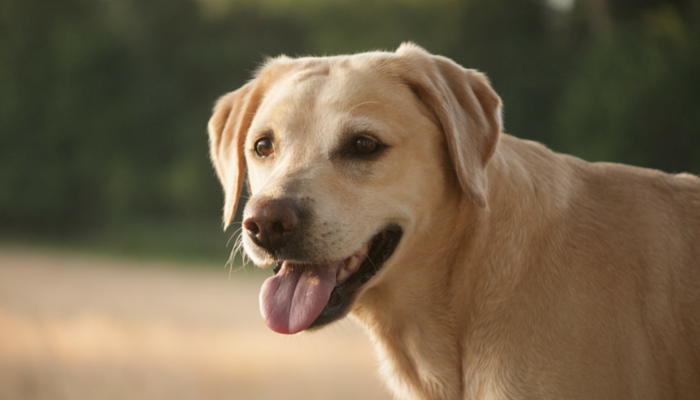
One of my favorite brain games for dogs is “find the treats.” It’s easy to play, and it’s mentally stimulating. It gives your dog the opportunity to use some of their natural instincts to work for food.
Food Dispensing Toys
Another fun brain game for dogs is using food dispensing toys . A food dispensing toy is any toy that contains food and requires your dog to work to figure out how to obtain the food. To use a food dispensing toy you simply fill it up with treats and encourage your dog to engage with it. As your dog starts moving the toy around it’ll start dispensing treats.
Food dispensing toys are a great way to give your dog some extra mental stimulation. And as with other food related games they give your dog a chance to use their natural scavenging abilities in a fun and challenging way. In the wild our dogs spent a lot of time hunting and searching for food, so they’re pretty receptive to the idea of having to work for their food. Food dispensing toys are an easy way to emulate those natural instincts .
My favorite food dispensing toys are the Bob-A-Lot & the Kong Wobbler . There’s plenty of DIY options as well. You can make your own food dispensing toy out of an old plastic container , bottle , or PVC .
Dog Puzzles
One of my favorite brain games for dogs is using puzzles. They come in a wide variety, but they all have one thing in common — your dog has to figure out how to get the reward (treat). Like other food related games they provide your dog with plenty of mental stimulation and help relieve boredom .
Dog puzzles come in many shapes and sizes , and they’re available at most pet supply stores. Some of them are quite challenging, and others are pretty basic. Some will keep Laika busy for a few minutes, but others take a few seconds.
If you’ve never given your dog a puzzle before I’d start by making your own DIY doggie puzzle out of a muffin tin & tennis balls . You can gauge your dog’s interest in puzzles with it, and determine what level of difficulty is best for them.
The Which Hand Game
The which hand game is an easy way to stimulate your dog’s brain — and the only thing you need to get started is some treats.
How to play the which hand game with your dog:
- Grab some treats and have your dog stay in the sit position
- Allow your dog to watch as you place a treat in one of your hands
- Close your hands into a downward facing fist and extend them out to your dog and ask “which hand?”
- Once your dog touches or signals the correct hand praise them and give them the treat
If your dog doesn’t catch on right away don’t worry. Some dogs get super pumped up by treats and will start pawing at both of your hands due to excitement. By only rewarding them when they touch the correct hand they’ll start to catch on. (if they’re struggling with being polite during this game you may want to work on some impulse control )
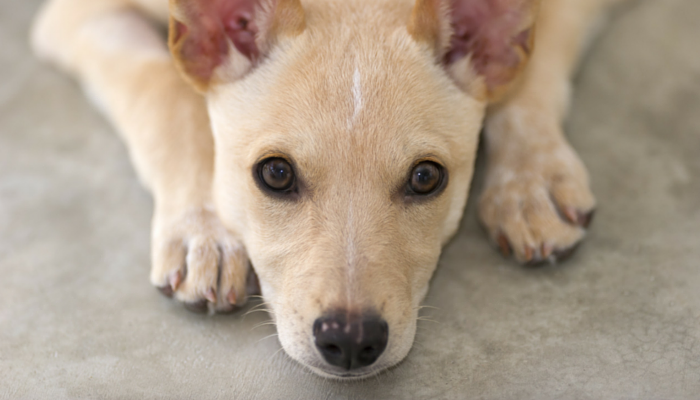
The “which hand” game with your dog is a great way to help your dog work on their problem solving skills.
Stuffed Kong
One of my favorite brain games for dogs is using a stuffed Kong. I love them because they’re a really simple way to keep my dog busy and mentally stimulated for a long period of time. You can put some treats in there to give your dog something to work for, or if you’re looking for something more challenging try freezing it overnight. If you’re not sure what to use check out our list of 39 healthy treats to stuff in a Kong .
Stuffed Kongs are fun and mentally stimulating for dogs. Kongs are great because they’re dishwasher safe (easy to clean) and pretty tough. We’ve had ours for years and my dog hasn’t been able to put a dent in it. If you’re not a fan of Kongs check out the West Paw Tux toy — it’s my favorite alternative (they are much smaller).
Using a stuffed Kong is also a great way to keep your dog busy while you’re at work. Put your stuffed Kong in the freezer overnight and give it to your dog in the morning as you’re leaving. A frozen Kong will last 30+ minutes for most dogs — much longer if it’s filled completely.
If you’re looking for a way to keep your dog busy and mentally stimulated with minimal effort you can’t go wrong with using a stuffed Kong.
The Shell Game
The shell game is another simple brain game for dogs. You’ve probably seen it before — it’s the game where a treat is hidden under one cup (or shell) and then shuffled around. The shell game will give your plenty of mental stimulation by giving them a chance to work on their problem solving skills.
How to play the shell game with your dog:
- Grab 3 cups and some treats
- Have your dog watch as you place a treat under one of the three cups
- Shuffle the cups around
- Encourage your dog to find the cup with the treat underneath
Hide & Seek
Playing a game of hide and seek is by far one of my dog Laika’s favorite games. It’s a fun interactive game you can play with your dog, and it’s mentally stimulating. If your dog doesn’t have a good stay command down you can ask a friend to help by having them distract your dog as you go and hide.
How to play hide and seek with your dog:
- Have your dog sit in a stay position (or enlist help if your dog keeps peeking)
- Find a hiding spot
- Call your dog
- Praise when they find you
Laika loves a game of hide and seek, and even though I keep picking the same 3 hiding spots over and over she doesn’t seem to mind. Hide and seek lets your dog use some of their natural scent tracking abilities in a fun and stimulating way.
Put Your Toys Away
I know what you’re thinking — putting things away is the opposite of fun, but hear me out for a minute. Teaching your dog something new such as putting their toys away is mentally stimulating. And if you teach them how to do it in a positive way you can make a fun game out of it.
If your dog’s toys are kept in a container you can teach them to put their toys away . I know it sounds weird to teach your dog to clean up after themselves, but it’s actually a lot of fun. Teaching your dog new skills boosts their confidence, and it’s a great way to give them more mental stimulation.
If your dog already knows “ drop it ” have them pick up a toy and give them their drop it command once they’re standing over the container. Praise them like crazy, then repeat. With some practice and consistently you’ll have a dog that knows how to clean up after himself, and best of all he’ll enjoy it.
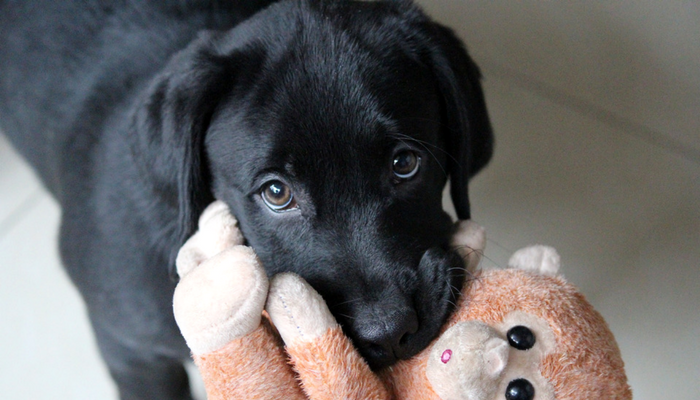
Dogs enjoy learning new skills (as long as you keep it positive), and teaching your dog new skills, such as putting their toys away, will boost their confidence and keep them mentally stimulated.
The (Toy) Name Game
Another fun brain game for dogs is the name game, and the best way to do it is by using your dog’s toys. Do you already have names for your dogs toys? If so you’re already ahead of the curve.
Start by playing with your dog and one specific toy, giving it a name while you do. After some practice & praise your dog will assign that verbal name with the chosen toy. Once your dog has learned that specific toys name you can test their skills by seeing if they can pick it out among their other toys. After your dog knows the name of one toy you can move on teaching them the name of another.
On average dogs can learn 165 different words , so your dog has the potential to learn the names of a lot of different toys. My dog knows the names of about 30 toys, and having her pick specific ones out of a pile is a great way to boost her problem solving skills. Chaser the Border Collie, an extraordinary example seen in the video below, knows the names of 1000+ toys.
Learning New Tricks
Learning new tricks isn’t the first thing you probably thought of when it comes to brain games for dogs, but they are be a fun way to challenge your dog’s mind (as long as you keep it positive). And teaching your dog new skills is a great way to boost your dog’s confidence.
Does your dog know how to weave through your legs and jump through a hoop? There’s always a new trick you can teach your dog. And teaching your dog how to weave through your legs is a lot easier than it sounds.
Here’s a list of 52 tricks with instructions that you can work on. Once your dog knows a bunch of tricks you can step it up a notch and combine those behaviors into new tricks .
What Are Your Dog’s Favorite Brain Games?
What are your favorite brain games for dogs? Do you play hide and seek with your dog? Does your dog enjoy a game of “find the treats?” Let me know in the comments below.
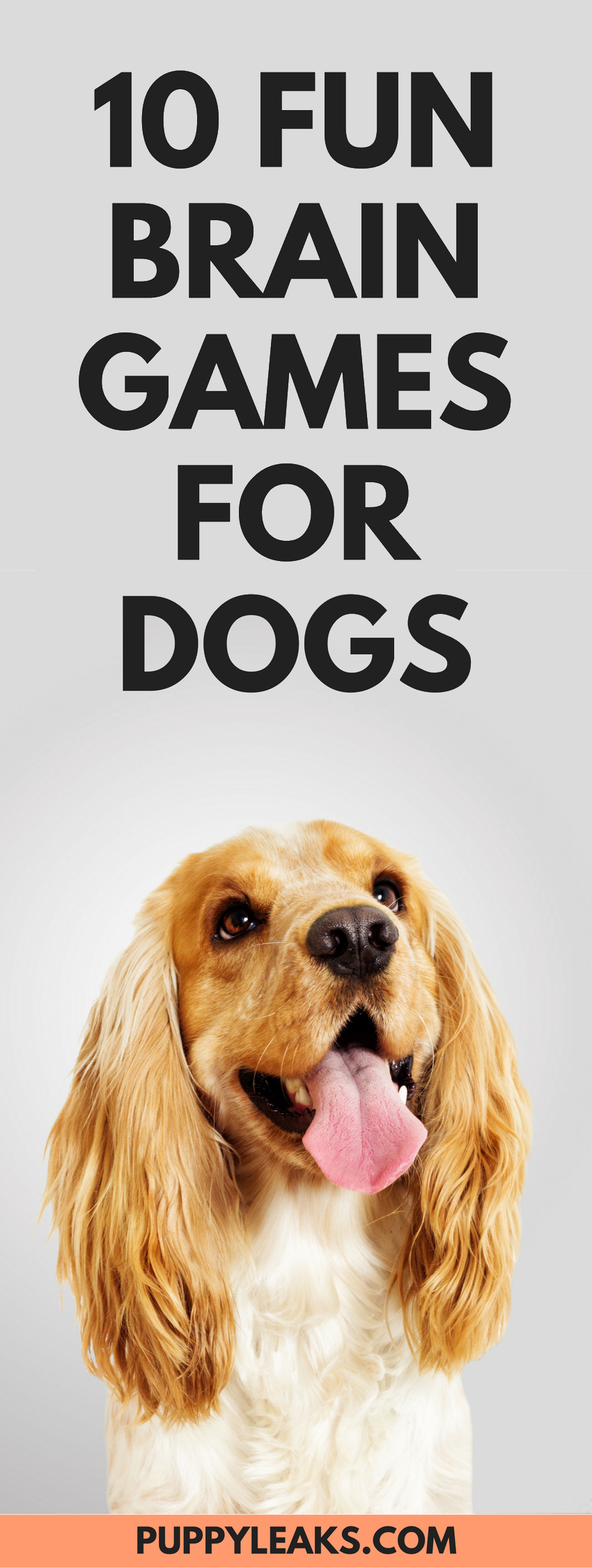
Please share with your friends 🙂
Recommended Reading:
November 24, 2017 at 2:25 am
I used to play hide and seek a lot with my dog – it was so cute to watch her look for me from my hiding spot – but then she learned my hiding spots so well she knew exactly where to look.
I like the other ideas in this post, as well, so I’ll have to try them!
November 25, 2017 at 12:42 am
This is a great post. I’ve bookmarked and pinned it for future reference.
We do a lot of these. But I want to try the shell game with Honey. I bet she’ll love it. And she loves pulling toys out of her bag. I’m looking for a hammock or bag that will be as easy for her to put her toys back into as it is to take them out.
November 15, 2018 at 4:34 pm
Thank you so very much for sharing all these ideas. TeddyBear is an “only dog” and I’m in charge of entertainment. We’re gonna love playing these games. Teddy and I have joined your site and are looking forward to the newsletter.
Thank you, thank you a million times thank you lol….Teddy and Jess
November 30, 2017 at 6:06 pm
Hide and seek when out in a forest, and Find the treats when at home are my two favorite games. The dog loves it!
December 26, 2017 at 9:09 am
It must be fun! Thank you for sharing! My dog also like hide and seek. Wanna try the Which Hand Game.
March 22, 2018 at 5:20 am
Thank you for sharing these interesting games. I have never thought the shell game to play with pets. Wanna try this game with my dog.
June 22, 2018 at 1:02 pm
Hi I am the proud owner of Happy the Corgi. We used to do most of the things mentioned in this great article n it brought me wonderful memories. You see, Happy has developed a brain tumor w seizures so intense it has caused my fur baby to go blind. It is inoperable. The good news is that it is Not cancerous. I would Love to see suggestions on how to modify these suggestions for Happy’s situation. Thank you n I really enjoy your articles
June 22, 2018 at 4:59 pm
I’m sorry to hear about Happy, though I am glad it’s not cancerous. Here’s a couple of decent articles that address playtime with blind or partially blind dogs: https://www.whole-dog-journal.com/issues/7_4/features/Blind-Dogs_5622-1.html & http://www.blinddogmilo.com/living-blind-dog/hints-and-tips/playing-with-your-blind-dog/
July 7, 2018 at 8:50 am
I just love playing hide & seek with my dog. Thank you for sharing this post with us.
October 29, 2018 at 6:18 pm
Interesting games. I think i should try these with my doggos.
October 4, 2019 at 9:13 pm
My dog knows a few toy names; however, when I introduced him to a game I bought in which he had to to turn cups over to get the treat, he closed down. Even though he could do one at a time, when I put the eight or so cups on the board and I showed him where the treats were, he became very upset and growled at the toy. He’s a very bright, intuitive boy, but I guess games are not for everyone.
December 28, 2019 at 1:06 am
We have a game we play that we call ‘put it here’. We hide 12 tennis balls in different rooms of the house, then we sit on a chair in the dining room holding a 12-spot muffin tin. The game is for the dog to find the balls and drop each of them into the 12 slots of the tin. He gets a treat for every tennis ball he finds and drops off into the muffin tin. After 2 rounds of this he is incredibly exhausted.
February 1, 2020 at 5:40 am
I like the shell game, I have tried it and it really works to help your dog with problem solving. I also like the food dispensing ball because it combines an amusing toy to play with and rewards for figuring out how the toy works. http://bit.ly/tumblerdispenser I also like the Brain Training For Dogs system used by Adrienne Farricelli. http://bit.ly/DOGbraintraining It combines multiple modules and 10 years of experience to help your dog develop healthy habits.
March 19, 2020 at 4:35 pm
These are great idea! Been looking for more things to do to keep myself busy during this pandemic, got to get the dogs involved!
August 10, 2020 at 11:55 pm
We did a gradual version of the cups game. First step: learn to turn over the cup to get the treat. Second step: two cups. Then three cups and so on. We’re up to five and that seems to be the cognitive limit, but we’ll see.
November 6, 2020 at 5:07 pm
I just love to playing hide & seek with my Labradoodle. Thank you for sharing this post with us. if you want more games then visit our Site
January 9, 2021 at 3:19 pm
I am going to try the cup game & hide and seek. Our Jagd Terrier loves to find treats rolled up in a towel – it keeps him occupied for at least a few minutes! Find it! is also a favourite – but I think I will now add the names of the toys to notch it up a bit. The other one we do is put 4 bits of kibble at the corners of a spaced-out square and a nice bit of cheese in the middle and then we ask him to take each corner one at a time and lastly the cheese in the middle. By the time it comes to the cheese he’s staring at it completely fixed on it! It takes a lot of self-control and that’s one of the lessons we are trying to teach this pup!
Leave a Reply Cancel reply
Your email address will not be published. Required fields are marked *
Notify me of follow-up comments by email.
Notify me of new posts by email.
This site uses Akismet to reduce spam. Learn how your comment data is processed .
Affiliate Disclosure
Puppy Leaks is a participant in the Amazon Services LLC Associates Program, an affiliate advertising program designed to provide a means for sites to earn advertising fees by advertising & linking to Amazon.com
- Dog Health & Care
- Dog Nutrition
- Dog Training
- Vet Approved
8 Brain Games for Dogs: Vet-Approved Fun & Stimulating Activities
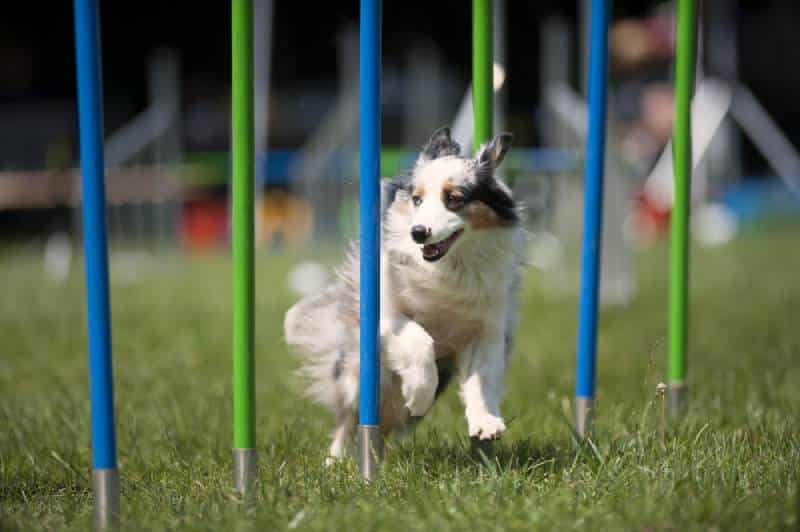
Image Credit: Flatka, Shutterstock
Last Updated on June 27, 2024 by Dogster Team
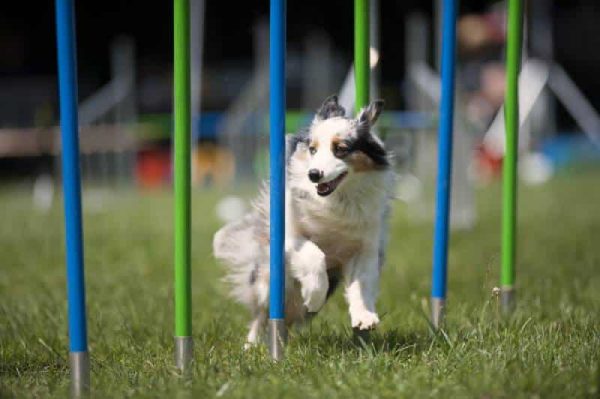
VET APPROVED
REVIEWED & FACT-CHECKED BY
Dr. Alice Athow-Frost
BVM BVS MRCVS (Veterinarian)
The information is current and up-to-date in accordance with the latest veterinarian research.
Dogs are not just those beloved friends that cheerfully join us on our daily walks; they are also brilliant companions who enjoy mentally stimulating games and thrive when playing them. As you might expect, a mentally stimulated pup is a happier and better-adjusted pup than those that are left to become bored. They also tend to exhibit fewer destructive behavior problems and enjoy a better overall quality of life.
With brain games, it doesn’t have to be complicated or expensive for dog owners to provide their pets with enjoyable ways to challenge their intellect, stave off boredom, and strengthen their bond. Read on for various brain games that will keep your four-legged friend sharp, entertained, and happy!

- The 8 Brain Games for Your Pup
- 1. Hide and Seek
This classic game engages your dog’s sense of smell and problem-solving skills. Start by hiding treats or toys (or yourself!) in various locations around your home or yard. Encourage your dog to find them by using verbal cues or simple commands. As your pup becomes proficient, you can increase the difficulty by hiding items in more challenging places.
- 2. Puzzle Feeders
Puzzle feeders are fun for turning mealtime or treat time into a mental workout! These devices dispense food in a way that requires your dog to figure out how to access it. Various types of puzzle feeders are available, from simple designs to more complex ones. These keep your dog entertained, slow down fast eaters, and provide mental stimulation as they work to retrieve their meals.
Pro Tip : If your dog is a little too smart and figures out how to solve the puzzle and get to the treats too quickly, pour a bit of water into each compartment where the food is. Then, place the feeder in your freezer until the water is frozen. Give the puzzle to your dog, and watch them lick the ice until they can finally release and gobble up the treats! This tip should only be used as a game, not to feed your dog their regular meals.
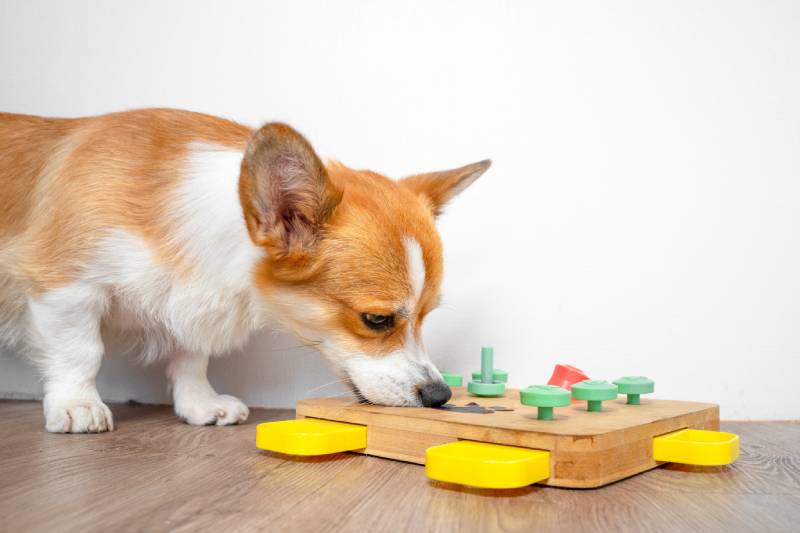
- 3. Interactive Toys
Interactive toys, such as treat-dispensing balls, are similar to puzzle feeders and designed to challenge your dog’s problem-solving abilities. They often have hidden compartments where treats can be placed, requiring your dog to manipulate the toy to access the rewards. Make sure to choose products that are appropriate for your dog’s size and skill level, to ensure that they remain engaged without becoming frustrated.
- 4. Tug of War With a Twist
Traditional tug of war is a great physical workout, but adding a twist turns it into a brain game. Introduce various rules, such as only releasing the toy on command or waiting for your signal to start playing. This adds an extra layer of mental engagement as your dog learns to follow instructions while enjoying a spirited game.
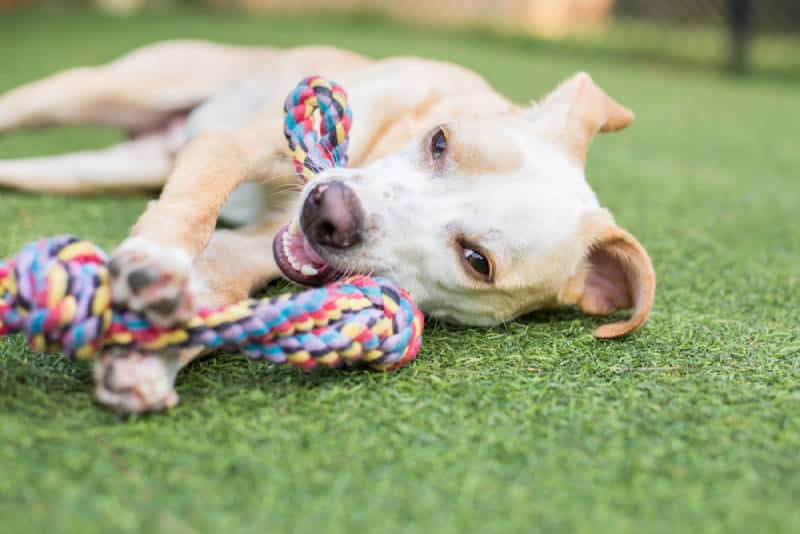
- 5. Name That Toy
Most dogs are perfectly capable of learning and recognizing names for various objects. To play “Name That Toy,” start by selecting a few of your pup’s favorite plushies. Place them in a row, and using consistent verbal cues, ask your dog to bring you a specific toy. Reward them with praise and treats when they choose the correct one. This game will help sharpen their memory and reinforce communication between you and your furry pal.
- 6. DIY Obstacle Course
Create an obstacle course using household items in your backyard or living space. Set up hurdles, tunnels made from blankets or cushions, and weaving poles. Help your dog get through the course using treats and positive reinforcement. This game is a great way to squeeze more exercise into your pup’s day while also challenging their coordination and problem-solving skills.
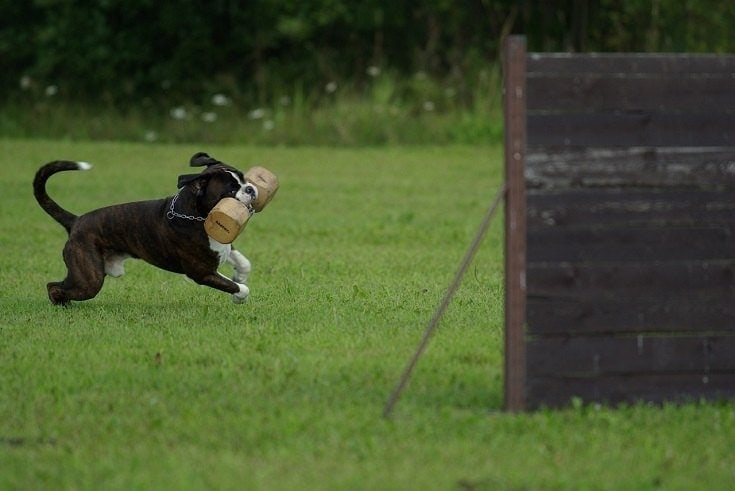
- 7. Peanut Butter in a Kong
Turn a Kong toy into a yummy stimulating activity by stuffing it with peanut butter (or if you prefer, a mixture of wet dog food and treats), then freezing it. The challenge for your dog is to figure out how to extract the frozen goodies. This occupies their time and provides a refreshing delight, especially on warm days.
Side Note : In case you’re wondering, yes, it’s safe for healthy dogs to have one or two teaspoons of peanut butter a day. Just make sure it doesn’t contain xylitol, as that is extremely toxic to dogs.
- 8. Scent Trail
Tap into your dog’s extraordinary sense of smell by creating a scent trail for them to follow. Begin by rubbing a treat or toy against the ground to leave a specific scent. Gradually increase the difficulty by making the trail longer or incorporating turns.
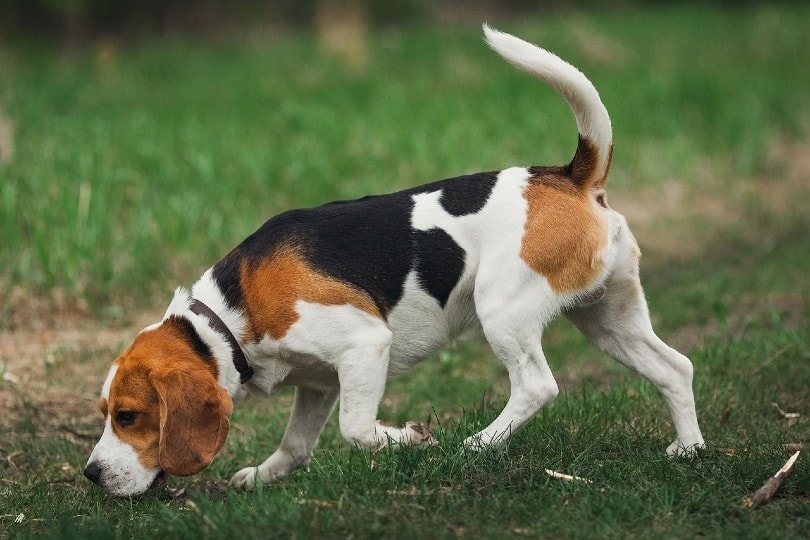
- Why Does Mental Stimulation Matter?
Dogs, especially those with high intelligence levels , can easily become bored when their minds are not adequately engaged. Boredom often leads to destructive behaviors, such as chewing furniture, excessive barking, and digging. Mental stimulation helps redirect this energy into positive activities, reducing the likelihood of destructive behaviors and promoting a calm demeanor. 3
Also, just like humans, our loyal four-legged friends benefit from solving problems. Brain games challenge them to think, plan, and execute strategies to reach a goal. Engaging in activities that require problem-solving skills helps them develop their cognitive abilities and keep their minds sharp as they age.
Mental stimulation is about not only challenging your pet’s intellect but also providing a positive outlet for excess energy . Indeed, dogs that lack mental stimulation may experience heightened stress and anxiety levels, which can negatively impact their overall well-being.
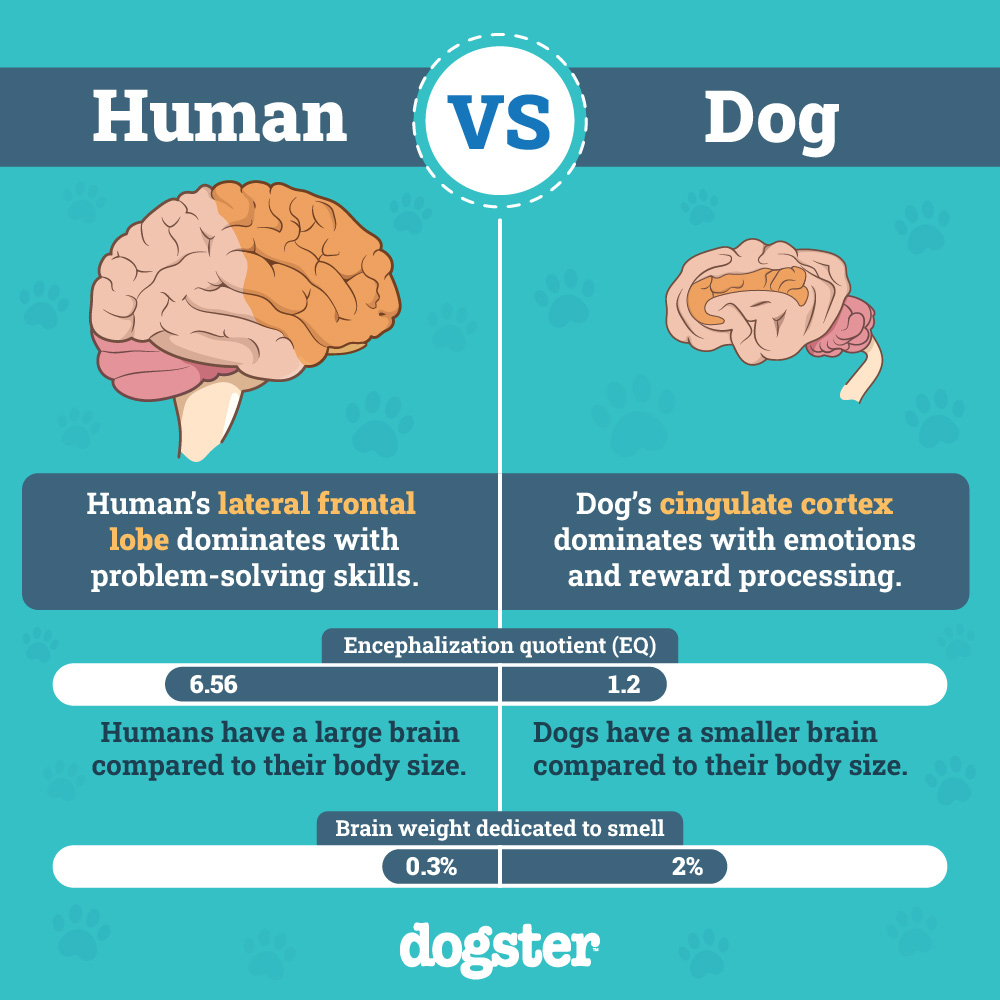
Incorporating brain games into your dog’s routine is a win-win for both of you. These activities provide essential mental stimulation and strengthen the bond between you and your lovely and smart pup. That said, choosing games appropriate for your dog’s size, age, and skill level is crucial to ensure a sufficiently challenging experience. After all, you’ll want to make sure your canine doesn’t figure out the scheme in just 2 minutes!
- See also: Dog Friendly Activities in Detroit
- https://www.akc.org/expert-advice/lifestyle/do-it-yourself-cognitive-dog-toys-for-home/
- https://www.petmd.com/dog/general-health/smartest-dog-breeds
- https://www.petmd.com/dog/nutrition/can-dogs-eat-peanut-butter
- https://www.petmd.com/dog/conditions/endocrine/c_dg_xylitol_toxicity
- https://www.ncbi.nlm.nih.gov/pmc/articles/PMC8388720/
Featured Image Credit: Flatka, Shutterstock
How useful was this post?
Click on a star to rate (you can leave written feedback after clicking submit)
Help us improve Dogster for pet parents!
Your feedback really matters.
What did you like about this post? Also how can we improve it?
About the Author
Genevieve Dugal
A biologist and science writer, Genevieve has a special fondness for capuchin monkeys, pumas, and kangaroos, which has inspired her to volunteer and work at wildlife rehabilitation centers in countries like Bolivia, Guatemala, Canada, and Australia. Now living as a Canadian expat in Argentina, she enjoys the sight of horses and cows outside her home office window every morning. Genevieve is the proud owner of three r rescue dogs —Lemmy, Nala, and Pochi—and a lively kitten named Furiosa. She finds happiness and fulfillment in sharing her passion and extensive knowledge of animals with others.
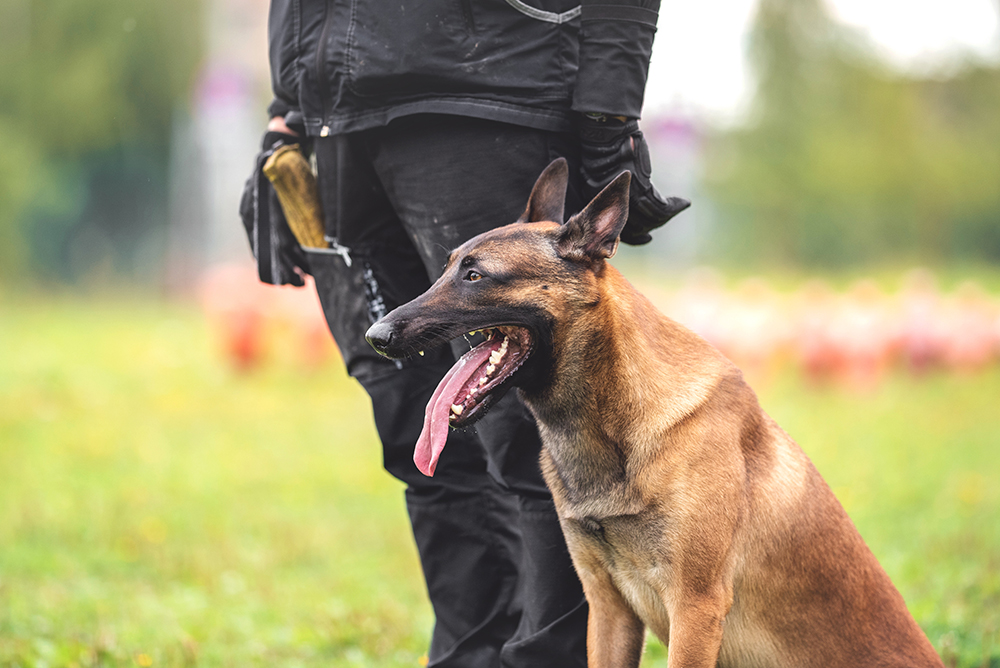
Why Are Police Dogs Called K9? History & Facts
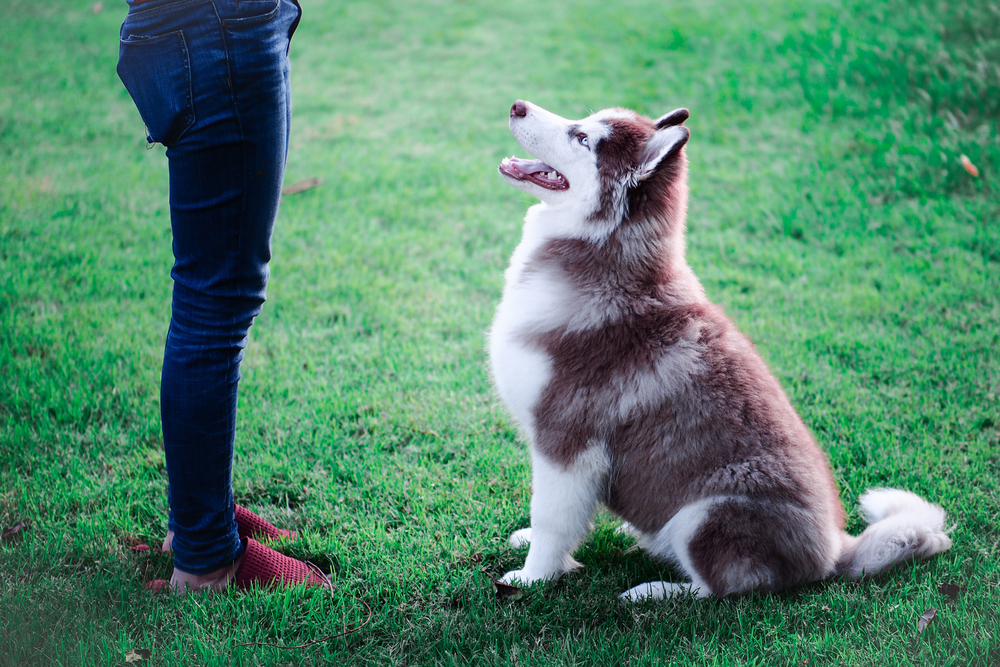
4 Dog Training Rituals: Vet-Approved Tips to Help Your Pup Learn

How to Train a Newfoundland Dog: 11 Vet-Recommended Tips
Leave a reply cancel reply.
You’re very welcome to leave a comment or question. Please know that all comments must meet our community guidelines, and your email address will NOT be published. Let’s have a positive and constructive conversation.

Get Dogster in your inbox!

The Great Debate Part Two: Why Dogs Are Better Than Cats
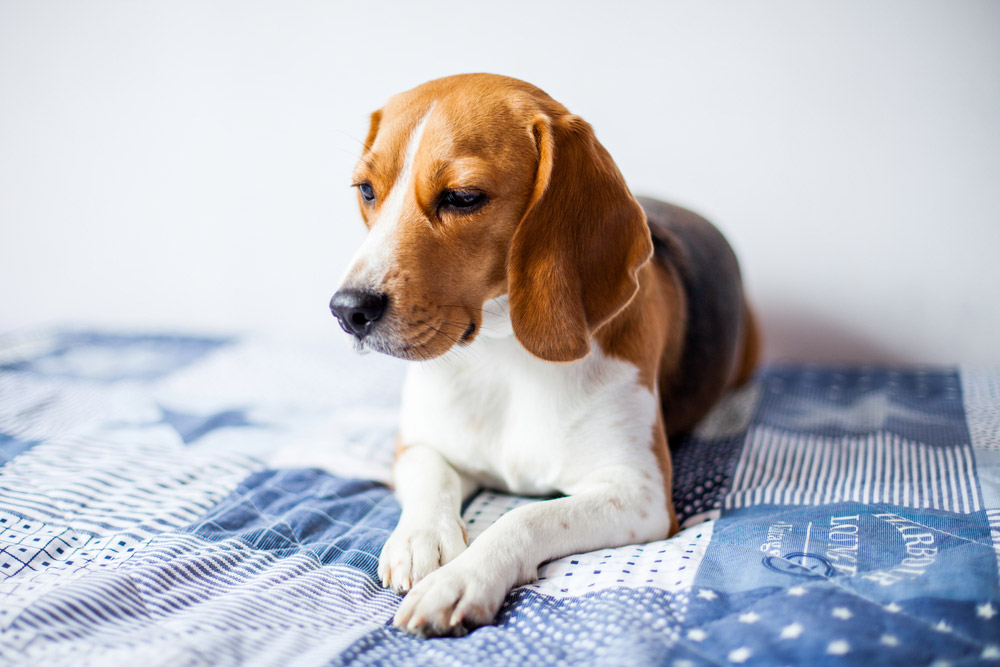
High Cholesterol in Dogs: Our Vet Discusses Signs, Causes & Treatments

Can Dogs Eat Brown Sugar? Vet-Verified Nutrition Facts & Considerations
© pangolia pte. ltd. all rights reserved..


Brain Games For Dogs: How To Keep Your Pup Mentally Stimulated (And Behaved)
Last Updated: May 1, 2024 | 7 min read | 2 Comments
When you purchase through links on our site, we may earn a commission. Here’s how it works .
- Pinterest 11
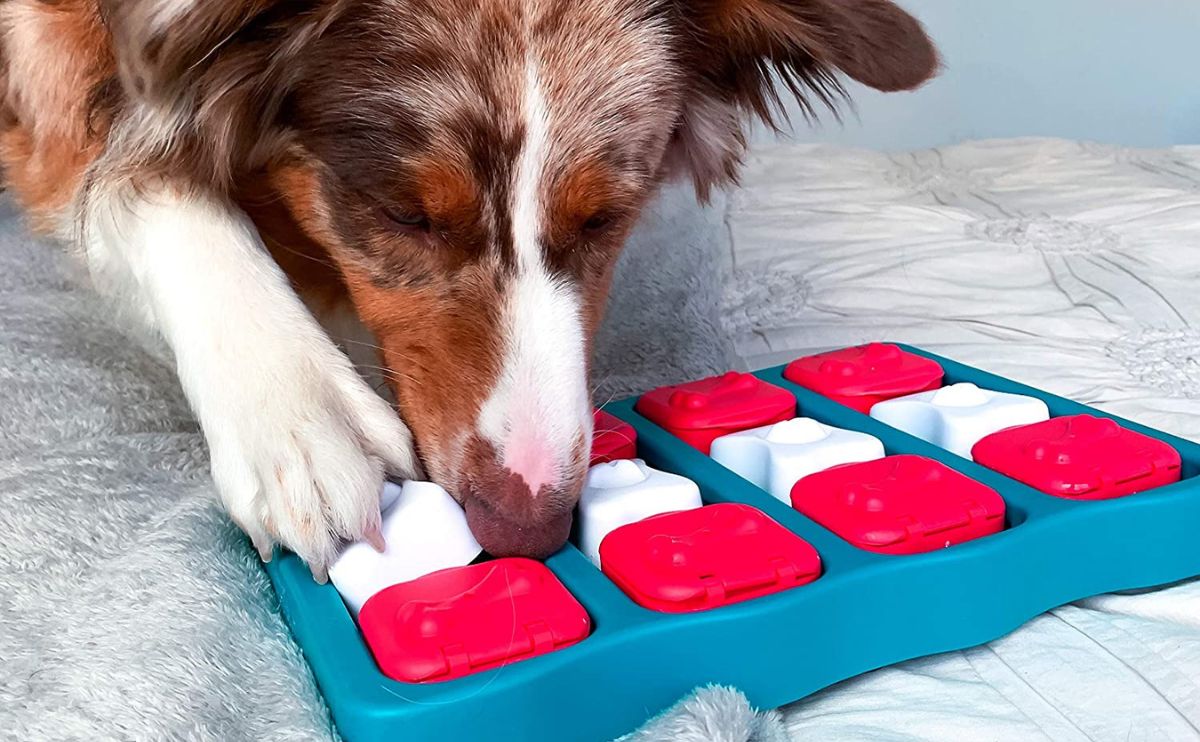
Many dogs were bred for specific jobs, like retrieving, tracking, herding, and guarding. These various instincts have become innate, but today, many dogs don’t satisfy these instincts in their daily lives, becoming bored. Bored dogs can exhibit bad or even destructive behavior.
Does this sound like your furry friend? If so, I’ll give you some ideas to keep your pup mentally stimulated and happy. Learn more about brain games for dogs and how to keep your dog mentally active.
Table of Contents
Why Do Dogs Need Brain Training?
Brain games are a great way to keep your dog well-trained and mentally stimulated . But before we give you specific game ideas, we want to point out that training your dog is an essential part of setting him up for mental and behavioral success.
Training your dog’s brain to behave appropriately in all kinds of situations can help keep them mentally alert. How? Because you’re teaching him skills that your dog can remember and use all the time. It’s also a great way to bond with your pup.
Brain Training For Dogs Course
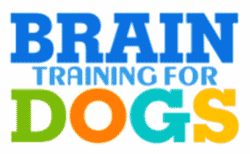
Brain Training For Dogs is an excellent online course that teaches you how to brain-train your dog from puppyhood into adulthood. Adrienne Farricelli, a professional CPDT-KA certified dog trainer, developed this force-free training program that uses positive reinforcement . Many of the topics covered involve correcting bad behavior (excessive barking, jumping, leash pulling, biting, etc.), no matter how ingrained it may be in your dog.
The course teaches you specially designed techniques and games that engage your dog on a higher mental level than methods many other trainers use. Farricelli believes that mental stimulation is vital to correcting bad behavior — and boosting what she calls your dog’s “natural intelligence.”
8 Best Brain Games For Dogs
All dogs need regular physical exercise and interactive play, like fetch , tug-of-war, etc. However, many dogs need more. Here are some of the best mental stimulation games for dogs that we’ve found. Some are easy DIY games, and others are affordable interactive dog toys.
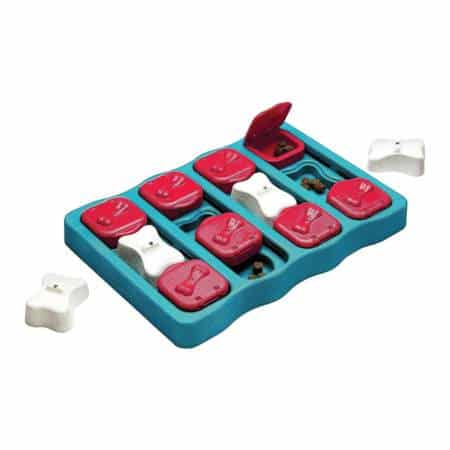
There are many dog talking buttons and puzzle games that you can find online or at your pet store. They come in various degrees of difficulty, but most involve your dog figuring out how to get to a hidden treat. Nina Ottoson by Outward Hound’s Dog Brick Puzzle is a popular intermediate-level option for interactive dog toys.
If you want something more advanced, Trixie Pet Products has a fun and challenging flip-board puzzle that will offer plenty of mental stimulation and keep your pup occupied while working on getting to his treats.
Benefits Of Puzzles
Puzzle games help dogs build memory and boost their logic and problem-solving skills. Just like us, dogs need a mental challenge . Making your pup do a brain workout for about 15 minutes is equal to approximately 30 minutes of physical activity. Making them concentrate uses a lot of energy and makes them tired. Mental work like solving puzzles helps relieve stress and anxiety in dogs. Puzzles can be beneficial in working out destructive behaviors and decreasing hyperactivity.
See how our very own Barley loves his puzzles (and treats).
2. Treat-Dispensing Toys
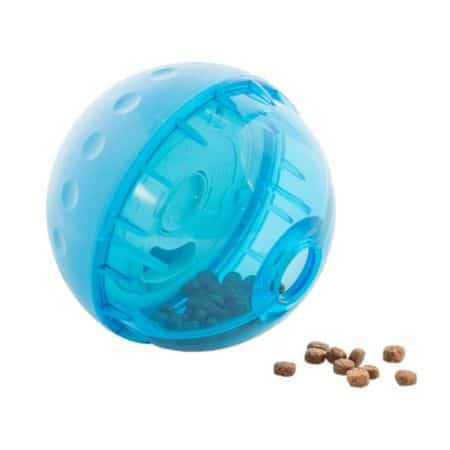
Another fun brain game is a treat-dispensing toy, like OurPets IQ Treat Ball, that can keep your dog mentally stimulated for an extended period of time. The OurPets interactive treat-dispensing toy is available in 3 and 4-inch sizes, and you can adjust the level of difficulty as your dog learns how to get treats faster. See more interactive dog toys .
Our Personal Experience With OurPets IQ Treat Ball
This toy keeps our puppy occupied for hours. And, when Barley stops playing with it, he falls asleep!! It is also impossible for him to chew, which means this toy will thankfully last much longer than most in our home. – Michelle Schenker , Rescue pup parent and website co-founder
Read more about this and other toys we love
3. Stuffed Kong
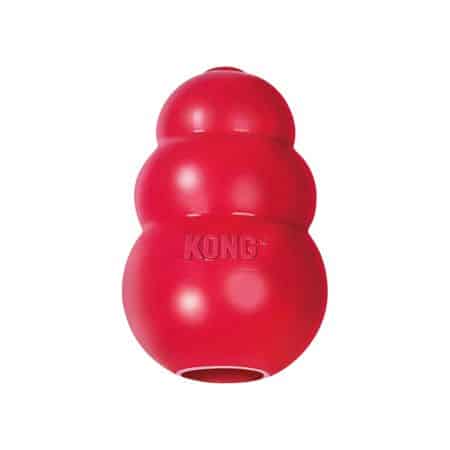
A stuffed Kong is an excellent way to keep your dog mentally stimulated and occupied for a long time. You can load it with treats or peanut butter — and for an even greater challenge, freeze the peanut butter-stuffed Kong overnight. Your dog will enjoy working for his treat.
You can even turn this into a game by playing a treasure hunt . Show your dog the stuffed Kong, and then tell him to sit and stay while you hide it. Then, release him to go sniff out the treasured prize.
Our Personal Experience With Kong Dog Toys
I have used the classic Kong chew toys with my dogs for over 20 years. These toys are fantastic for super chewers. I have always had large dogs, Labrador mixes, who love to chew. These keep them entertained for hours on end and last for a very long time. They have literally saved my furniture from getting destroyed, and my dogs love them. – Danielle DeGroot , Labrador Retriever parent and website writer
See our reviews of popular Kong toys
4. The Cup Game
This is the dog version of the old hustling cup game. It can help your dog develop problem-solving skills and is a great interactive game for you and your pup to do together.
- Get three plastic cups and some yummy-smelling treats
- Line up the cups on the floor
- Have your dog watch you as you place a treat under one of the cups
- Shuffle the cups around
- Give your dog the treat when he picks the right cup
In puppies, fun brain games like this help boost brain development and strengthen their bond with their owners. At any age, positive feedback boosts a dog’s confidence and further secures the connection you have. Mental games for dogs are fun for them and you.
5. Hide-And-Seek
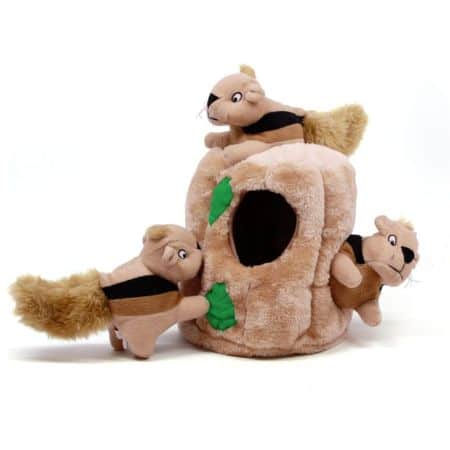
Yes, it’s a game you usually play with kids, but your dog can enjoy a good old game of hide-and-seek , too. And it’s yet another game that lets you interact with your dog. If your dog hasn’t mastered the stay command, you can ask a family member or friend to help by having them distract your dog when you go and hide. Be sure to praise your pup when he finds you so he knows he’s mastered the end result.
For a different version of hide-and-seek , you may also want to try out this Outward Hound Hide-A-Squirrel dog toy. You hide the plush squirrels in the trunk, and your dog is challenged to nuzzle them out. The squirrels have hidden squeakers for added fun.
Our Personal Experience With Outward Hound Hide-A-Squirrel Dog Toy
This is my dog Daisy’s favorite toy. She has had several of these and will take care of the little squirrels for months. Eventually, she tears them up, and we get a new one. This is a perfect toy for her because she loves hiding things and then finding them. We will hide the squirrels themselves all over the yard, and she will search them out. -Danielle DeGroot, Labrador Retriever parent
6. The Name Game
Your dog has likely caught on to everyday terms like “walk,” toy,” and “treat.” But it’s mentally stimulating for him to learn different names for each toy (or person in your home). He’ll have fun learning the terms for each object or person and then seeking them out when you ask him to.
7. Put Your Toys Away
Like the Name Game, this is another fun training game. You can teach your dog to pick up his toys and place them in a container. Tell your dog to “get your toy” or “retrieve,” and then show him where to take them. Once he’s at the toy box, you say, “Drop it.” It may take some time for him to learn what you’re expecting, but training dogs with new skills boosts their confidence and keeps them mentally stimulated.
8. Obstacle Course
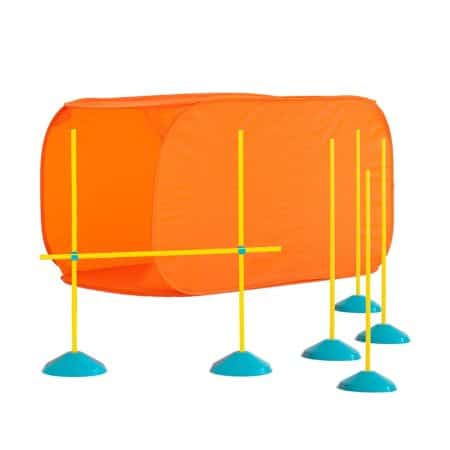
Training your dog to go through an obstacle course is a great mental workout. This can be a DIY dog brain game where you arrange some chairs, tables, blankets, toys, etc., and create your own obstacle course. Or, if you want to go all out, you can purchase some agility equipment for your yard.
Outward Hound has an affordable ZipZoom Beginner Dog Agility Training Obstacle Course that includes an adjustable jump, weaving poles, and a tunnel. For a greater challenge, you may want to check out this PawHut Agility Training kit . It comes with an adjustable high jump, tunnel, weave poles, a square pause box, and an adjustable jumping ring.
Homemade Dog Brain Games (Video)
Watch this brief video for a few additional DIY dog brain games you can create with everyday household items.
Make Your Own DIY Dog Games & Puzzles
Not all dog games and brain puzzles need to be bought. With a little time and a few supplies, you can quickly make fun brain games and interactive dog toys at home for your pup.
DIY Dog Puzzle
You can make a DIY dog puzzle if you have a muffin pan, dog treats, and a few toys. You can substitute an egg carton if you don’t have a muffin tin. Hide a few treats in the muffin cups, then cover them with a toy, balled-up paper, or other items. Your pup must sniff through and play with each toy as they seek the treats. You can make a DIY food puzzle the same way. Simply fill up the muffin cups or egg cartons with kibble, then cover the top with cardboard or other items.
A fun and easy interactive dog toy you can try is to make a dig box for your pup. Find an old bin or cardboard box. Sprinkle a few treats at the bottom. Then, cover them with shredded bits of paper such as recycling, old newspapers, ads, etc.
Frozen Treats
Some dogs love frozen treats, like ice cubes or snowballs. Freezing up some tasty bone broth is another way to incorporate a frozen treat into play. You can add these to a food puzzle or toys like the Kong . Hide them around the yard for your pup to find in a scavenger hunt.
DIY Doggie Ramp
You can use a board and a rolled-up towel or blanket to create a doggie see-saw type of ramp . It will not be a huge incline, but dogs love it when it moves. You can add a ball or treat at the other end of the ramp to make it even more fun.
Cardboard Box Maze
Creating a maze out of everyday household items and cardboard boxes can provide tons of fun for your pup. Add treats and toys behind different turns. Create a cozy spot inside for your dog to lay down with a soft blanket. Your pup can spend hours in the maze, and you can easily add new twists and turns. These are also easy to clean up and recycle when you are done.
Don’t Forget To Stock Up On Dog Treats
You want to make sure you have plenty of dog treats when you’re training your dog or using some of these brain game ideas. Dogs are motivated by these tasty rewards, but not all treats are the healthiest options. You may want to consider vegan dog treats or calming treats if you have a highly energetic pup. See the best treats to reward your dog for some of our top recommendations.
Why Trust Canine Journal?
Sally has over 10 years of experience researching and testing hundreds of pet toys, accessories, and other methods to keep our four-legged friends mentally and physically stimulated. She’s part of a team of dedicated canine professionals who are committed to the health and well-being not only of our own pups but of all of our readers’ furry friends.
The information provided through this website should not be used to diagnose or treat a health problem or disease; it is not intended to offer any legal opinion or advice or a substitute for professional safety advice or professional care. Please consult your health care provider, attorney, or product manual for professional advice. Products and services reviewed are provided by third parties; we are not responsible in any way for them, nor do we guarantee their functionality, utility, safety, or reliability. Our content is for educational purposes only.
More From Training

DIYK9 Review: Are These Dog Training Courses Effective And Worth Your Money?

K9 Training Institute Reviews: Is It Legit & How Much Does It Cost?

How To Bell Train A Dog & Best Bells For Training Dogs
Puppy behavior: Five tips from a vet for solving problems
Start your puppy off on the right paw with these five puppy behavior tips
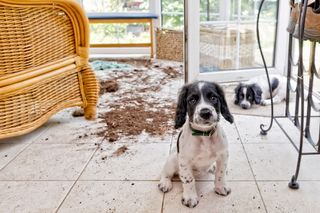
Puppy training is one of the most important tasks you’ll take on as a new pet owner. New puppies are super fun, but they can also be a handful! If this is your first puppy, or it has been a while since your last one, you may not realize just how much work training a young dog can be.
Fortunately, most puppy behavioral problems can be solved if you address them early. However, it’s important to make sure you’re addressing behavior problems the right way.
Punishment-based training methods – like yelling, hitting, spraying with water, or 'alpha rolls' – are scary for your puppy, and may cause more behavioral problems in the future. Instead, check out these tips for using positive reinforcement training to address some of the most common puppy behavior concerns.
- Best puppy food : Make sure your new dog grows up strong and healthy
1. Whining and barking while in their crate
No one wants to be locked up away from their family! It will take some time for your puppy to get used to being in the crate, but you can help by teaching your puppy to view the crate as a safe and comfortable resting place.
Make sure you’re providing your puppy with a comfortable bed in the crate and using lots of positive reinforcement during training. Feeding your puppy in the crate or providing a special puzzle toy to keep her busy are great ways to encourage quiet behavior when crated.
The biggest mistake pet parents make is letting the puppy out of the crate when she is whining. Unfortunately, this only teaches the puppy that whining and barking will get her what she wants! Never let your puppy out of the crate or give her any attention when she is whining or barking while crated. Remember that even negative attention – like yelling or startling the puppy – is still attention, and may reinforce this nuisance behavior! Instead, ignore the puppy until she is calm and quiet. You can reward calm behavior by occasionally dropping some of the best puppy treats into the crate for her, which reinforces that the crate is a fun place to be!
2. Urinating and/or defecating in the crate
Accidents in the crate are another common problem that pet parents encounter during crate training and potty training. Often, this occurs because the crate is too large for your puppy. While it may be tempting to purchase a larger crate to fit your puppy’s expected adult size, a crate that is too large will allow your puppy to urinate and defecate in one area and sleep in another, which may encourage soiling.
A properly sized crate should be just big enough for your puppy to stand up to her full height and turn around in a circle. If your current crate is too large, purchase a smaller one until your puppy reaches her adult size or use a solid barrier such as pieces of cardboard to help section off part of it while your puppy grows into it.
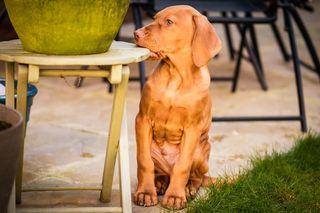
3. Inappropriate or destructive chewing behavior
Puppies will start teething as their adult teeth begin to erupt, much in the same way that human children do. Just as human children need teething rings and other toys to help relieve the discomfort associated with these new teeth, puppies will also look for things to chew to ease their pain – and this often includes your furniture!
Puppies also naturally like to explore the world through their mouths, which may be a contributory factor to this destructive behavior. Some puppies will outgrow inappropriate chewing behavior, but it’s still best to curb this behavior as quickly as possible.
Make sure you provide your puppy with plenty of the best dog chew toys of varying shapes, sizes, and textures. When your puppy tries to chew the furniture, redirect her onto a more appropriate object, and reward her with plenty of praise and treats to encourage her to continue chewing the right toys.
You can also use deterrents such as bitter apple spray or even hot sauce applied to the inappropriate surfaces she likes to chew, such as your furniture – just be careful not to apply them to upholstery, which may stain, and never spray them on your dog or around her face.
4. Jumping up on people
Does your puppy get so excited at meeting new people that she just can’t control herself? You can help curb this behavior by teaching her to keep 'four on the floor' when greeting new people. To start, you’ll need to get your friends and family on board with this training – consistency is the key to making any training plan a success! You’ll need to make sure your friends and family don’t inadvertently encourage the behavior by petting or talking to your puppy while she is jumping on them. Even pushing your puppy away may be seen as part of the game and may encourage her to continue jumping. Instead, they should calmly turn and walk away when she jumps so that she will learn she cannot get anyone’s attention this way.
When a new person is approaching, ask your puppy to sit and stay. You may need to start at quite a distance at first if your puppy is too excited to listen. Once she is sitting and calm, reward her with a treat, and allow the person to calmly approach and say hello. If the interaction is going well and your puppy is staying calm, they can even offer her a few treats as a reward for this good behavior. If your puppy tries to jump, simply turn and lead and lead her away – she has lost her opportunity to greet that person today! With patience and repetition she will soon learn that she needs to sit politely and keep 'four on the floor' if she wants to say hello.
5. Nipping and inappropriate play behavior
Pet owners often worry that their dog is becoming aggressive when they start biting at a young age. But in a young puppy, this is often inappropriate play behavior. Puppies frequently nip at moving hands or legs in an effort to initiate play. To stop this behavior, it’s important to avoid sending mixed signals. Never play with your puppy using your hands or body – including wrestling or rough housing – as this can teach them to use you as a chew toy! Instead, try to redirect them onto a more appropriate toy. If they continue trying to nip, put your hands behind your back until they settle down or get up and walk away. With patience and consistency, they'll learn that play time stops if they get too rough. Never hit your puppy, grab them by the muzzle, or use other punishments, as these responses may cause fear and worsen aggression in the future.
Patience, consistency, and positive reinforcement
Whether you’re addressing an unwanted behavior or teaching a new trick, being clear and consistent with your training is the key. Always use positive reinforcement by rewarding desirable behaviors with a good experience, such as praise, petting, or a tasty treat. Using this method consistently will teach your puppy that good behavior is far more fun and rewarding than causing trouble.
PetsRadar Newsletter
Get the best advice, tips and top tech for your beloved Pets
Dr. Elizabeth Racine is a small animal general practice vet covering all things pet health and wellness. Her special interests include veterinary behavior, nutrition, and internal medicine. As a freelance writer, Dr. Racine has written content for major companies in the industry such as the American Kennel Club, Merck Animal Health, Bayer PetBasics, Elanco, and CareCredit. In her free time, Dr. Racine enjoys playing trampoline dodgeball, hiking with her beagle Dasher, and spending time with her three mischievous cats.
Why does my dog walk sideways? A vet explains
Got a reactive dog? Here's how to make walk time less stressful, according to a trainer
Planning on moving house? Vet shares six tips to help prepare your dog for the big day
Most Popular
- 2 32 things rabbits shouldn't eat
- 3 How to make bird suet in 8 simple steps
- 4 Leading animal charity issues warnings over new “bullycat” breed
- 5 32 tips for taking care of rabbits

- Learn more about how Purina and Zigzag are making a difference together
- How it works
- What we stand for
- Our Founders
- Endorsements
- Toilet Training
- Crate Training
- Breed Specific
- Training Basics

Getting your puppy
Schedule by time, schedule by breed.

View All Breed Schedules
Puppy training, puppy behavior, puppy health, view all articles.

Puppy Adolescence – Accessories to Help Your Teenage Pup
Introducing a puppy to a reactive dog, puppy adolescence – understanding your teenage puppy, puppy adolescence – training your teenage puppy, how to teach your puppy “place” , positive reinforcement puppy training: what does it mean, vegetarian dog food: should i feed vegetarian food to my puppy, wet vs dry dog food: what should i feed my puppy.

50+ Fun Puppy Training Games for Any Scenario

By Zigzag Training Coach, Petrina Firth
Fully Qualified COAPE Behaviourist and Registered Training Instructor with The Animal Behaviour and Training Council
- Post Date: April 23, 2021
- (Date Last Modified: March 30, 2023)
In this article:
Puppies have so much energy!
Which means that dog training games are a great way to teach them anything.
But on the other hand…
Some dog breeds are also so smart and high-energy that they will outsmart you in any game if you keep playing the same games.
That’s why we created this list of 50+ games to play with your dog, for some extra inspiration for your next play session.
Obedience/Recall Games
Why should i play recall dog training games.
One of the most joyful things is to have your dog running back to you with glee!
You don’t want it to be the opposite…and find yourself screaming after your dog at the park. It’s only a matter of time until you encounter a person that’s actually called Alfie, and replies to your screams with a loud ‘WHAT?!”
These recall dog training games will help you get the walks in the parks and thrilling games of fetch you’ve always dreamed of. It all comes down to teaching them to come back!
PRO TIP: If your recall is a little…err patchy, use a long recall line like this one , or start the games off indoors to keep your dog safe while you play.
Okay, okay! We know you’re ready to play, here we go!
Chase Recall
Where: Outdoor
Purpose: Obedience/Recall
Suitable for: Puppies (<1 year) / Dogs (1 – 6 years) / Older Dogs (>6 years)
Game description::
Up the level of your recall, and play chase with your dog. Dogs are naturally excited when they see fast movement, and it’s even better when it involves us – so let’s have them running towards us full of joy!
How to play:
- Have your treat pouch stuffed some super yummy treats
- Say ‘come’ in a nice happy voice, and take a few step backwards
- Repeat 5 times
- Start running back further so your puppy has to cover more distance to get to you each time
- Repeat this 5 times
- As you’re running backwards, turn your back on your dog and keep on running (forwards though…don’t start running backwards towards your dog. You’ll look awks).
- Don’t forget to reward when they get to you!
- Now, try adding a ‘sit’ at the end of the recall – it’ll help stop your dog playing ‘keep away’ and it looks flashy!
Make the game even more fun: Try adding a ‘wait’ cue so you can get further away before you call your dog.
Problems you might run into: Tripping – no not like the Summer of Love, . make sure the area is clear so you don’t run into people!
If your dog likes this, you might also like: Hide and Seek
Play Tennis with Your Puppy
You are gonna have a ball with this one (pun intended). Playing tennis with your dog doesn’t mean they’ll literally whack a tennis ball with a racket – it will be more of them embracing the role of the ball, and them running between you and a friend. The point is to teach them to respond to everyone; strengthening their recall in the end. Plus, they get lots of yummy treats, can’t get any more fun than that!
How to play:
- Give treats to each of your friends or family members and spread out in a triangle/square
- Have one person call your puppy.
- When your puppy gets to them, they’ll need rewarding.
- Then, the next person calls them and rewards them when they get to them.
- There you have it – a puppy ping ponging between people for treats!
- Slowly spread out so your puppy has to run further for goodies.
Make the game even more fun: Make the recalls unpredictable so your puppy doesn’t always know who or when they will be called next.
Problems you might run into: If your dog is going too fast towards people, they can make them sit at the end to slow things down.
If your dog likes this, you might also like: Try the same game with toys as a reward…see how they like the change.
The Name-Game
Where: Indoor/Outdoor
Game description:
Teaching your dog their name is probably the most important thing you’ll have to do…so why not have fun with it?When you call your dog’s name you want a quick fast head turn from them – we call it a switch back in dog training. Kind of like you do when an ice cream van starts playing their tune.
This dog training game is also great for getting some excess energy off dogs and puppies when the weather is terrible. In the UK, we all know this is kind of standard.
- Load your treat pouch up with yummy treats.
- Throw a treat on the floor to take your dog away from you.
- Just as they’ve finished their treat, say their name in a clear happy voice.
- When they turn to look at you, say ‘good’ and then throw a treat the opposite way.
- Keep repeating this by throwing the treat across your body the opposite way.
Make the game even more fun – Start throwing the treat in unpredictable ways – toss it over your shoulder, bowl it down the hallway, chuck it between your legs…the possibilities are endless.
Problems you might run into: If you’re playing outside, distractions may make it difficult to play, so practice this game inside first.
If your dog likes this, you might also like: Hand Target.
Hide and Seek puppy training game
Suitable for Puppies (<1 year) / Dogs (1 – 6 years) / Older Dogs (>6 years)
Game description:
This is a great game to play with children, and is fantastic for working on your dog’s searching skills (good practice for when you want them to find your keys for you). Your dog will love to search for you (and your keys someday); especially when they know they’ll get a great reward. Start off indoors and nice and easy before moving outside so your dog has a good hang of the game.
- Load everyone up with some yummy treats – you’ll probably want to call some friends for this game.
- Hold your puppy in the room while someone disappears just outside.
- Have them call your puppy and reward them when they find them – clever dog!
- Now, get them to hide in the next room and call them.
- Hide further and further away all around the house.
- Now, outside try hiding behind trees or bushes. Did they find you? Yay!
Make the game even more fun: Switch out the treats for a toy and see if your puppy still wants to play when they get to the other person.
Problems you might run into: Don’t make it too difficult too early on as your dog might lose interest if they can’t find the person. Remember when they forgot about you when you played hide and seek in primary school? Wouldn’t want to relive that.
If your dog likes this, you might also like: Try find the toy game
‘Hand Target’ training games for dogs
Teaching your dog to hand target is great for building a very visual recall – it’s also useful for teaching them tricks, which we know you’re very excited about getting into. Dogs enjoy this game because it doesn’t have to mean ‘I recall and the lead goes on’ it can just mean come and touch my hand for a treat.
- You’ll just need a treat pouch loaded up with yummy treats
- Hold your hand out to the side of your dog’s muzzle.
- They will likely go to sniff your hand – good, this is what you want.
- Say your marker word ‘good’, and give them a treat.
- Hold your hand out again – the first time can be a fluke, so be patient and try to hold it there.
- When they touch it mark it ‘good’ and give them a treat.
- Now, bring your hand down a little bit further away and wait for them to touch it.
- Did they do it? Great! Mark it ‘good’, and then give them a treat.
- Gradually take your hand a little further away on each repetition.
- Your puppy should start really shoving that hand once they understand the game. Excellent.
Make the game even more fun: Try getting them to target your hand through your legs. The wonkier you look, the better.
Problems you might run into: Don’t make it too hard – your dog can lose interest if we make games too hard too soon.
If your dog likes this, you might also like: Trick training
Best Dog in the World Recall dog training game
Each one of us has the best dog in the world, right? Well, this game lets our dogs know that. For the millionth time – since you probably tell them every day already.
- Take your dog’s favorite toy in your pocket.
- Call your dog.
- When they come to you, get down on the floor telling them they are the best dog in the world, kissing, cuddling, stroking them (if they’re into that) and playing with their toy for a full three minutes.
Make the game even more fun: Play for longer, of course! Your dog will LOVE all of the attention they are getting from you. Who wouldn’t?
Problems you might run into: Every dog in the neighborhood might come running to you when they hear what a brilliant owner you are. Expect dirty looks from jealous owners around the area.
If your dog likes this, you might also like: More recall games with them
Obedience/Lead walking Games
Why should i play lead walking games with my puppy or dog.
Too often, we try to teach lead walking out in the real world straight from the off. With so many distractions fluttering all over the place, we forget that we actually set our dogs up to fail because they’ve simply got too many things going on. But playing lead walking dog training games will keep them on their toes, while staying rather educational about how to walk nicely beside you. It’s also quite fun!
Join The Dots puppy training game
Where: Outdoor
Purpose: Obedience/Lead walking
We can’t stress enough how important it is to train our dogs to walk nicely on the lead. This puppy training game works great when you have a visual marker to walk towards. For this game, it also means that you’ll remember to reward your dog extra times.
- Set out visual markers. These can be cones, football markers, cardboard boxes or even jumpers in a straight line. Have them about 2 paces apart.
- Walk to the first cone, and reward your dog with a ‘good’. Then stop to treat them at the cone.
- Now, onto the next one and say ‘good’ as you’re walking. Then, stop and treat at the cone.
- Now, go back down the line the other way, stopping to reward at every cone. Do you see the point of the exercise?
- Has your dog done well? Start to spread the markers out a little so that you have further between the markers – it will make your dog learn to walk a larger distance for one treat.
Make the game more fun: Turn the cones from a line into a square or a Zigzag (wink, wink) so that you’re changing your direction in unpredictable ways. Funny how spontaneity entertains us.
Problems you might run into Spread the cones out slowly so we can raise the difficulty slowly
If your dog likes this, you might also like: Playing the Drunk Walking Game
My Little Shadow game to play with puppies
Where: Indoors/Outdoors – yard at first
Purpose: Obedience/Lead walking Obedience/Recall
This puppy training game will make your dog obsessed about being with you (we all secretly want this). Essentially, we’ll get your dog to look at you all the time as if you were their knight in shining armour. Or a bag of chicken liver treats. But the reason why you’ll want this in particular is to finally achieve a nice lead walking pace, and for a good recall.
- Start with your dog on lead and just walk forwards.
- If your dog stays with you, give them some verbal praise and reward them.
- If they get ahead of you, turn 180 degrees away from them and pop the treat on the floor.
- As they’re eating the treat, keep walking forwards and then reward them when they catch up to you.
Make the game even more fun: Go forwards, backwards and sideways to make the game even more fun. Try it over obstacles and around trees; your dog should be just like your little shadow!
Problems you might run into: Distractions in the environment are quite annoying and can make playing the game quite hard. Start off at home where they can focus easily first!
If your dog likes this, you might also like: Why not try a Rally Obedience class and put that heelwork to good use?
Figure of 8 puppy training game
Where: Outdoor – yard at first
Figure of 8 lead walking is a brilliant dog training game. It’s actually quite a calming game, so perfect for dogs who get hyped up on a walk. It can lower arousal while increasing focus and engagement on you as your dog gets ‘into the zone’ of walking around slowly and being with you.
- You’ll need a couple of cones and a treat pouch with some yummy treats
- Pop the cones out 2 meters apart
- Walk very slowly with your dog to the next cone – reward as you’re walking.
- Walk around the back of the cone with your dog, and then walk slowly to the next one.
- Walk around the back and go the opposite way. Can you see you’re walking in an 8 figure around the cones?
Make the game even more fun: Once your dog has got the hang of this at home, you can up the level by moving it outside where all the distractions live.
Problems you might run into: Remember that your puppy thinks of fast things as exciting, so go really slowly with the walking to help them enter the ‘zen zone’.
If your dog likes this, you might also like: To try a Rally Obedience class
Drunk Walking Game
Drunk walking? Yes, you head right. But we don’t mean that you’ll be walking your dog after a few pints. This game will just teach your puppy to focus on you wherever you are, and however unpredictable you are being.
- Load your treat pouch up with yummy treats, and have your dog on a harness and lead.
- Walk no more than 4 steps in one direction.
- Your dog will follow, so you can mark it with ‘good’ and then reward them.
- Now do 4 steps in the opposite direction.
- Say ‘good’, and reward your dog for following.
- Now do 4 steps in the other way at a slightly quicker pace. Ooh, getting exciting.
- Is your dog following? Good dog!
- Keep going 3 or 4 steps before rewarding. Then switch to 2 steps one way, and 3 steps another before you reward your dog. We do wonder if this is what you walk like on the way home from the pub…
- Ultimately, we’re looking for the lead to remain slack while your dog keeps following and stays engaged with you no matter how weird you’re walking.
Make the game even more fun Once your dog has mastered the loose lead part, wait until they’ve given you eye contact before you mark and reward.
Problems you might run into: Do this in a low distraction environment first such as your yard or a quiet corner of the park so that your dog can focus on you, rather than Daisy, the neighborhood Poodle.
If your dog likes this, you might also like: To try it drunk? Just kidding, any of the other lead walking games will make your dog happy.
Brain Training Games
Why should i play brain training games with my dog .
Well, simply because they’re their favorite. They love them actually. Obsessed.
Nowadays, dogs live in places where they were never designed to live, and living lives they weren’t really genetically programd to enjoy. They live with us, on sofas, inside houses and cities – a far cry from being out hunting, shepherding, ratting or protecting. Therefore, we need to stretch and scratch their brains by giving them other activities to do to compensate for this strange life they’ve got to come to terms with.
Digging Pit dog training game
Where: Outside
Purpose: Brain Training/Enrichment Games
Dogs love to dig, so this game really does bring fun and games to dog training. They love getting their paws in the mud and scratching the earth away. By giving them a special place to do so, you can save your flower beds!
- You’ll need a child’s sandpit or make your own digging pit as shown here
- Bury some toys or treats just under the first layer of soil, and help your dog to discover them the first time.
- By the second time round, they’ll probably get it perfectly and won’t need much help. They’ll absolutely love this game!
Make the game even more fun Hide the treats and toys when your dog isn’t there and then run over to the digging pit and let them dig them up
Problems you might run into Your dog might get quite dirty – but that’s nothing doggy shampoo can’t fix. If you’re worried about the mess or don’t have access to a yard, try our foraging pit or swap out the soil for balls to make a ball pit out of it! Have fun trying to pull your kids from them too.
If your dog likes this, you might also like: To take them to a beach! It’s the ultimate digging pit to play this game, really.
Foraging Box game to play with puppies
Where: Indoors
Building a foraging box will bring them back to the old days; back to the historical way of eating by foraging for food. It makes meal times last longer, will make them less bloated, and is a great way of getting them to problem solve.
- You will need a large box, some of your dog’s kibble and some scrunched up newspaper or packing materials.
- Scrunch the paper into balls and pop it into the box
- Sprinkle your dog’s kibble in, and then let them dive in – they likely won’t need much help with this…their instincts will kick in for sure.
Make the game even more fun: Size matters – make the box bigger! And add high value treats; they won’t be able to look away.
Problems you might run into: Don’t let your dog eat the packaging, so keep an eye on that
If your dog likes this, you might also like: Try our scatter feeding game…it’ll be a good one.
The Muffin Tin Game
The muffin tin game is a cheap and easy enrichment game to play with your dog. It’s loved by dogs of all ages, and works great to improve their problem-solving skills; sadly, not their muffin baking skills.
Grab a 6-hole muffin tin, 6 tennis balls and some yummy treats.
Place a treat or two in each muffin hole, and then add a tennis ball on top.
Hand it over to your dog, and watch them pull the tennis balls out to eat the treats underneath!
To increase the difficulty, turn it into a bit of Russian Roulette…only put treats in two or three holes but still cover them all with the tennis balls.
Make the game even more fun: Try different objects instead of tennis balls – you can use empty yogurt pots or some of your dog’s small toys.
Problems you might run into: If you have a ball obsessed dog they might just want the ball, which is completely fine, balls are fun (not in a naughty way). Next time, have fun and switch up the objects.
If your dog likes this, you might also like: To play some scent work games
Which Hand?
Purpose: Brain Training Enrichment
Abracadabra. In this puppy training game, you get to pretend you’re a magician and have your dog find the (disappearing) treat!
- Sit on the floor with your dog in front of you.
- Let your dog see you place a treat in one of your hands and close your fist.
- Hold both fists out – one with the treat in and one that’s empty – just like a magician.
- Give them a cue like ‘which hand?’, and your dog may nose or paw at one of your hands.
- Open the hand they choose, and if it’s the one with a treat inside, hand it over with lots of verbal praise. Smart doggy!
- If they get it wrong, show them the empty hand (they might have sad puppy eyes, sorry) and ask them to pick again. They’ll get it next time for sure.
Make the game even more fun: As time goes on, they’ll work more on sniffing out the treat rather than seeing you place it in your hand. They’ll love getting it right each time!
Problems you might run into Puppies might be a little bitey for this one…watch out for their little razors!
If your dog likes this, you might also like: The Cups Game!
The Cups Game
Your dog will use their brain (rather than their nose) to find treats. It’s a great indoor dog training game – also good for recycling!
- Start off with three cups that look different to each other – empty yogurt pots are great for this.
- Line the three pots up in a row
- Let your dog see you pop a treat under one of them.
- Then give them a release cue, and let them choose a cup.
- If they choose the right one, tell them they’ve done a ‘good job’ and let them gobble down the treat.
- If they get it wrong, show them the empty cup and then the cup with the treat under. Ask them to try again – hope they get it right!
Make the game even more fun : Once your dog’s got the idea, start moving the cups around so that they have to follow the cup to find the treat. Try it with three cups the same to challenge them further
Problems you might run into: Your dog might get a bit carried away with this game, so you might need to teach them a wait cue if they struggle with the waiting. We’re sure they’re not a sore loser, but we understand how games can bring out the worst in us competitive types.
If your dog likes this, you might also like: The ‘Which Hand?’ game, or more of the scent work games.
Where: Indoor
Purpose: Brain Training /Feeding
This classic puppy training game is a great one for those inquisitive pups. Puzzle feeders are a great way to keep your puppy entertained. It just so happens that the empty plastic pop bottles you have in your house make great DIY puzzle feeders.
- Grab an empty plastic pop bottle (take the lid off so your dog doesn’t eat the lid) and make some holes in the bottle, big enough to let treats fall out.
- Pop some treats and some of your puppy’s kibble inside. A good mix of all kinds of yums.
- Hand to your puppy and watch them go crazy.
Make the game even more fun: To make the game more challenging, reduce the number of holes you make when you use a new bottle.
Problems you might run into: It’s definitely one of the noisier games. Pop bottles are surprisingly loud for being so…inanimate. Don’t let your puppy eat the plastic too!
If your dog likes this, you might also like: Try making this pop bottle enrichment toy!
Hol-ee Ball Food Toy
Purpose: Brain Games
For dogs who love to shred or tear toys apart, this dog training game can provide them with a safe outlet to this very normal doggy behavior without ripping your wallet apart! We know it can be costly to support your dog’s toy dissecting hobbies.
Grab yourself a Hol-ee roller ball – they come in different sizes so pick the one suitable for your dog’s bite.
Cut some old blankets or fleece jumpers into strips.
Roll some treats inside the strip, and feed them through the holes in the ball. Hand it over to your puppy, and watch them go bonkers.
Make the game even more fun: Stick some extra treats inside. Dehydrated meat strips are absolutely delicious for them!
Problems you might run into: If you have a dog who is likely to rip the toy to shreds rather than go for the treats, simply use the fleece strips without food in. Some just like the taste of fabric better, I guess.
If your dog likes this, you might also like: A foraging box
Build a Puppy Adventure Box
Suitable for: Puppies (<1 year)
Your puppy will definitely appreciate this puppy training game, in which you build them an adventure box. Adventure boxes bring early stimulation for puppies and teach them to be confident around odd-looking objects. They’re a huge success among puppies because they find objects moving in unpredictable ways fascinating. Here’s a great link to show you how to build a good one. Your neighbors won’t be able to compete with you.
You will need something to make a rectangular box frame – plastic piping or wood works well for this. Drill holes 2 inches apart on the frames at top and bottom and thread plastic string between the holes.
Once you have made the frame and hung the string up, you’ll want to hang things off it. They’re kind of like baby gyms – the things babies who can’t walk yet like to play with when lying down.
This can be anything you like such as
· Lengths of cut up hose pipe
· Toilet roll inners (not actual toilet roll…you’ll never see the end of the mess)
· Plastic cups or empty tins
Good! Now give it to your puppy to investigate and explore.
Make the game even more fun: Noisy items can make your puppy have a startle response, which although sounding scary to begin with can actually make them grow with confidence. Hanging small bells on the box is a good idea to help them build up to that terrible tinny sound!
Problems you might run into Puppies like to get into EVERYTHING so make sure the objects are safe and don’t have sharp edges.
If your dog likes this, you might also like: To build a Foraging Box or a Puppy Exploration Course.
Puppy Exploration Course
Exploration courses are great to help your puppy build confidence. Gather various safe objects and surfaces; from bath mats, AstroTurf, to planks, a step, a large ball (beach ball or small Pilates balls work well for this), a metal bowl or a metal saucepan. You can already tell this one’s gonna be a noisy game, can’t you?
- Lay out the items on the floor
- Place some treats inside the saucepan, and lightly half put the lid on so your puppy can investigate it.
- Use things that will fall over easily, like empty water bottles or plant pots. Doing this adds movement and novelty so changes the experience for your puppy – surprise! Don’t worry it won’t traumatize them!
- Hide treats and toys underneath or on top of objects throughout the course so that your puppy has fun discovering them.
- As long as your puppy is having fun, we’re sure you’ll find yourself quite entertained as you watch them too.
Make the game even more fun: Use something slippery once they start getting the hang of it. A tray shallow filled with water next time you play is a good one – but maybe do that outside as this WILL turn into a circus.
Problems you might run into: Don’t force your puppy to have fun…if they fall off something or it makes a loud noise, see if they recover from it well and toss some extra treats their way.
If your dog likes this, you might also like: Some scent games
‘ What’s Under My Feet?’ puppy training game
This game to play with puppies is also good to give your puppy confidence. By walking on different surfaces, your puppy will start to enjoy exploring and feeling the items under their feet…as funky as they might feel.
Gather some surfaces such as
· A tray with a small layer of water in
· A piece of AstroTurf
· A carpet tile
· A large piece of tin foil or something crinkly like packing paper
Pop the surfaces out safely on the floor.
Allow your puppy to investigate the surfaces. Giving them random treats will teach them that the surfaces aren’t scary, they just feel different!
Let them walk, sniff or pick them up if they like. It’s all part of the investigative process.
Do this for around 15 minutes so your puppy can go back and forth as they like.
Make the game even more fun: Pop in some temperature changes to keep it spicy. Think about a hot water bottle or an ice pack under a blanket to get them ready for the change of weather in the winter and summer!
Problems you might run into: Let them go at their own speed! This is the key to helping them feel confident to stick their feet anywhere. Almost anywhere.
If your dog likes this, you might also like: Making a uppy Exploration Course.
Meet the Vacuum Cleaner puppy training game
Ooh, the vacuum cleaner can be quite a daunting character for puppies. Their big noses and loud sounds can seem quite scary at first, but all they do is suck air inside. We know it can look quite entertaining when puppies chase them away, but what we really want to do is make your puppy feel like there’s no need to chase it, simply because it’s not dangerous.
- Bring the vacuum cleaner in when your puppy is out of the room – keep it unplugged for now.
- Bring your puppy back into the room. If your puppy investigates the vacuum let them. If they just ignore it, that’s quite fine too.
- Once they have finished inspecting it, get their attention and give them a treat by dropping it on the floor.
- Do this all around the room so that your puppy gets used to paying attention to you when the dreaded vacuum cleaner is around.
- After 10 repetitions, push the vacuum cleaner out of the room and put it away so that your puppy can see that it moves. Well, you’re moving it, but just so they know it can be present in other places.
Make the game even more fun: Try this for a few days first, and then try the same exercise leaving the vacuum running in the corner. Don’t forget to treat your puppy while it’s running too!
Problems you might run into: If your puppy starts to chew it or try to play with it, use a treat to get their focus back onto you. You may already know by now that food makes a uppy’s world go round.
If your dog likes this, you might also like: To read more about Puppy Socialization here.
The Box puppy training game
This game to play with puppies encourages your puppy to explore a box, but also learn that their actions can have good consequences. It’s a great game to have them work out what gets them rewards, which helps them feel more confident and self-assured.
How to play: Have your treat pouch loaded up with treats, and a low sided box.
PRO TIP: You’ll need to either use a clicker or a word marker such as ‘good’ when playing this game so we can mark and treat the exact moment our puppy does what we want them to.
Place the box between you and your puppy.
As your puppy walks towards the box, click (or marker word ‘good’) and reward with a treat.
If they touch the box with their nose or paw – it’s worthy of a click and treat.
If they stand in the box, fantastic! A click and treat is in order.
Make the game even more fun: Turn the box on its side the next time to give them variety.
Problems you might run into: Don’t try and train anything just yet, that will come later. Just remember to reward your puppy for interacting with the unfamiliar, boxy object in front of them.
If your dog likes this, you might also like: To build A Puppy Exploration Course, or try trick training with a clicker.
101 Things to Do with a Box
101 things…really? Yep. Bet we could name more. But this game encourages your dog to do new things and use their brain! It’s a great one to teach dogs who need a bit more of a confidence boost to go and try doing different things.
- Load up your treat pouch with yummy treats and have a clicker or your marker word (‘good’) ready. You’ll also need to take a box and cut the sides down to about 8 cm tall.
- First, pop the box on the floor. As soon as your dog so much as looks at the box click (or mark it with ‘good’) and treat throwing it near or inside the box.
- If your dog walks towards the box to collect the treat, give them another click and throw the treat towards the box again.
PRO TIP: This way, your dog is learning that any movement towards the box means that they’ll keep getting rewarded. Ah, sounds like the best box in the world!
Keep on doing this – maybe your dog has got inside the box now to collect their treats. Wow, the mission is pretty much accomplished!
Do this for about 5 minutes, and then end the session with a click and a jackpot of treats on the floor for your dog to devour while taking the box away.
Make the game even more fun: In the next few sessions, you can start to shape behaviors by only clicking and treating behaviors that you want to see. For example, only treating them when they get inside the box if that’s your goal.
Problems you might run into: If your dog is worried about the box at first, that’s ok. Just keep the session short and sweet. They’ll learn that the box is not a trap eventually! After two or three sessions, they’ll start to feel more confident about the whole thing.
If your dog likes this, you might also like: To try teaching some tricks with a clicker.
Feeding dog training games
Like us, mealtimes are often the highlight of a puppy’s day. Some dogs are so excited about gobbling down their food that they start swimming in their own bowls of kibble!
Puzzle toys can make mealtimes even more interesting, while helping to slow down those hectic moments, and reduce the chance of bloating. Studies show that some dogs actually prefer eating out of puzzle toys rather than just straight from a bowl. We say no to farts today. Besides for mealtimes more of a blast, puzzle feeders also help exercise your dog’s brain!
Here are a couple of good games to play with puppies to get them extra happy for their food times.
Scatter Feeding
Where: Indoors/Outdoors
Purpose: Feeding Games
Scatter feeding slows down meal times, and gets your dog using their nose – their most powerful sense. It also helps stimulate them mentally by encouraging them to hunt to find the food, rather than handing it to them on a silver platter. Or rather a steel dog bowl.
- Grab your dog’s kibble
- If playing indoors, use a knobbly bath mat or make your own enrichment mat like this one here
- If playing outdoors, a patch of grass is ace.
- Scatter the food out into the mat or into the grass, and let your dog find their meal by sniffing about.
Make the game even more fun: Scatter the food when your dog isn’t with you…nobody likes a cheater!
Problems you might run into: Make sure the area is safe for your dog to snuffle in. Wouldn’t want any nasty things stuck up their nose.
If your dog likes this, you might also like: Why not try making A Foraging Box.
Toilet Roll Finds
This puppy training game is great to encourage problem solving. By scratching out whatever is stuck between the rolls, your puppy will have the chance to destroy things, as many dogs naturally love to do. We’d rather they rip these apart, rather than your nice pair of Hunter boots. This is also a great way to find another use for toilet roll thingies.
- Get a toilet roll core and scrunch up one end completely so that it’s sealed.
- Pour some kibble or treats in the other end, and then scrunch that up closed so that it looks like a box.
- Hand it over to your puppy, and watch them tear, pull them apart, and throw them up in the air to get the food out. It;s quite fun to watch, to be fair.
PRO TIP: You can also use kitchen towel inner rolls if you want a longer tube. Maybe size matters here too.
Make the game even more fun: Seal up both ends and poke some holes in the tube so it turns into more of a treat rolling game.
Problems you might run into: Make sure to keep an eye on your puppy, we don’t want them eating cardboard.
If your dog likes this, you might also like: A game of Cardboard Box Treasure Hunt.
Cardboard Box Treasure Hunt
This is a great game to play with puppies. Dogs love sniffing out their food, so this game will be perfect to get their brains and senses activated as much as possible. It can also give your puppy confidence around boxes (boxes seem to be quite a scary thing for puppies) by teaching them how to navigate around them.
- Have a number of cardboard boxes of different sizes: shoe boxes, cereal boxes and larger mail order boxes are good examples.
- Place the boxes on their side, upside down, as well as inside one another.
- With your dog out of the room, place treats or pieces of kibble inside the boxes and watch them explore away.
Make the game even more fun: The more the merrier – increase the number of boxes to get your dog searching a wider area.
Problems you might run into: Make sure it’s safe, and that they don’t spook themselves if they end up climbing on a box that falls over!
If your dog likes this, you might also like: Scent work games – those that get their noses going.
Ice Cube Tray Enrichment puppy training game
Purpose: Feeding
On hot days, there is little that can beat licking through an ice cube to get treats out. You lick ice cream, they lick ice cubes.
Get a silicone ice cube mould – the larger ice cube sized moulds work especially well for this.
Grab some yummy things to put inside the mould. These might be pieces of:
· Meat
· Vegetable
· Dried fish skin
· Tuna
Pop the food inside the mould, and then top with water and freeze. Freeze them up, and give to your dog on a hot day! What a treat.
PRO TIP: This exercise is much better to do outside…we’re pretty sure a puddle of tuna water isn’t on your list of nice surprises to have indoors.
Make the game even more fun: Instead of using water to freeze, you could try freezing some bone broth. You’ll find 4 recipes here
Problems you might run into: Not much, just make sure to play this game outside.
If your dog likes this, you might also like: Some of our other food enrichment games.
Where’s my dinner?
Do you always feed your dog in the same place? Let’s keep it exciting. Move their dinner bowl somewhere and encourage them to seek out and find it. To them, it will feel like changing restaurants for the night. Eating times can be made extra fun with this exciting dog training game.
- Pop your dog’s food in their bowl.
- Instead of putting it in the usual spot pop it in the next room.
- Ask your dog to ‘find your dinner’.
- We guarantee it won’t take long…nothing gets in the way of dogs and their dinner. They’ll have fun while they’re at it too!
Make the game even more fun: Hide it further away each time so they have to use more of their search skills to find their meals.
Problems you might run into: If you have an anxious dog who worries about their food, maybe try another game. It wouldn’t be nice to have your dinner hidden from you against your liking.
If your dog likes this, you might also like: Scent work or tracking with your dog.
Health and Fitness Dog Training Games
Why should i play health and fitness games with my dog .
Dogs need to stay fit, just like us – although it’s no secret that we struggle far more than they do. For dogs to be healthy, we need to make sure we give them the right kinds of exercise – both mental and physical.
Here’s some games that will help your dog stay fit, as well as some bonus training to look at. Don’t be afraid to play some of these yourself – we all know you need a bit of a push to get off your sofa sometimes.
Home Agility Jumps
Purpose: Health and Fitness Games
Dogs love to jump and do things cooperatively with their owner. They love you too! You can see this quite clearly in agility dogs. But you don’t have to go to a club to get some of this fitness into them – you can do some basic training at home and build your own obstacle course. You could go the whole hog and build your own as shown here , or simply use things you have lying around the house like piles of books and a broomstick.
- Set up a couple of books into two piles and pop broom handles between them to make a jump.
- Throw a toy or a treat over the jump and see if your puppy will go over. If they do, woah that’s definitely worth a good reward.
Make the game even more fun: If you have enough materials and space, do a few jumps in a row. Squeeze some training in there and teach your dog to wait until you call them at the other side of the jump.
Problems you might run into: Puppies should jump at low levels at the moment as they’re still growing and don’t want to mess up their joints. Make sure everything is safe and that nothing falls on your dog!
If your dog likes this, you might also like: To build your own home agility course . You can also teach your dog to do a solid wait in the ZigZag puppy training app.
Quick Sits puppy training game
This is a great game to play with puppies. It helps them respond quickly to cues, and is very easy to get the hang of!
- Load up your treat pouch with treats
- Ask your puppy to sit.
- Did they sit? Good job. Mark it with ‘good’, and then toss the treat away from you so they have to run to get it.
- As soon as they turn to look at you for the next treat, ask them to sit.
- When they do, mark it as ‘good’ and then throw the treat further away.
- Keep repeating the quick sits game, throwing the treat further away each time
Make the game even more fun: Does your dog know ‘down’ yet? Do quick downs instead or alternate between sit and down to keep it exciting.
Problems you might run into: Nothing much, except that your dog might become even more obsessed with you!
If your dog likes this, you might also like: To try some obedience games.
Dog/Puppy Parkour Two Feet On
Dog Parkour is a fab activity. In this dog training game, the goal is to teach them to put their two front feet of an object. It teaches them valuable body awareness skills, and does wonders for their general conditioning and fitness. It’s also great fun for them, and easy to do at home. Since you and the environment will be interacting with them quite a lot, it makes walkies twice as much fun too.
- Load your treat pouch with treats and have a small step or sturdy wooden/plastic crate set up on non-slip flooring – yoga mats are ideal.
- Pop some food on your dog’s nose and lure them so their front paws are up on the object.
- Say your marker word ‘good’ and keep rewarding them for being up on the object.
- Say your release cue ‘go’ or ‘free’ and throw a treat away from the object so your dog gets down to collect it.
- Repeat this x 5
- Now, lure your dog up onto the object but don’t reward just yet.
- Take your hand away and say your marker word ‘good’, and then reward them. Repeat this about 5 times.
- Now try the same movement without food in your hand to get your dog to put their paws up – did your dog do it? Amazing! Still mark it ‘good’ and then reward.
- After you release them off the object, say the verbal cue ‘paws up’, ‘2 on’ or whichever you prefer about two seconds before you give the hand signal.
- They did it? Wonderful! You’ve taught them a great trick!
Make the game even more fun: Once they’ve mastered this indoors, you can take it outside. Use interesting objects you find such as logs and fallen trees…like the real Parkour professionals.
Problems you might run into As always, safety first! Slippery objects early on can make a dog lose their confidence and may not want to play anymore. Let’s stick to non-slippery surfaces – grass will often work well as a sturdy flooring to work on.
If your dog likes this, you might also like: The ‘spread ‘em’ trick (we know…questionable name) or teach them to ‘Paws up’ on your arm.
Spin and Twist dog training game
Spin and twist is a great trick – makes you feel like a magician! It’s also a great exercise for their mobility as it keeps them agile and nimble. Plus, with the amount of treats they’ll be eating, they’ll love being a winner every time!
- Load up your treat pouch with soft yummy treats.
- Have your dog in a standing position (on all fours…not standing like a human).
- Pop a treat on their nose and lure their nose round towards their tail.
- They should follow the treat and spin around. When they do, say ‘good’ and give them the treat.
- Keep drawing your dog around with food until they are confidently following your hand.
- Now, try it without food in your hand. When they spin, still mark it ‘good’ and reward with a treat.
- After you’ve repeated this several times, make the hand gesture a bit smaller and more of a hand signal. Like you’re waving a magician’s wand.
Make the game even more fun: Try teaching them to spin the other way too! Some dogs prefer to spin to the left while others to the right – but let’s try to get them doing both. It’s a good challenge!
Problems you might run into: Keep your hand movement looking horizontal; if you spiral up, your dog will sit at the end – don’t want that.
If your dog likes this, you might also like:. Trick Training! Turn your dog into the star they were born to be.

Chasing Bubbles puppy training games
Where: Outdoors
Most dogs love to catch bubbles… especially when they’re made with gravy! Yes, gravy. Trust us, this is a fantastically interactive game to play with puppies.
- Make some dog safe bubble solution like they show here .
- Blow one or two bubbles at a time, and encourage your dog to chase them.
Make the game even more fun: Grab a kids’ giant bubble set to trap them in a huge gravy bubble. It’ll be like a dream come true! Or you can attack them with endless gravy bubbles with an electric dog bubble maker here too.
Problems you might run into: Make sure you wipe your dog’s face when you finish playing the game so that the bubble mixture doesn’t irritate them. Also, please use the dog safe bubble solution – not regular bubble recipes.
If your dog likes this, you might also like: To play Chase Recall.
Vet/Health Dog Training Games
Why should you play vet games with your dog .
We all want our dogs to stay healthy and well until the end of time. Besides your love and care, you’ll also need some help from the Vet to make sure your pup stays strong and happy. We know how scary going to the Vets’ can be for your puppy…those needles never really end up being terribly well-liked.
But in all honesty though, Vets really can be superheroes, and are nothing to be frightened about. Playing Vet dog training games can truly help puppies overcome their skepticism; making getting handled and health check-ups much easier and enjoyable for everyone.
Happy days.
The Vet dog training game
Purpose: Health and Vet Games
Dogs and puppies get seen by the vet on a raised table, have you seen them before? This is a fun dog training game to teach your dog that being handled and staying on a high surface is nice, and that it doesn’t come even close to being Frankenstein’s table.
- Have a suitable table with a non-slip surface covering on it – a yoga mat, a piece of rubber or a vet bed like this works well.
- Pop your dog up on the table and feed them treats for just being up there – what a brave dog!
- Now, pick up a paw and give them a treat
- Next, their ears and give them a treat. Then their eyes, and so on.
- Check every part of your dog’s body, just like the vet would.
Make the game even more fun: A child’s stethoscope can be a fun addition so your dog gets used to someone listening to their heart.
Problems you might run into: Some dogs might take more time to adjust to the high table – that’s okay! Just reward them extra so they have a better time at making peace with it.
If your dog likes this, you might also like: A Doggy Massage – who wouldn’t?
Doggy Massage
Who doesn’t love a nice rub? Most dogs are no different and will be delighted in getting some good rubs or a massage. Massages – whether for dogs or humans – can lower stress and anxiety, are great for increasing circulation, and generally strengthen the bond between the two of you.
Have a comfortable mat or blanket on the floor for your dog to lie on – take their harness and collar off so you’re able to get in there properly.
Pick a quiet time of day when your dog feels relaxed. Doing this after a walk is often a good idea as your dog will generally be calmer.
Stroke the area you want to massage first.
Go for long, slow strokes – this will help to relax them, fast strokes tend to make them jump in excitement.
PRO TIP: For dog massage, you want to move your hands slowly around their body with apartment hands, making sweeping motions. Taking care not to press on bones or joints!
- Pay attention to their body language . If there is a sensitive area, they’re not big fans of you touching, better stay away from those.
PRO TIP : Dogs quite enjoy getting massages on the base of the skull and tail, and the little wells in their chest. Circular motions are a winner too.
By the way, no means no in doggy language too. If they get up and walk off, let them. They’re just choosing not to have a massage at the moment, but might feel like it later.
Make the game even more fun: – Why not try a lavender candle or some calming music? Looks like you’ll have to open a spa if your dog spreads the word about you.
Problems you might run into. Not all dogs enjoy massages. Some are very sensitive to touch or can be a little hand shy, so just go slowly at first.
If your dog likes this, you might also like: Yes, professional dog massages are a thing. Give them a special treat and book them in for a massage with a member of The k9 Massage Guild !
Pretend Ear and Eye Drops puppy training game
It’s quite common for dogs to have to deal with something related to their ears or eyes at some point – especially those who like going swimming in murky water. Teaching your puppy to feel at ease with drops is hence very important; you never really know when you might need to pull out the bottle, so it’s best to get some good practice runs in to avoid them escaping in fright.
- Load your treat pouch up with soft yummy treats and sit on the floor
- Have the bottle behind your back at first, and bring it out to show it to your dog.
- Give them a treat, and repeat this about 10 times.
- Now, bring it a little closer to your dog, and treat him again.
- In fact, treat your dog every time you bring the bottle out in view.
- Now you’re going to repeat the following exercises about ten times each. The goal is to have them get used to the bottle touching all parts of their body. Lightly make the bottle touch:
- Your dog’s side
- The area near their head
- Try lifting an ear and check it (without the bottle first, and then with it).
- Remember to treat them each time!
Make the game even more fun: You can do the mighty peanut butter trick. Spread some peanut butter on the floor and have them lick it once they’re no longer scared of the bottle, and continue to touch them with the bottle.
Problems you might run into: This game should be taken slowly and played in sessions over several days so your dog starts feeling happy when they see the bottle rather than wanting to run away.
If your dog likes this, you might also like: To try the same game with eye drops.
This is a great game to play with puppies as well as a great dog training game. Dogs like their stinky selves so much that it can make (the much needed) bath time feel like mission impossible. Here’s how to get them loving the bubbles and foamy rubs so much that they want to stay in the bath…and not spring away leaving your house looking like it’s been taken over by a bath bomb. Literally.
There are two parts to this game. But for both, you’ll need your mighty treat pouch loaded with soft yummy treats and a non-slip mat in the bottom of the bath – you don’t want a puppy worried that they might slip.
Pop your puppy in the bath and just give them treats for being in there. Switch between feeding them in their mouth or popping treats on the floor to keep it engaging.
Now have the shower head in the bottom of the bath and switch it on so that it’s firing water away from your puppy.
Keep giving them treats from your hand and on the bath floor.
Good job! You can take a break now.
Pop your puppy into the bath and turn the shower head on firing away from them
Treat them for being in the bath with the shower head turned on.
Now comes the good part. Try soaking them with water while you still feed them treats – leave their head alone for now, that part’s still a bit of a funky one to touch.
Squeeze some shampoo on and massage it in nicely – they’ll probably enjoy this quite a lot. Your hands look like they’d do a good job.
Keep feeding them treats as you rinse them off, it’s gonna bring your bathing skills through the roof.
To finish, take them out of the bath wrapped up in a warm towel like a puppy burrito (great opportunity for a picture), and give them a lovely dry.
Make the game even more fun: You can also smear peanut butter onto the side of the bath as you’re shampooing and rinsing, or buy a stick on lickimat such as these to keep them busy and happy.
Problems you might run into: Washing your puppy’s head can be troublesome – I tend to use a flannel rather than the shower head to wipe all round their face to avoid getting water in their eyes. Nobody likes that!
If your dog likes this, you might also like: More vet and health-related games such as pretend ear or eye drops.
Take your Dog’s Pulse
For future vet visits, it’s always good to get them used to being handled in the way the Vet needs to in order to find their pulse. It’s always good to find that little bugger. This is a great dog training game to play with them, to make a stressful situation, more fun!
Download this first aid guide and have a look at the heart rate section (Or anything else that takes your fancy – no CPR on live dogs though please!)
Check what your dog’s pulse is by feeling their inner thigh – their pulse should be quite strong here so fairly easy for you to find.
Make sure you give your dog lots of treats for being such a good patient!
Make the game even more fun: See if you can find all the pulse points on your dog using the guide.
Problems you might run into: You’ll need to get your dog used to and liking handling before you try this, so have a go of The Vet Game before this one.
If your dog likes this, you might also like: Trying bandaging your dog as outlined here.
Self-Control Dog Training Games
Why teach self-control dog training games.
We don’t need to get into how tricky self-control can be. Your relationship with Mini Cheddars says it all. It’s similar in the case of dogs; teaching them to control their impulses gives them an opportunity to think, and make the right choices by themselves rather than being dependent on us to tell them what to do all the time.
It’s Yer Choice! Self-control dog training game Part 1
Purpose: Self/Impulse Control Games
This game to play with puppies is a bit of a riddle. It will teach them ‘they get what they want by not trying to get what they want’. Makes sense? Well, as you can see, it’s a great exercise for problem solving and getting those little cogs turning in your puppy’s brain. Ultimately, it will be all about showing them everything about good doggy manners around food.
- Start by having several treats in your hand with a closed fist.
- Hold your hand down at your dog’s nose level so that they know the treats are in there.
- As soon as they know you have a goodie hidden in there, they will likely sniff, paw, and lick to get the treat out.
- You’ll have to ignore these interactions and hold your hand steady. Don’t fall for those puppy eyes!
- As soon as they get bored and stop interacting with your hand, say ‘good’, take a treat with the opposite hand and reward them for being such a clever dog.
- Repeat this 5 times until your puppy is deliberately staying away from the hand. Crazy how food works.
- Now, hold out your hand and start to open it slowly. If your puppy dives in, calmly close your hand. If they stay back, good job! They can get a reward with the opposite hand as you did before.
It makes sense now, doesn’t it? They should get the idea that their actions have consequences, so if they try to snatch the food, oops the food hand closes
Make the game even more fun: You can start lowering the hand towards the floor as your dog gets the hang of it.
Problems you might run into: Think about what value of food you need to use. Some dogs may get this faster if we use a lower value of food to start off with – the yummiest treats are just so hard to resist. Bit like me when I have chocolate in the house…
PRO TIP Also, try not to look like you’re ‘offering’ or handing your dog the treat – keep it at nose level, but maybe have your hand further away from your dog’s nose and more toward you to keep it a success.
If your dog likes this, you might also like: To try ‘It’s yer choice’ but with food on the floor.
It’s Yer Choice! Self-control dog training game Part 2
If your dog’s mastered Part 1 of this game, you can raise the difficulty by having food on the floor.
- Pop some treats on the floor and cover them with your hand.
- Wait until your dog backs away before you say ‘good’, and then give them a treat.
- Repeat this five times with your hand covering the treats or until your dog isn’t trying to get the food at all.
- Now comes the interesting part. Slowly uncover the treats with your hand, but keep your hand close, ready to jump and cover them if your dog goes in to snatch the treats!
Repeat this until you can fully take your hand away without having your dog going for them. Did they make it? Wonderful!
Make the game even more fun: Have low value food (like kibble) on the floor. Instead of rewarding them back with kibble, teach your puppy if they leave the food on the floor they can get something super yummy instead, like a piece of dehydrated meat. A delicacy in dog’s ideas of gastronomy!
Problems you might run into: Your dog might be quicker than you and steal all of the treats. If this happens, go back a few steps or redo part 1 until they’re truly acing it.
If your dog likes this, you might also like: Other self-control games to work towards your dog going full Zen.
This game will put their self-control truly to the test with a bit of eye contact work. Here, we’ll show them that paying attention to you brings about wonderful things.
You will need some soft yummy treats inside a treat pouch. You’ll also need to use a clicker, or a word marker such as ‘good’ to tell your puppy that they got it right.
Have some treats in your hand and hold them out at about your eye level and to the side of your face – high enough so that your puppy can see them but not be able to snatch them.
As soon as they look at you or turn their head towards your face, click or give your marker word ‘good’| and hand them a treat from your hand.
Keep repeating this, and soon they won’t be able to take their eyes off of you!
Make the game even more fun: Once they have the idea of the game, see if they will keep that eye contact for a little while longer.
Problems you might run into Some dogs might find it simply too difficult to play this game with a high value treat (we get it, food is simply too good). For food-obsessed dogs like Labradors try it with low value food such as kibble.
If your dog likes this, you might also like: To try the same game using something like a tug toy or a tennis ball – practice exactly the same way, but reward with a toy instead.
SMART 50 dog training game
SMART 50 is a game that dogs of all ages will love. It stands for:
50 times per day
The goal of this game is to have a ‘thinking’ dog with better manners who will offer you lots of desired behaviors, without having to be told what to do all the time. It also helps boost their confidence and independence, which are very powerful motivators. No such thing as an ‘underdog’ with this game.
Count out 50 treats and pieces of food in the morning
Put them somewhere you can easily access them – a treat pouch or high up on your kitchen worktop are good places.
As soon as your dog does something you like, say ‘good’ and give them a treat. Do this throughout the day whenever your dog is doing something you want to see without you telling them like:
· Lying on their bed
· Sitting while waiting for their meals
· Not jumping up when they come to say hello
Consistency is key for this one – Every time they do something you want to see reward them and they’ll start doing it more over the course of time.
Make the game even more fun: Make a list of behaviors you’d like your dog to do and see how many times you can reward them for it throughout the day. You can take it to the next level and add gold stickers on your calendar if you’re feeling extra.
Problems you might run into: Nope, couldn’t think of a single one for his game. All good things!
If your dog likes this, you might also like: More impulse control games.
Default Leave Part 1
This game is going to rock your lead walking, and keep your dog from scavenging food on the floor. By the end of this game, they’ll be able to walk past fish and chip scraps without lunging toward them.
Have your dog on their harness and lead and have your treat pouch loaded up.
Throw a treat quite far away from you so that your dog sees it, but can’t reach it.
Your dog will likely try to pull you towards the treat, but you’ll have to stand firm and wait for them to release the tension.
When they do, say ‘good’ and reward them with a treat from your pouch.
Eventually, your dog should start to lunge for the treat far less when they realize they can still get goodies from you without the hectic pulling part.
Make the game even more fun: Call a friend and have them pick up the treat you threw and place it in a different location.
Problems you might run into: If you throw the treat too close or before your dog’s not ready, they might snaffle it – don’t want to undo all the good work you’ve done so far!
If your dog likes this, you might also like: – To try Part 2 of Default Leave
Default Leave Part 2
Great! You’ve made it to part 2 of the Default Leave game. Now we’re going to see if you can walk past the treat on the floor and your dog manages to leave it. Brilliant. One step closer to not making scenes on the street when walking past a Tesco Express.
Have your dog on their harness and lead, and your treat pouch full of a mix of super yummy treats and lower value kibble.
Throw a piece of kibble away from you – did your dog turn to look at you for a reward for leaving the treat like they did before? Ah! Mission accomplished.
Mark this with good and reward with a yummy treat.
Now we’re going to see if we can walk past the kibble…drumroll please.
It’s important that you set your dog up for success here, so make sure there is a big distance between your dog as they walk by and the treat on the floor, so that they don’t pull or lunge heavily towards it (your goal is also to keep a loose lead walk). Have they done it? Yay!
Keep walking around the treat getting a little closer each time…gotta keep them challenged!
Don’t forget to reward!
Make the game even more fun: I like to use empty take away cartons as a bit of a ‘temptation alley’ for my dog to walk down, that way I know exactly what is or isn’t in them! If she can focus on me when there’s food containers around, then we have a higher chance of her doing it in the real world.
Problems you might run into: Better not rush this exercise because your dog might start thinking that they can never eat things off the floor again. If they sometimes can get the treat from the floor, it’s going to act as a huge motivator that will keep them hooked on learning. Wow, we really do think of everything.
If your dog likes this, you might also like: Lead walking games.
Scent Dog Training Games
Why should i play scent work games with my dog .
Scent work is what I like to call meditation for dogs. It is the thing that most dogs absolutely love to do, and are best at thanks to their fancy noses and good sniffing skills. This is a great game to play with puppies to take their mental stimulation from 0 to 100!
Find the Toy
Purpose: Scent Games
Your dog’s most powerful sense is their smell. Let’s put it to good use and have them search for their favorite toy around the house. It will give them a natural outlet for all of that sniffing, and give you a chance to bond as the dynamic duo you are.
- Have your puppy’s favorite toy ready. Then say ‘find it!’ and throw the toy for your puppy to get. Kind of like playing fetch.
- When they bring the toy back, give them that verbal praise you do so well – what a good dog!
- Now, let’s change it up a bit. This time, put the toy under a cushion on the floor.
- Give your puppy the cue to ‘find it’, and cheerlead them on when they bring it back for you.
- Now you can start hiding the toy in more and more difficult places; behind the sofa, table, or maybe up on a chair. Let the games begin.
Make the game even more fun: Take things up a notch and hide the toy in another room before you bring your dog in to ‘find it’. It will be like the ultimate game of hide and seek for them.
Problems you might run into: Always give your dog the cue ‘find it’ so they know when the game starts and ends. Make sure to not hide the toy in places you don’t want your dog to go, or where they break somethings like your nan’s porcelain.
If your dog likes this, you might also like: A Scent work class!
Toilet Rolls and Biscuit Tins
Purpose: Scent Games/Feeding
This game will make mealtimes more of a challenge. A fun one though.
Grab an old biscuit tin (those your mum always used to store needles and thread) and as many toilet roll middles, kitchen roll or wrapping paper inners you can get your hands on.
Stand the tubes on their ends, and stack them up inside the box side by side.
Then, sprinkle your dog’s kibble in amongst the tubes.
Now watch your dog try to take the tubes out in order to nibble on their food. Let us tell you – it’s going to be chaotically entertaining to watch.
Make the game even more fun: Place a few yummier treats alongside the kibble to make the game even more interesting.
Problems you might run into Don’t let your dog eat the cardboard!
If your dog likes this, you might also like: Other feeding or scentwork games
Drag Race Dog Training Game
I’m afraid there’s no glitter or lashes for this one. But it will involve what your dog loves the most – using their noses to hunt down a good reward – especially breeds who were quite literally born to do this. Believe us when we say that there will be no bigger rush, they feel than when playing ‘Drag race’ with you…everything they love in a single game! (Including you). It’s definitely among the favorites!
You’ll need a sandwich bag filled with something stinky and juicy inside – anything like kidneys, liver, or juicy squishy meat is brilliant.
Tie the bag on to a long piece of string
Cut a small hole in the bag so liquid can come out and then start dragging a path along the ground. Oh yes, you’ll definitely want to play this game outside.
Make the path short and straight the first time so it’s easy for your dog to get the hang of.
At the end of the track, lay a jackpot prize like a pile of kibble or your puppy’s favorite toy. What a surprise will they have!
Put the bag away, and then bring your dog out to where you started the track on the ground and encourage them to follow it.
Allow your dog to get the jackpot at the end – yay! What a treat!
Make the game even more fun: Take the drag around trees and through forests, and in zigzags (no pun intended!). Try to let your dog do the work; their noses are brilliant, so they shouldn’t need much help for this. Switch up the food in the drag – liver works very well!
Problems you might run into: The human can often lose the track to find where the prize is – sorry to say your nose is not quite as great. Just use some visual markers to help you at the start and the end.
If your dog likes this, you might also like: More Scent work of course!
Who is THAT?! Game to Play with Puppies
It’s always a bit funny to see puppies get confused. Let’s bring another animal’s scent into your home and have them find it. Maybe you have a cat owning friend? Have them rub their cat all over with a piece of blanket then hide it somewhere in your yard for your dog to find. This dog training game not only teaches them socialization smells, but also gets that nose working!
Take the scent imprinted blanket and hide it without your dog seeing.
Then ask them to ‘find it’!
Make the game even more fun: Try different scents, maybe you have a friend with a rabbit or a bird?
Problems you might run into: Don’t let your dog eat the blanket, and make sure you always reward them for finding the scent. Also, we’re not suggesting you go around hunting for birds to rub to play this game…let’s keep it simple!
If your dog likes this, you might also like: More scent work or tracking games.
Hansel and Gretel
Purpose: Scent Games /Feeding/ Brain games
Start puppy scent games off with a trail of treats. This will get your puppy’s nose straight on the floor, following the food all the way until they reach the jackpot. Who does want to play a game with puppies that will make their tails wag like mad?!
- Pop your puppy outside of the room while you lay out a trail of 10 treats at around half a metre apart. At the end of the trail, lay a pile of the remaining treats.
- Bring your puppy in and show them the first treat. They will likely follow the rest of the trail all on their own and relish on their beloved jackpot when they find it.
Add a cue word such as ‘find it’ as your puppy trots down the trail as encouragement!
Make the game even more fun: Swap the prize treats for a toy at the end of the trail to keep it exciting.
Problems you might run into: Your dog might be very quick at hovering the treats up! Comparable to a vacuum cleaner.
If your dog likes this, you might also like: To try Drag Race!
Adding a Target Scent
If you’re looking for a challenge with scent games, look no further. This is it.
Get your puppy’s favorite toy and pop a few drops of essential oil on it – dog-safe oils include lavender, clove and valerian. You can find a full list of odours used in Scent work classes as well as how to use them properly here .
With the scented toy, play a game of fetch indoors.
The next day (when your dog’s not with you) hide the toy and place scented up pieces of fleece or kitchen roll from the room entrance up to the toy. Think back to the Hansel and Gretel story, they should be like breadcrumbs that lead your dog to a fun time.
Bring your dog in and cue them to ‘find the toy’, and when they do, give them lots of verbal praise!
Next time you play, reduce the number of scented fleece and tissue pieces to make the game more challenging.
Make the game even more fun: Try this outdoors once your dog has mastered playing indoors.
Problems you might run into: Some dogs will try to eat the scented pieces. If they do, try it without the bread crumb trail so they are going directly to the scented source. It’s also a good way to make it a bit more difficult!
If your dog likes this, you might also like: A Scent work class find one here
FAQ’s
What are good games to play with an 8-week-old puppy.
An 8-week-old puppy would be delighted to play: – The Box game – The Name-Game – Scatter Feeding
What are some games to mentally stimulate a puppy?
Mentally stimulating your puppy is key so that they don’t get bored and are eager to keep on learning. Our favorites for early sensory development and brain training are: – The Puppy Adventure Box – Find it – Who is THAT?
What dog training games should you play with an older dog?
Older dogs may not be as fit and agile as those young whippersnappers but one sense that’s still sensational is their sense of smell. Mic drop. To keep those old timers busy with their noses, we recommend: – Drag Race – Adding a target scent – Giving your dog a massage (nothing to do with their nose – but they do love a good rub). They will also love you so much more for it.
What is the first thing you should train your puppy to do?
The first few things you should train your puppy to do is to learn their name, come back when called, walk nicely on a lead and come back when you call them. Safety is generally the main reason why.
Here are some games we recommend to help you train them: – The Name-Game – so that they respond to their name – pronto! – The Vet Game – so they get used to being touched all over. And in all the weird places. – My Little Shadow – A lead walking game that teaches your puppy to stick to you like glue. – Hand Target Recall – Dogs of all ages LOVE this, but puppies have a special place for it in their hearts.
Did you enjoy playing our games? Check out the Zigzag app for more fun ways to train your puppy.

By Petrina Firth, Zigzag Training Coach

Fun & Easy Puppy Training App
- Personal training schedule based on age & breed
- 24/7 Puppy expert coaching for pawnic moments
- 3-5 Daily dog exercises
Have a pup they said. It will be fun they said.
We go the extra mile for you. that's why people say this:, great resource, helping my puppy through the touch learning stages, let's embark on your journey to pup happiness., download the app now, your journey to pup happiness., sign up to our newsletter, all about zigzag, cookie & ad settings: preference center.
Hi there. You’re currently on the UK site, and it looks like you’re in the US. Would you like to switch to the US version?
Zigzag Puppy Coach
#1 Puppy Training App
Be first in line!
Dog Problem-Solving Training
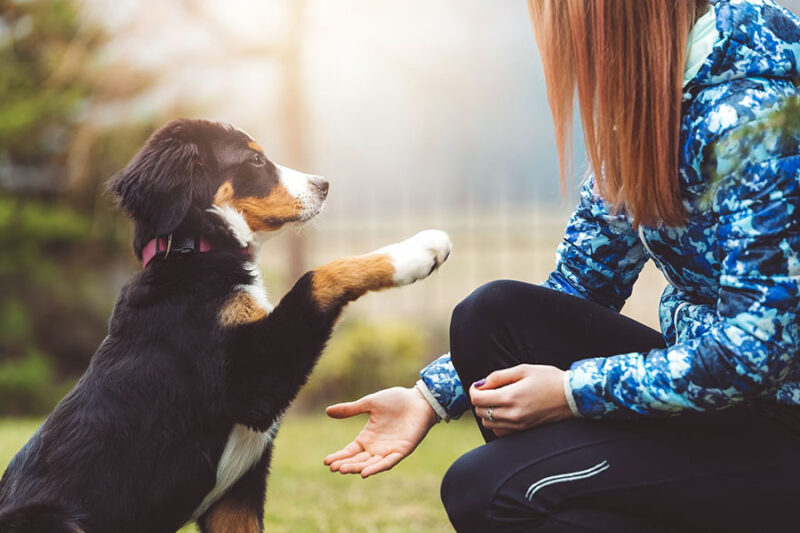
Did you know that a well-trained dog exhibits fewer behavioral problems and enjoys a happier life? Whether you’ve just welcomed a spirited puppy or a serene older dog into your home, embarking on a training journey can turn daily life into a joyful and harmonious adventure. The secret lies in timely guidance and dog problem-solving training, which are essential to building a bond filled with mutual respect and understanding. Let’s explore how to foster an ever-flourishing companionship with your furry friend.
Tackling Behavioral Issues Head-On
Addressing behavioral issues in dogs, such as excessive barking or furniture chewing, is a prevalent challenge many owners face. While these issues might seem overwhelming initially, effective problem-solving techniques can help you manage them successfully. Understanding your dog’s unique personality and needs is the first step in preventing minor issues from escalating. Here are some strategies to tackle behavioral issues effectively:
- Understanding the Root Cause : Identifying why your dog is acting out is the first step towards finding a solution.
- Personalized Training : Tailoring training to suit your dog’s personality and needs.
- Positive Reinforcement : Encouraging good behavior through rewards and praise
Embrace a Guided Approach to Problem-Solving
Our problem-solving lessons at The Dog Wizard offer a structured approach, assisting owners in effectively identifying and tackling a range of behavioral issues in dogs. This training process facilitates a more profound understanding between the owner and the dog, establishing a foundation built on mutual respect and trust. This method will solve existing issues and prevent potential problems, enhancing the joy of sharing your life with a loyal canine companion.
Establish a Safe Haven through Crate Training
Crate training is a priceless tool for all dog owners, creating a safe personal haven where dogs can relax, enjoy meals, or unwind. It aligns with a dog’s instinct to seek safety in an enclosed area. Combining crate training classes with leash training ensures safety and comfort during walks. Contact us through our form for personalized advice on crate training.
Uncover Your Dog’s Unique Personality
Effective problem-solving involves delving deep into your dog’s personality and instincts. Dogs, much like humans, have their quirks and traits. Spending time with your dog helps you grasp what captures your dog’s attention, setting the stage for rewarding training interventions. Watch how your furry friend behaves in different situations to understand their personality comprehensively.
Spot Early Signs of Problem Behaviors
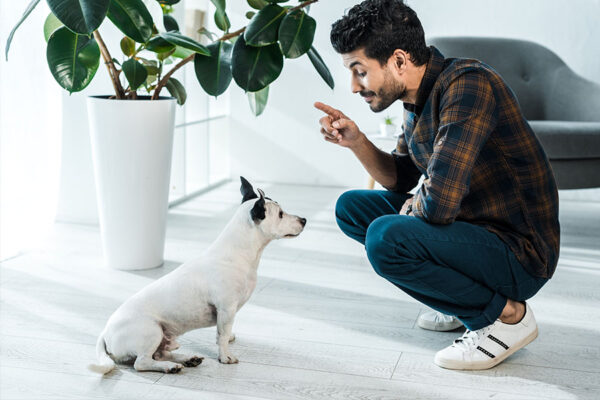
Being proactive in recognizing the early signs of problem behaviors is vital. Sometimes, these behaviors originate from underlying factors that aren’t instantly noticeable. Paying attention to your dog’s habits and actions can unveil potential issues and prevent them from spiraling out of control. In cases where your dog exhibits signs of anxiety or aggression, consulting a professional trainer for guidance can be a game-changer.
Implement Strategies to Prevent Aggression
Aggression in dogs can manifest in different forms, such as growling or biting. These early signs are essential to prevent accidents and maintain a safe environment. Here are strategies to prevent aggression in your dog:
- Identifying Triggers : Recognize and understand the triggers, whether territorial or fear-induced, that cause aggressive behavior in your dog.
- Dog Obedience Training : Enroll your dog in obedience training to control and correct aggressive dog behaviors early on.
- Safe Environment : Create a safe and secure environment to prevent incidents and facilitate better control over your dog’s behavior.
Handling Destructive Behaviors: From Biting to Barking
Almost every dog owner will, at some point, need to address destructive behaviors like biting, chewing, or excessive noise. These behaviors might indicate discomfort, boredom, or anxiety. Addressing these issues swiftly can prevent further problems. Techniques such as positive reinforcement can guide your dog toward more desirable behaviors.
Redirecting Attention-Seeking Behaviors
Often, dogs develop attention-seeking behaviors to communicate with their owners. These can include persistent noise or destructive actions. Here are some strategies to identify and redirect these behaviors constructively:
- Identifying the Root Cause: Delve deep to understand the underlying reasons behind the attention-seeking behaviors.
- Engaging Activities: Introduce your dog to mentally stimulating activities or fun games to channel their energy positively.
- Setting Boundaries: Train your dog to understand and respect boundaries within the home.
- Consistent Responses: Maintain consistency in your response to prevent confusion and foster better understanding.
The Significance of Early Intervention
Early intervention in problem behaviors can prevent minor challenges from growing into difficult situations. Consistent private dog lessons from puppyhood can nurture a healthy bond, making it easier to address and solve issues as they arise. This proactive process fosters a less stressful and enjoyable training experience for both parties.
Building a Harmonious Connection
A harmonious owner-dog connection thrives on trust and mutual respect. Here’s how you can foster a fulfilling companionship with your pup:
- Understanding Your Dog’s Needs : Invest time in understanding your dog’s unique personality and preferences.
- Open Communication : Foster a communication line where your dog can ‘talk’ to you through signals and body language.
- Reward-Based Relationship : Build a bond that thrives on rewards, praise, and positive reinforcements.
Establishing Trust and Rapport: The Foundations of Problem-Solving
Trust and rapport are the cornerstone of successful problem-solving training. As an owner, building a trust-based relationship with your dog is vital. Recognizing and responding to your dog’s signals fosters a fruitful connection that enhances life for both parties.
Cultivating a Strong Bond with Your Dog
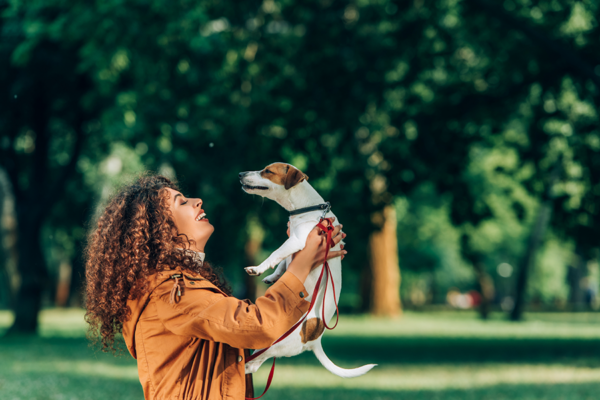
Building a bond with your dog is a continuous endeavor filled with play and fun. Activities that captivate both can strengthen this bond, making the training phase more enjoyable. Rewarding good behavior with treats or praise further solidifies this connection.
Embracing Your Role as the Owner During Training
In the lesson course, your role as the owner is central. Your patience, understanding, and familiarity with diverse training methods considerably influence the training’s success. Are you ready to train your dog in problem-solving? Gain access to expert advice by reaching out through our contact form.
Behavioral Analysis: Understanding and Addressing Underlying Causes
To kickstart effective problem-solving training, owners must pinpoint the triggers and underlying causes of their dog’s problematic behavior. Observing when and where problems like excessive noise can guide a successful training course. These insights pave the way to correcting these issues and cultivating a harmonious bond.
Leveraging Problem-Solving Techniques for Behavioral Analysis
Owners can employ problem-solving techniques to analyze better and comprehend their dog’s behaviors. Seeking assistance from experts like The Dog Wizard to create personalized training programs can be beneficial. Owners can foster a happier and healthier connection with their animals by focusing on specific areas and applying targeted solutions.
Training Approaches: Encouraging Positive Behavior
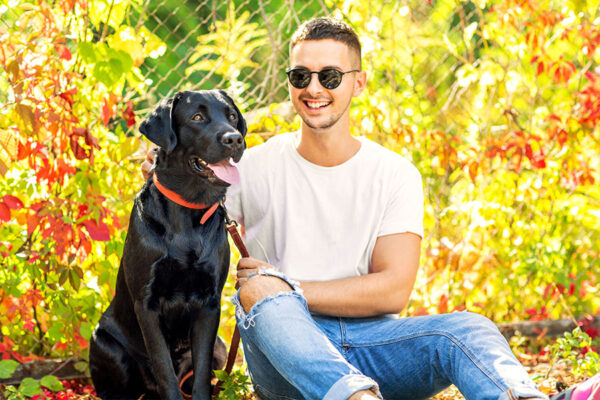
Positive reinforcement training is a vital tool in fostering good behavior in dogs. This approach emphasizes rewarding the dog for positive behavior, encouraging them to repeat it. This method has proven to be an easy way to address several behavioral issues successfully.
Using Treats Effectively in Training
Treats in training are a popular method to encourage dogs to behave well. Here’s how to use treats effectively in training:
- Positive Association : Utilize treats to create a positive association with desired actions.
- Balanced Approach : Maintain a balanced approach to avoid potential food aggression or over-dependence on treats.
- Choosing the Right Treats : Select treats suitable for your dog’s age, size, and dietary needs.
- Timing is Key : Offer treats at the right time to reinforce positive behavior effectively.
Encouraging Good Behavior Through Praise and Rewards
Giving praise and rewards when they display good behavior is key. This positive feedback encourages them to repeat these actions, fostering a loving and respectful bond. Rewards can range from verbal praise to a favorite toy, keeping the training sessions engaging and enjoyable.
Habituation and Conditioning: The Foundations of a Happy Canine
Understanding habituation is essential in problem-solving lessons. This process involves accustoming the dog to certain stimuli or situations where it no longer triggers a reaction, a fundamental aspect of conditioning a dog to display desirable behavior.
Introduction to Classical and Operant Conditioning
Comprehending and utilizing the principles of classical and operant conditioning are fundamental in dog lessons. These strategies form the basis of a rewarding problem-solving regimen, fostering the development of good habits and the elimination of undesirable ones.
Paving the Path to a Joyful Canine Companion
Embarking on a problem-solving journey with The Dog Wizard guarantees an enjoyable, educational, and bonding experience. Our expertise in handling different breeds and temperament types makes us your ideal partner in molding a well-mannered and joyful canine companion.
Embark on Your Dog’s Journey to Excellence with The Dog Wizard
Ready to forge a delightful, fulfilling, and joyful bond with your furry companion? Your search ends here! Join The Dog Wizard today for a revolutionary journey in problem-solving training.
Let’s Get Started
We know your dog is unique. Before making any recommendations, we need to evaluate your dog’s needs.
Connect with a team member for more information

Ready for Dog Training?

Tell Us About Yourself
Tell Us About Your Dog
Find Out How We Can Help
Let’s get started.
We know your dog is unique. Before making any recommendations, we need to evaluate your dog’s needs.
How can we help?:

The Dog Wizard
Copyright © 2024 All Rights Reserved ITK9 Franchise, LLC DBA as The Dog Wizard
Privacy Policy | Terms & Conditions | Sitemap | Franchise Portal
Honest Advice
- About Trainer & Author Michele Welton
- Dog Breed Reviews
- Dog Training Advice
- Dog Feeding & Health Advice
- Dog Buying Advice
- Michele's Free Books

- Respect Training for Puppies
- Teach Your Dog 100 English Words
- 11 Things You Must Do Right To Keep Your Dog Healthy and Happy
- Dog Training
- Health & Feeding
- Finding a Good Dog
- All Dog Breed Reviews
- – Tiny Toy Dog Breeds
- – Small Dog Breeds
- – Midsize Dog Breeds
- – Medium Size Dog Breeds
- – Large Dog Breeds
- – Giant Dog Breeds
- About Michele
Home > Dog Training > Solving Dog Behavior Problems
Solving Dog Behavior Problems – Dog Training That Works
By Michele Welton , Dog Trainer, Breed Selection Consultant, Author of 15 Dog Books
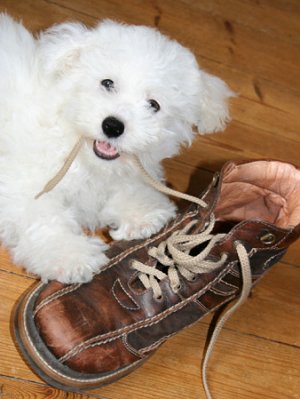
All puppies (and adult dogs, too) do some things you would rather they not do!
So you're reading this page because your dog is doing something you don't like – some behavior you want him to do differently – or simply stop doing.
- Housebreaking "accidents"
- Barks too much
- Won't let go of things
- Steals food when you turn your back
- Jumps on people
- Chews on your hands
- Constantly seeks attention
- Guards his food or toys
- Pulls on the leash
- Aggressive toward people or other dogs
- Struggles when you try to restrain him
- Chases the cat
- Chews on the furniture or your belongings
- Did I mention housebreaking "accidents"?
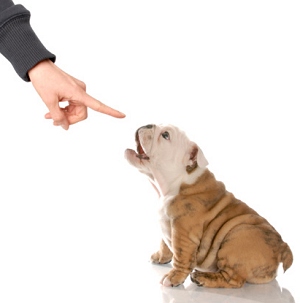
The "magic word" for virtually all dog behavior problems is "No." But what you do AFTER you say "No" is the true solution for stopping dog behavior problems. Do you know what to do next?
"How can I stop my dog from....?"
One of the most common questions dog owners ask me is: "How can I stop my dog from (doing some specific behavior problem)?"
Alas, my answer is almost always the same, no matter what the misbehavior is. Here it is (free of charge):
You need to tell your dog, "No. Stop that."
Does that sound too simplistic? It probably does, because most owners respond in a frustrated voice, "But I already tell my dog No! He still doesn't listen!"
Fair enough. Here is what is going on. Either he really doesn't understand what No means (this is the truth in MANY cases), or else he understands it but doesn't see any reason why he should obey it.
There are two key points here, you see...your dog must understand the word (I can show you how to teach words properly) and then he must respect you enough to obey it. Because without respect, your dog may UNDERSTAND what you say, but he doesn't see any reason why he should DO what you say. (Unless you're bribing him with a cookie, which only works sometimes – usually NOT when you need it most.
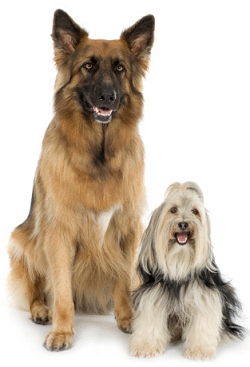
No matter how large or how small, all dogs need to respect their owners. I teach my small dogs to respect me in the exact same ways I taught my German Shepherds.
Getting your dog to respect you means interacting with him in specific ways that encourage respect.
You might be thinking, "But I already know how to interact with my dog. I care for him and I love him.... it's easy."
Actually, it isn't so easy, because canines see and interpret the world differently than we do.
Whenever you do anything with your dog, even just walking through the kitchen, or petting him, or speaking to him.... he is busy judging your tone of voice, your facial expression, your body language, how you're touching him, how you're responding when he does "X" or "Y".
All of these seemingly little things are very, very important to your dog. They're the clues he uses to draw conclusions about you and to decide whether you're worthy of respect or not.
- If you interact with your dog in certain ways that are WRONG for canines, he will conclude that even though he loves you, he doesn't need to obey you. And you will see behavior problems.
- If you interact with your dog in all the alt ways, he will conclude that he not only loves you, but also that you're a capable leader worthy of respect. Then he will obey when you say, "No. Stop that." (assuming, of course, that you have taught him what it means so that he understands)
Respectful dogs don't misbehave. It is as simple as that.
Well, okay....ALMOST as simple as that. There are a few more things your dog needs in order to be well-behaved.
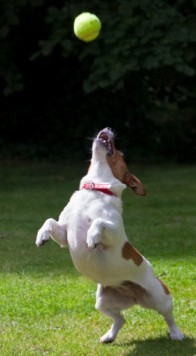
Dogs need enough exercise and active play sessions to tire them out. Some dogs need only moderate exercise, while others need LOTS to make them feel content. You must meet the needs of your particular dog.
Exercise, Activities, Companionship
Even respectful dogs will misbehave if they don't get enough exercise, interesting activities to do, and daily companionship.
Dogs are sociable creatures.
- If you leave your dog home alone for 8 hours , he will feel bored and frustrated.
- If you leave him outside for hours at a time, he will feel bored and frustrated.
- If you don't provide enough exercise and activities, he will feel bored and frustrated.
Boredom and frustration are major causes of behavior problems in dogs.
Dogs vent boredom and frustration by destroying things.... digging holes.... rambunctiousness.... escaping.... barking...
Those "misbehaviors" cannot be solved by training. Your dog has every right to vent his boredom and frustration when his needs of Exercise and Companionship are not being met. You must meet those needs while ALSO teaching commands and a respectful attitude. That's how you raise a well-behaved and contented dog.
What you should do right now to prevent or stop behavior problems
You need to learn the right ways to interact with your dog – and the wrong ways too, so you don't do those!
You need to know how to teach the Magic Word ("No") to your dog and how to respond if he doesn't obey it.
That's how you stop behavior problems. With that one word.... plus respect... plus however much exercise and companionship it takes to keep your dog satisfied.
I can guide you with my complete training program, which is available free on my website. Scroll down to read it!

My best-selling books – now available FREE on my website

Copyright © 2000-2024 by Michele Welton. All rights reserved. No part of this website may be copied, displayed on another website, or distributed in any way without permission from the author.
- Dog Training Tips
Common Behavior Problems in Dogs
- Skip to primary navigation
- Skip to main content
- Skip to primary sidebar
- Skip to footer

Dog's Best Life
The information you need to keep your dog happy, healthy, playful and loyal.
Are wolves better problem solvers than dogs?
PUBLISHED: April 13, 2018 | UPDATED: March 18, 2023

The modern domestic dog has been the four-legged friend of humans for thousands of years. Distantly related to the modern day gray wolf, the domestic dog is thought to belong to a lineage of wolves now extinct. Over millennia the canine evolved like humans.
Selective breeding has created a variety of breeds that are prized for their unique abilities, physical qualities and sensory attributes. In fact, some dog breeds are prized for their reputation of being smart . Consider the border collie for example, the dogs have the highest score when it comes to working intelligence.
Recent studies, however, suggest that the domestication of dogs may have had a negative effect on dog problem-solving skills.
In a variety of studies, wolves outperformed dogs in simple problem-solving scenarios and maybe less surprisingly team-based tasks.
Oregon State studies dog problem-solving skills

One such study was conducted by animal behavior researcher Monique Udell of Oregon State University. During the experiment, individual dogs and wolves were presented with a plastic food container and were expected to remove the lid to retrieve the tasty reward inside.
Astonishingly, 8 out of 10 wolves successfully got the treat, while just 1 in 20 domestic dogs managed to do so in the same test.
Interestingly, however, puppies were successful more often than adult dogs, indicating that potentially human training may have an influence on the dogs’ behavior rather than them intrinsically lacking the dog problem-solving skills to open the container.
Wolves also seem better at understanding cause and effect relationships. .
Wolves have an intrinsic ability to find food
A recent study conducted by Radboud University’s Michelle Lampe highlighted that wolves, distinct from their close domesticated relative, appear to have an intrinsic ability for making observations of where food was concealed.
This suggests that the process of domestication may have changed dogs’ cognitive ability, or at least their motivation to act alone. This makes sense of course, since wolves live in the wild and are isolated from humans. To survive, they have to use problem-solving skills such as in hunting in order to survive.
While their domestic cousins, raised by humans from puppyhood, have no real motivation or need to be independent because their owners meet their needs.
Another important consideration is selective breeding. For generations, breeders have been choosing mates based on traits that have nothing to do with competence in the wild, which potentially compounds the issue even further.
Are wolves smarter than dogs?
You may reach the understandable conclusion that these studies show dogs aren’t as smart or that their intelligence is inferior to wolves, yet it isn’t that straightforward. In reality, there could be a variety of reasons for these behavioral differences unrelated to intelligence.
Clive Wynne, a leading expert in the field based at Arizona State University in Tempe, postulates that from the results of some studies wolves are practical problem solvers, while domestic canines are social problem solvers.
Essentially this means that domestic dogs may be raised in an environment that alters their natural behaviors.
For instance, in a human environment, dogs are trained to be obedient and soon learn that certain behaviors may cause aggression or discipline from their owners. For instance, if a dog tries to take food from a human’s plate, the dog would be scolded and either learn not to steal food or understand he needs to be more careful the next time.
Wolves on the other hand have received no such training about eating, so they are unlikely to have modified their behavior.
So while young dogs aren’t intrinsically bad at problem solving, over time they are socialized to be more obedient and cautious around food.
Of course, the fact domestic dogs have developed cooperation traits is a major reason they have become such sought after human companions. In fact, dogs are the only animals to understand a human finger point and are able to pick up on a variety of human signals.
It’s also important to remember domesticated dogs and modern wolves aren’t directly related, so making comparisons between their characteristics and behavior isn’t always reliable. Especially when you consider that their common ancestor is thought to have roamed Earth as long as 36,000 years ago .
Can owners help pets develop dog problem-solving skills?
It seems that the studies make it clear that domestic dogs appear to suppress their inherent problem-solving abilities in favor of remaining obedient to please their owners.
This was made especially clear in a study repeated by Udell, which showed that when their owners encouraged them, the dogs were more willing to take the food from the container.
Since we know dogs are social problem solvers, rather than adaptive problem solvers like wolves, how can we help dogs become better at solving problems?
The research highlights that in order to solve problems, unlike wolves, dogs will not act independently and are less likely to adapt to a new situation without encouragement. Wolves will persist in their quest to get the food, while dogs will instead make eye contact and look for help from their owners.
So by responding to your dog with encouraging body language , social cues and appropriate rewards for being obedient, the dog is more likely to succeed.
Another important misconception is that like wolves, dogs are cooperative and work together to solve a task.
But the evidence indicates that this isn’t the case. Dogs view it as a hierarchical relationship, with the owner as the leader of the pack. The truth is dogs have been bred to be obedient, rather than cooperative, which is why they seek their owner’s approval, which is a very important thing to note when training your dog.
– By Carl Green
Carl Green is a dog owner, wildlife enthusiast and blogger who’s other works can be found on AnimalMentor. If he’s not out walking his dogs, pruning his garden or tending his vegetable patch, he can be found writing about wildlife, animals and pets.
Related Posts
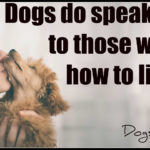
Dogs do speak, but only to those who know how…

Old dogs, like old shoes, are comfortable - Bonnie Wilcox…

A dog wags its tail with its heart - Martin…
Quick Links
- Top Stories
Recent Posts
- 21 essential upgrades to give your dog the best life at home Make simple home improvements for your dog: Upgrade flooring, secure outdoor space, improve air quality, and incorporate technology. […]
- Is a hard-working, curious Schipperke your dream dog? The Schipperke is a small but hard-working breed with a fox-like face, stocky body, and pointed ears. Their coats are solid black. […]
- Boost your dog’s sleep: 7 reasons to use a blanket year-round Young, old, sick, and small dogs all benefit from using a dog blanket. Blankets also protect your furniture and are easy to take on trips. […]
- Use schedule, love, patience to create puppy potty training success Puppy potty training takes patience and love. Dogs learn to go potty with the proper routine and positive reinforcement. […]
Get Our Newsletter
Get more news to help keep your dog healthy delivered right to your inbox. Sign up for DogsBestLife.com's monthly newsletter.
Email address:
By entering your information, you agree to allow us to contact you in accordance with our privacy policy.
You can see how this popup was set up in our step-by-step guide: https://wppopupmaker.com/guides/auto-opening-announcement-popups/
Search to solve your problem...
- Adolescence
- Aggression On Being Moved
- Aggression Over Food And Possessions
- Aggression To Other Dogs
- Aggression To People
- Aggression To Puppies
- Bad Manners
- Barking eBook - "Shhush! How To Have A Quiet Dog"
- Car Travel Problems
- Eating Faeces and Non-food Items
- Escaping And Running Away
- Fear And Anxiety
- Frustration And Re-directed Aggression
- House Soiling
- Hyperactivity
- Jumping Up And Pawing
- Noise Fears And Phobias
- Multiple Dogs In A Household Problems
- Play-biting In Adult Dogs
- Predatory Aggression
- Problems When Being Handled
- Problems with Cats, Horses, and Small Animals
- Problems With Other Dogs
- Problems With Rescue Dogs
- Pulling On The lead
- Rolling In Unpleasant Substances
- Running Off On Walks
- 'Second' Dog Problems
- Separation Problems
- Territorial Behaviour
- Aggression Over Food And Possessions In Puppies
- Puppy Bad Manners
- Fear And Anxiety In Puppies
- Night-time Problems
- Puppy Problems With Other Dogs And Puppies
- Puppy Aggression To Other Dogs And Puppies
- Puppy Aggression To Children
- Puppy Aggression To People
- Puppy Barking
- Puppy Biting
- Puppy Chewing
- Puppy Growling
- Puppy House Soiling
- Puppy Jumping Up
- Puppy Nipping
- Puppy Play-Biting
- Puppy Pulling On The Lead
- Raising A Puppy With An Older Dog
- Raising Two Puppies Together
- Separation Problems in Puppies
- Choosing A Good Breeder
- Choosing The Right Breed
- Courses and Careers In Animal Behaviour
- De-barking - Is It Ethical?
- Importance Of Play For Puppies
- Introducing A New Dog To Another Dog In The Family
- Object Sucking In Dogs
- Socialisation
- Taking Your Dog To Work
- How To Train A Superdog
- What Is My Dog Thinking?
- How To Train A Superpup
- Choosing The Right Dog For You Book
- Good Dog Behaviour Book
- Hell On 4 Paws
- Puppy School Book
- The Perfect Puppy Book
- Choosing A Good Dog Training Class
- Choosing A Good Puppy Training Class
- Developing The Retrieve
- Drop The Object
- Fetch And Retrieve
- Good Manners
- How Dogs Learn
- Instant Recall
- Pulling On The Lead
- Sit Or Down At A Distance
- Trick Training
- How To Teach A Willing Retrieve
- Top 10 Registered Breeds
“My name is Gwen Bailey and I've been helping owners with problem dogs for over 20 years. Finding solutions to dog behaviour problems has been my specialty throughout my working life and this website aims to make good practical advice accessible to everyone. With the right techniques, there is hope for even the worst of cases. Good luck with finding a solution that works for both you and your dog.”
Here to Help.
“Dogs are social, emotional and complex. This website is dedicated to helping you understand why your dog behaves in unexpected, surprising, or sometimes annoying or upsetting ways. Together we can find treatments and techniques to help your dog behave acceptably, leading you both to a successful and harmonious partnership.”
“Problems are never successfully solved by force and domination; intelligent thought and knowledge finds a solution that works for all”
- The Science Bit!
- Events & Courses
- Terms & Conditions
- Privacy Policy
Keep in touch...
We earn a commission for products purchased through some links in this article.
5 common puppy problems and how to solve them
Including how to stop a puppy biting
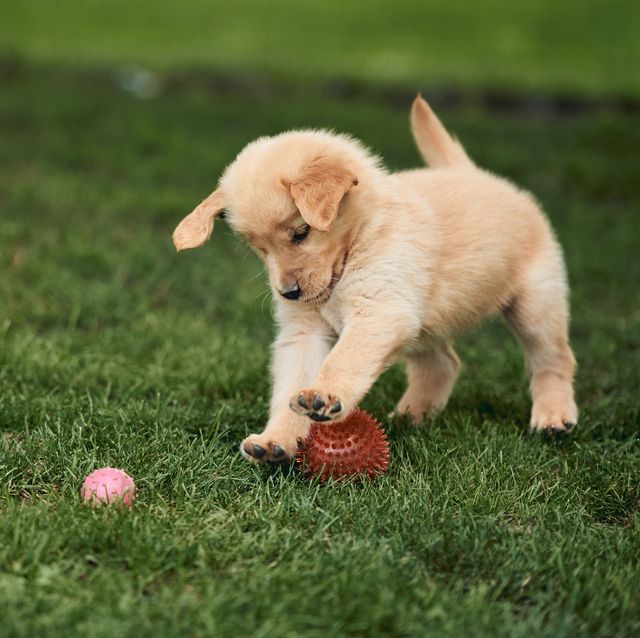
Puppies put everyone in a good mood, but they are not always easy to take care of. From training techniques to puppy-proofing the house , it is important to ask all the right questions before you consider rehoming a pup.
To make your life easier, money.co.uk has revealed the biggest puppy problems for Brits by analysing search volumes in the UK — and provided helpful tips for each query.
"The sheer number of average online searches every year indicates that we want what's best for our furry friends, as well as ensuring an easier transition into their new home," says Salman Haqqi, pet insurance expert at money.co.uk .
"Many people forget the importance of taking the correct precautions, especially with older dogs and younger children at home, so it's best to introduce everybody slowly and in a safe manner."
Take a look at the most-asked puppy questions, along with how you can solve them...
1. How to stop a puppy from biting (176,100)
Teaching your puppy not to bite is hard, and with over 170,000 annual searches, it seems Brits need a little more help.
"To help train your puppy to stop biting, you can ignore the puppy or walk away as the more you respond (even by telling them off) the more they'll think it's a game," say the experts at money.co.uk. "When they do back off, reward them."
2. How to toilet train a puppy (67,400)
Toilet training an excitable puppy can be a challenge. According to the experts, one of the ways you can train them like a pro is by agreeing on a command at home so that your puppy associates the term with going to the toilet.
Money.co.uk add: "Adding newspapers they've already soiled to their toilet area can also help navigate them to their next toilet break adventure."

3. When can puppies go outside? (63,000)
Are you wondering when your puppy can head outside to public places, such as dog parks? Well, according to the experts, owners should wait until two weeks after your puppy has had their second vaccination.
4. When do puppies open their eyes? (59,200)
Puppies are born with their eyes closed and gradually open their eyes between 10 and 14 days old. It depends on the individual puppy, of course, so sometimes puppies may open their eyes a day or two earlier or later than that.
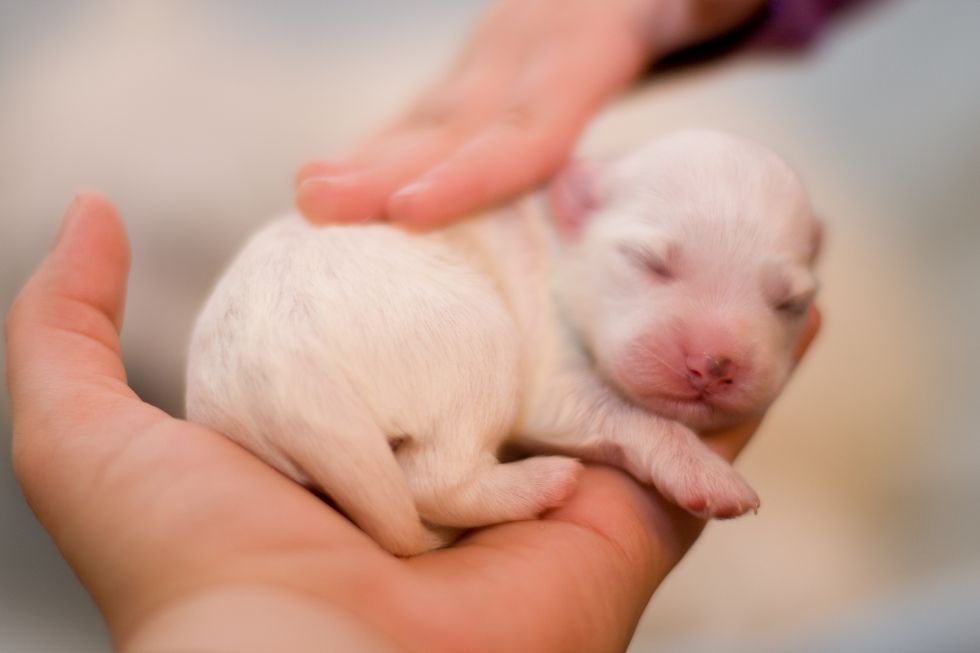
5. How to train a puppy? (55,400)
"Training a puppy has never been easier with the vast amount of information on the internet," explain Money.co.uk. "You can browse YouTube videos or buy a puppy training book for specific training. Likewise, check your local area for any puppy training classes as this will also encourage the dog to socialise."
Follow Country Living on Instagram .
12 dog winter coats to keep your pups cosy

H&M Quilted dog jacket
Keep your pup snug and secure with this thick quilted dog jacket from H&M. Perfect for a winter's walk, it has quilted seams, a stand-up collar with an open front, and a belt with a hook and loop fastening at the back.
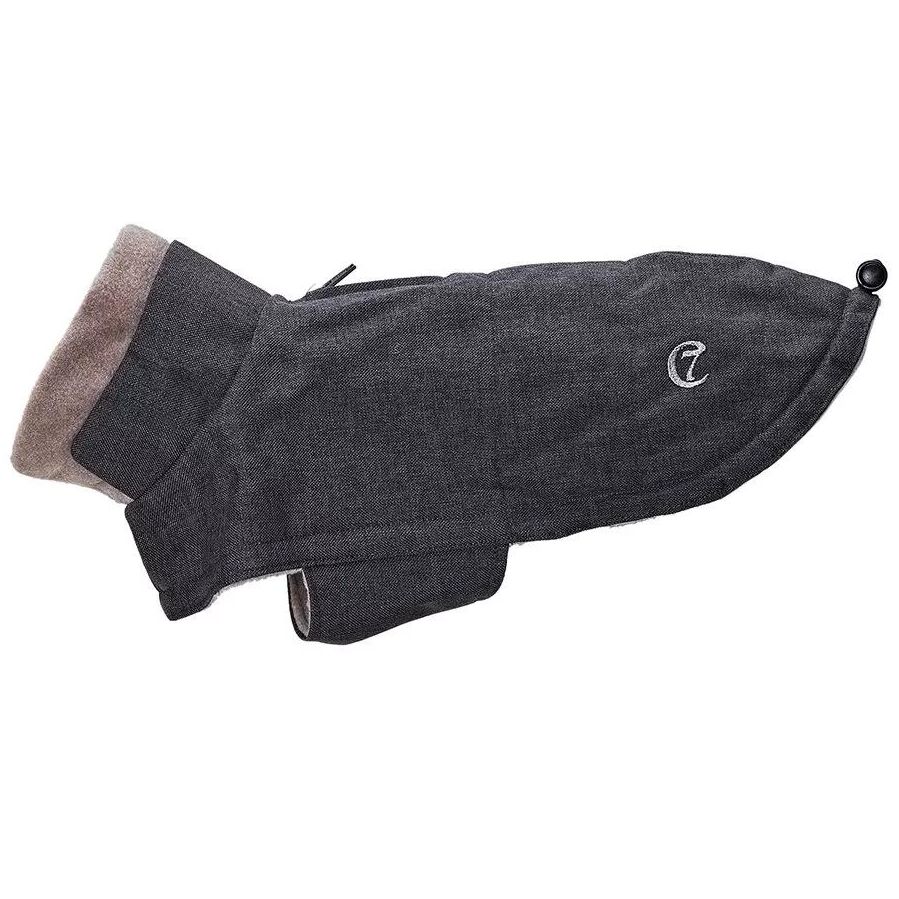
Waterproof Brooklyn Dog Coat - Graphite - Medium
Designed to resist whatever the weather throws at you, this waterproof dog coat is ideal for older pups with joint problems or less fur and has a particularly warm inner lining.
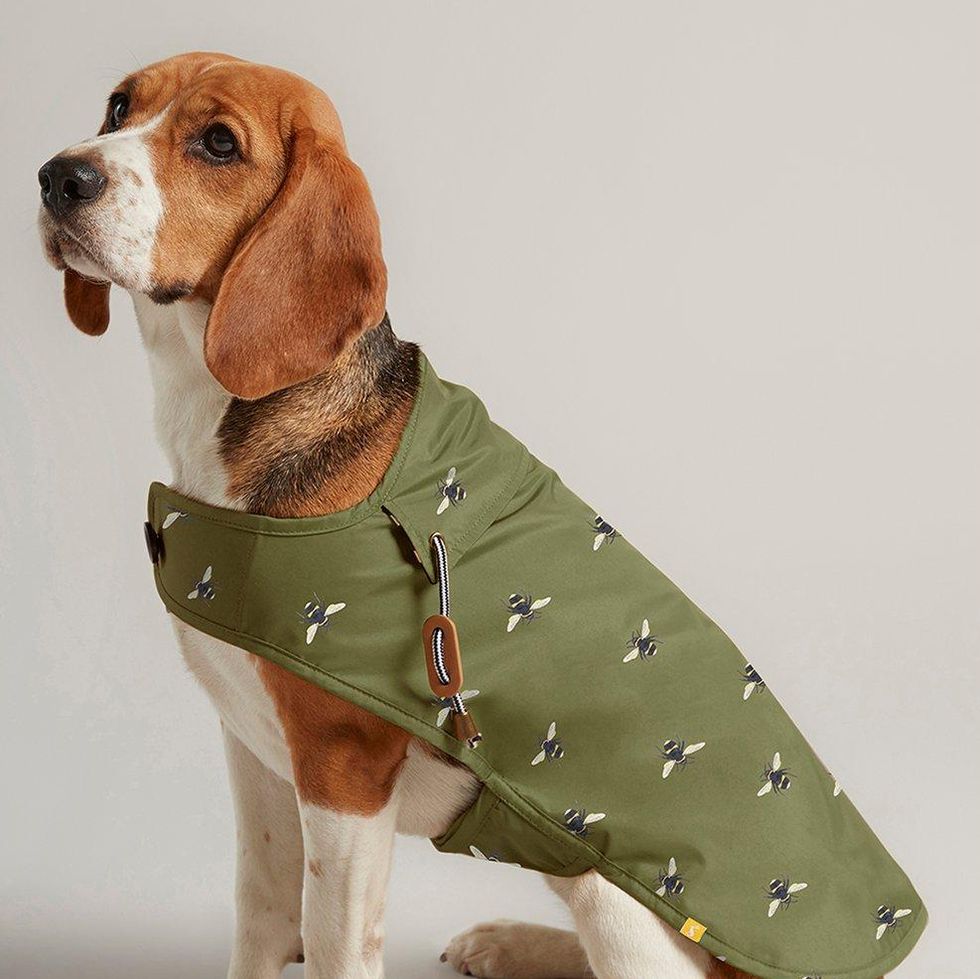
Joules Olive Green Waxed Dog Coat
Keeping warm and snug just got a whole lot easier thanks to this gorgeous waxed coat from Joules. In olive green, it has a tweed lining and beautiful bee prints.
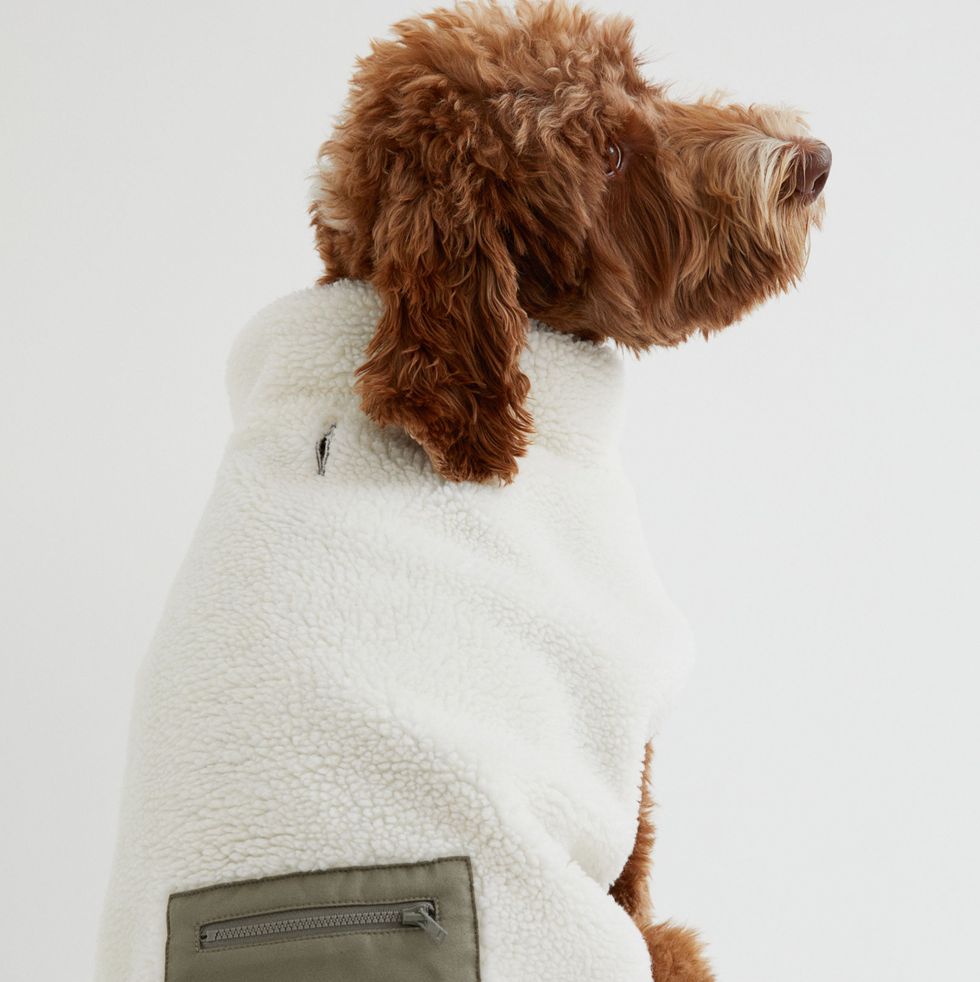
H&M Pocket-detail faux shearling dog jacket
In a gorgeous white, this pocket-detail faux shearling dog jacket has been designed to add an extra layer of warmth during those cold winter days. It has two small holes for their legs, as well as a zipped pocket on the back.
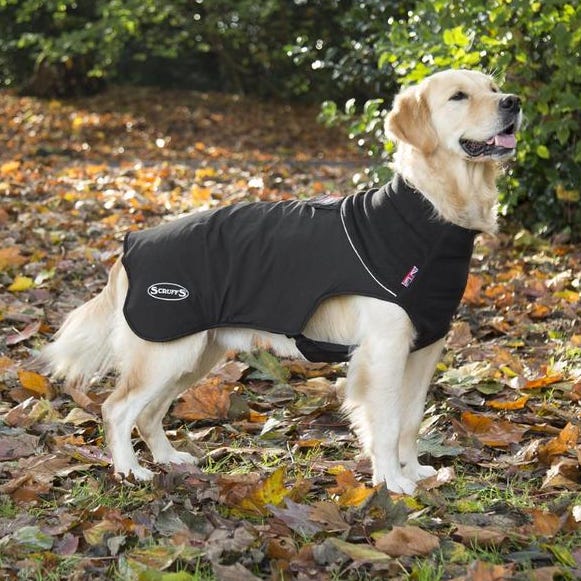
Thermal Self-Heating Dog Coat - Black
This thermal dog coat is excellent for winter walks, thanks to its self-heating technology.
"Our reflective technology lining, combined with a hollow fibre core maximises the dog coats thermal properties," say petslovescruffs.com. "The thermal dog coat has a fleece collar and chest pad to provide greater comfort, improved fitment and allow unrestricted movement."
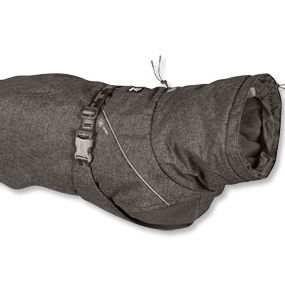
Hurtta® Expedition Dog Parka
A warm pet coat is great to ward off the chill during winter. Not sure which one to pick up? We love this technical dog parka, which has been specially developed for short-haired dogs and dogs without an undercoat.
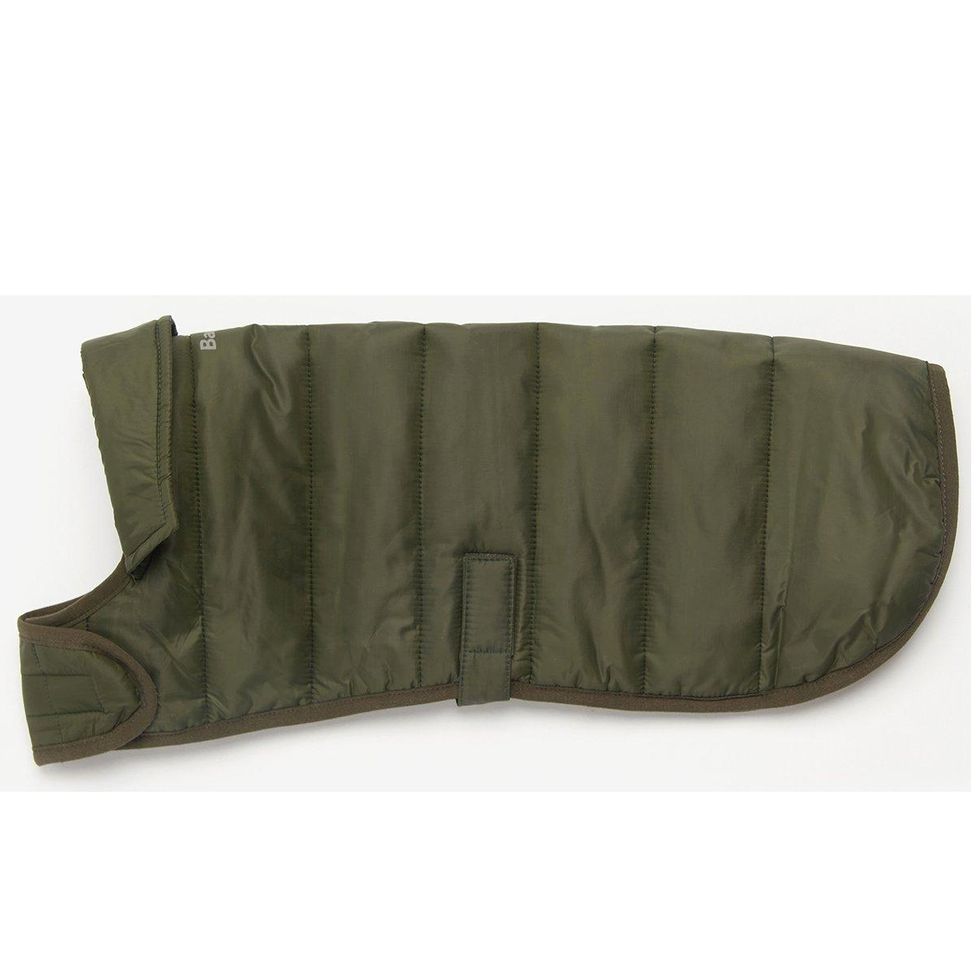
Barbour Baffle Dog Coat- Olive Medium
In olive green, this luxurious Barbour coat is ideal for dogs who like the finer things in life.
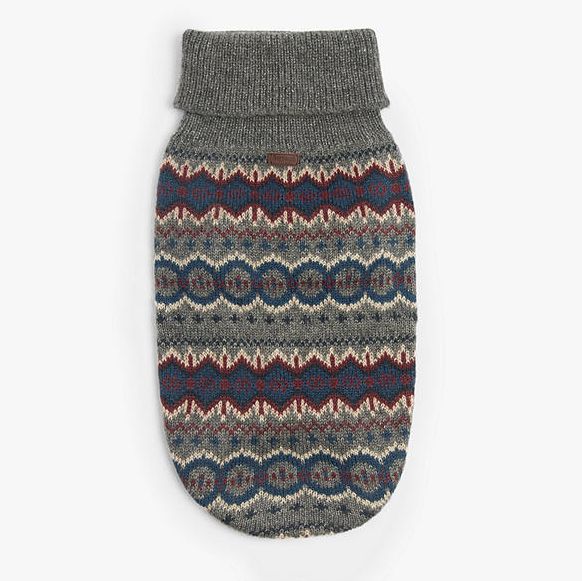
Barbour Fairisle Dog Jumper, Grey, Small
On the hunt for a warm knit jumper? To keep your furry friend extra cosy, why not pick up this Barbour jumper. Boasting a unique design with a roll neck for elite comfort, it's perfect for them to wear on a Christmas Day walk.
READ MORE: The Barbour Christmas advert 2021 stars Paddington Bear and his heart-warming family
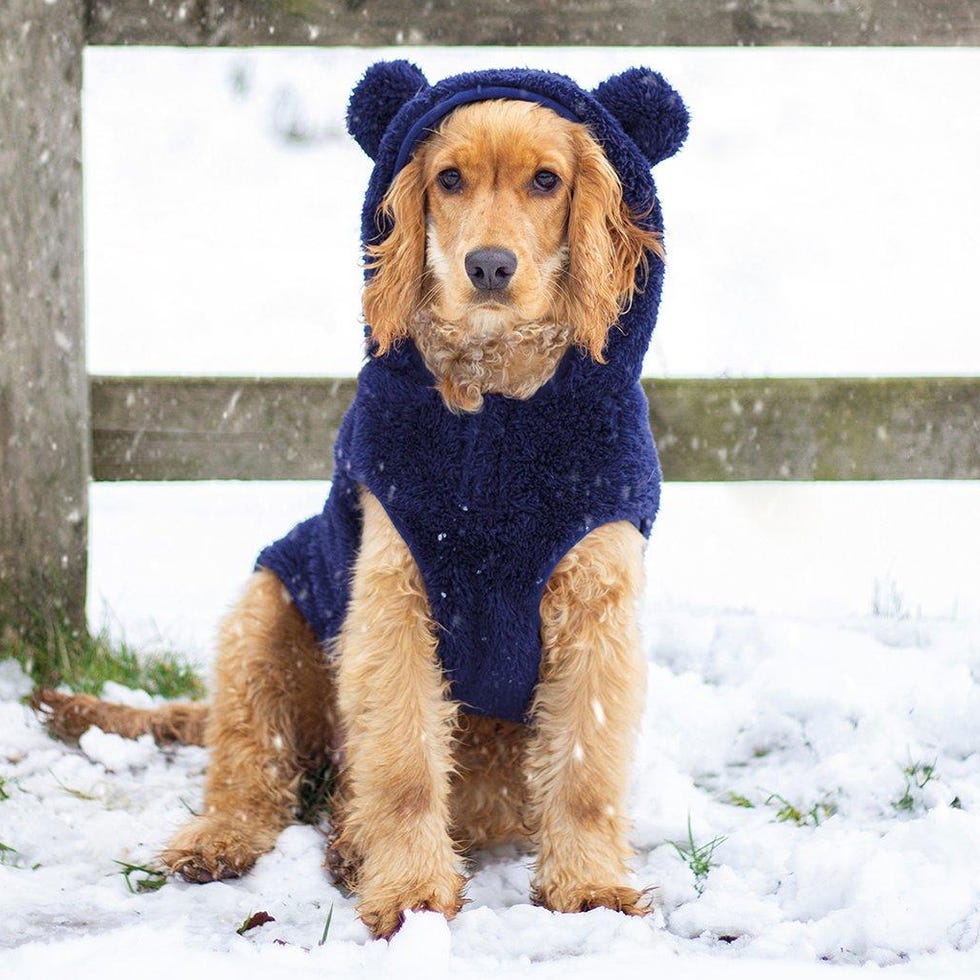
Rosewood Teddy Bear Dog Hoodie - Large
Made from super-soft fleece fabric, this blue fluffy coat has teddy bear ears attached to keep your dog warm and cosy. It also has a stretch jersey fabric, making it easy to pull on and off.
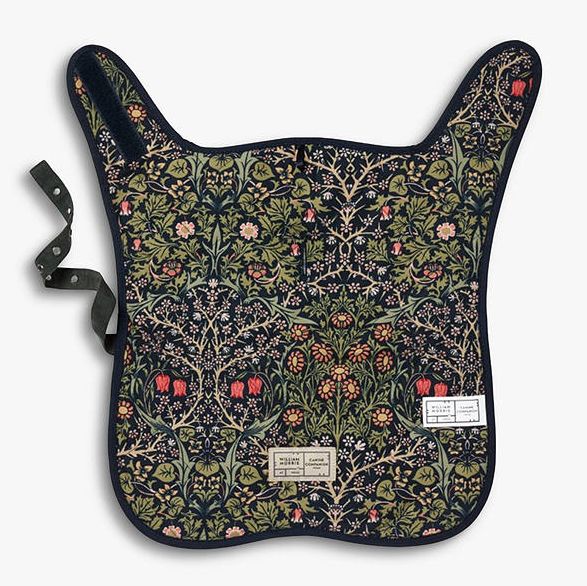
William Morris at Home Blackthorn Reversible Dog Coat, Small
William Morris fans will love this adorable reversible dog coat in the brand's classic print. With a water-resistant, waxed cotton outer fabric, it also helps to keep rain off.
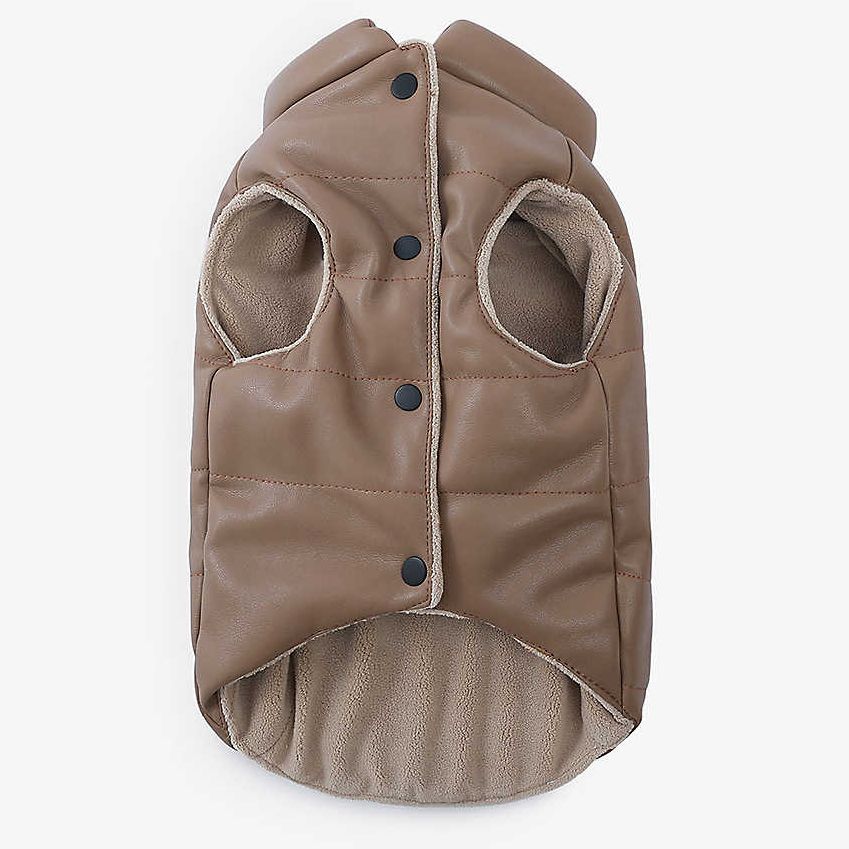
OVER GLAM Medium faux leather sleeveless dog jacket
This sleeveless dog jacket looks so cosy! It has small holes for their legs and black poppers to keep them cosy.
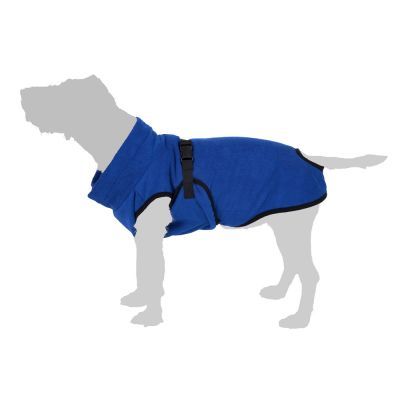
Microfibre Dog Coat
In vibrant blue, this microfibre dog coat is light and absorbent to offer protection from getting cold. It has a click fastener on the back and openings for legs and tail.

How to stop dogs pulling on a lead

These are the two colours dogs can see

How to keep dogs cool over summer

How to help a grieving dog

How to train your dog to roll over

How to find out if it's too hot to walk your dog

How to clean dog ears

Can you legally smash a car window to save a dog?

5 ways cat owners can help to reduce bird kills

7 ways to train your dog not to bite

The best indestructible dog toys

Can dogs have panic attacks?
Skip to content
- Helping Shelters, People and Pets
- Investigations and Rescue
- Animal Care and Recovery
- Improving Laws for Animals
- The Puppy Industry
- Protecting Farm Animals
- Advancing Horse Welfare
- ASPCA Grants
- New York City
- Los Angeles
- Asheville, NC
- Oklahoma City, OK
- Ways to Give
- Get Involved
- Find More Humane Food
- Adopt a Pet
- Advocate for Animals
- Receive Text Updates
Primary Nav Menu
Search form, aspca partner shelter reaches a major milestone: 20,000 animals transported.

When Henry Bergh founded the ASPCA in 1866, he drew attention to the plight of animals, pushing for laws to protect them in an age when many people didn’t believe animals were sentient beings.
As progressive as he was, Bergh, born on this day more than 200 years ago, probably never imagined that the future of animal welfare would include relocating animals from crowded shelters to other areas in the country where pets are in high demand. But there’s no doubt he would have embraced the idea.
In 2019, Chicago-based Felines and Canines received the ASPCA’s prestigious Henry Bergh Award for rescuing nearly 3,000 animals in one year from Alabama shelters, with the ASPCA transporting them to Felines and Canines’ Chicago facility. Today, the organization has reached a new milestone, with 20,000 adoptable cats and dogs transported since 2018.
Solving a Problem at its Source
The ASPCA Relocation team , which has transported nearly 270,000 animals nationwide since its inception in 2014, provides animal transport services for Felines and Canines — an ASPCA shelter partner since 2018 — two to three times a week.

In July 2018, Felines and Canines opened their Hunter Stephenson Rescue Center in Owens Cross Roads, Alabama. It provides medical care, housing and other support to vulnerable cats and dogs who come from crowded shelters across eight Northern Alabama counties. The 8,000-square-foot facility can house 180 dogs and cats.
“Felines and Canines targeted an area where there were under-resourced communities and focused their efforts to create maximum impact at the source,” says Karen Walsh, ASPCA Senior Director of Animal Relocation. “They were so committed they built their own rescue center, creating a unique model of moving animals from that facility to their Chicago shelter.”

“Our Rescue Center is the first stop for unwanted adoptable animals from areas of high pet population,” says Abby Smith, Felines and Canines’ Executive Director. “It was critical to develop both a program and housing that could provide immediate refuge and ongoing support to the animals and communities who need us most before relocating them.”
The Rescue Center takes in more than 300 animals each month, including those with heartworm disease and medical needs as well as cats with feline immunodeficiency virus (FIV) and senior pets.
Local animal control facilities, like Florence-Lauderdale Animal Services (FLAS), are flooded with hundreds of unwanted animals every week.

“It’s a struggle,” says Cheryl Jones, Director of FLAS. “If Felines and Canines wasn’t helping us, we couldn’t keep up. We’d otherwise have to euthanize for space.”
“Shelters like FLAS were the catalyst for our operation,” says Abby.
Kelly Thompson, director of development at Felines and Canines says, “In the counties we serve, the urgency and despair are palpable, and the lack of resources is jaw-dropping.”
Finding A Likely Companion
Butterfly was transported by the ASPCA to Felines and Canines from Athens Limestone Animal Services in Athens, Alabama on June 20.

“She had birdshot wounds on her face, jaw and neck,” says Abby. “Despite being in pain, she showed nothing but gratitude and loved being around people and other animals.”
The day Butterfly arrived in Chicago, Jackie T. spotted a photo of her on Felines and Canines’ social media page.
“She looked like our dog, Beulah, a 9-year-old Bluetick Coonhound, and she had a similar backstory, coming from the south, with birdshot wounds to her face and jaw,” said Jackie. “My husband and I always wanted a second dog and knew we had to meet her.”
A New Hound in the House
On July 3, Jackie and her husband Brian drove from their home in Mount Greenwood to Felines and Canines’ Edgewater facility. They adopted Butterfly that day and renamed her Athena.

“She was a little apprehensive, but as soon as we got home, both dogs curled up on the couch together,” says Jackie. “They enjoy howling together. Athena is a mini-Beulah and is so fast that she runs circles around Beulah. It’s nice seeing Beulah be youthful again. They’re always together. We’re grateful for these two sweet hounds.”

It’s safe to say Henry Bergh would also be grateful – to people like Jackie and Brian who adopt rescued animals, to organizations like Felines and Canines that work tirelessly to save animals from crowded shelters, and to Bergh’s innovation, the ASPCA, for transporting companion animals like Athena to destinations where second chances are possible.
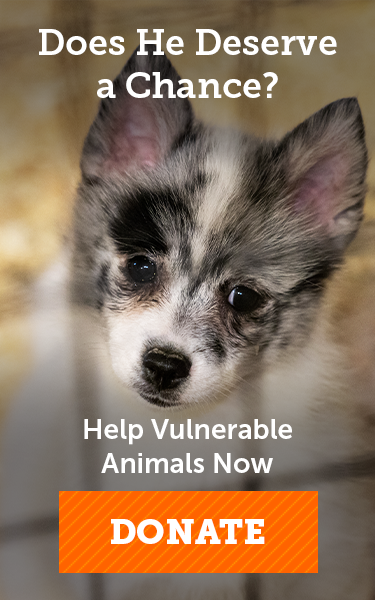
Other Ways to Help:
- Become a Monthly Member
- Take the Cruelty Pledge
- Join the Advocacy Brigade
- Volunteer or Foster
Related News
- ASPCA Participates in Annual National Night Out, Helping People and Pets
- This Saturday Is National Black Cat Appreciation Day — Celebrate by Adopting One of These Cats!
- ASPCA Assists with Suspected Dogfighting Case Involving Over 100 Dogs in Florida
Share this page:

Help the ASPCA Put a Stop to Animal Cruelty
Dog breeder found dead and as many as 10 of his Doberman puppies have vanished
Police emphasized that locating the puppies may also help solve his homicide.
A dog breeder has been found dead and as many as 10 of his Doberman puppies have gone missing as police investigate his death as a homicide, authorities said.
The Clear Creek County Sheriff’s Office in Colorado along with the Colorado Bureau of Investigation and the 5th Judicial District Attorney’s Office are investigating the death of 57-year-old Paul Peavey, who had last been heard from on the night of Aug. 19 and was reported missing the evening of Wednesday, Aug. 21, according to a statement from the Clear Creek County Sheriff’s Office released on Monday.
MORE: Murder suspect finally found after falling through ceiling during home search
Three days later, the body of an adult male was discovered just before noon last Saturday by a privately organized search party, police said.
Later that day, the coroner’s office confirmed the identity of the deceased to be that of Mr. Peavey and officials said they would conduct an autopsy to determine the cause and manner of his death, according to the Clear Creek County Sheriff’s Office.
MORE: Man drowns after pushing 2 kids to safety from strong river currents
Peavey had been a breeder of Doberman dogs, and it was reported that many of his Doberman puppies were missing from his property following his death, police said.
While authorities have not yet determined a motive in the homicide, the puppies’ whereabouts are part of the ongoing investigation, Clear Creek County Sheriff’s Office said in their statement.
MORE: 9-month-old dead after being found strapped into safety seat by grandmother in hot car for 8 hours

MORE: Sphen, one half of world-famous gay 'penguin power couple,' dies at age 11
“We can confirm that many puppies are unaccounted for, possibly as many as 10, and we are asking for the public's help in the following ways,” said the Clear Creek County Sheriff’s Office. “The unaccounted-for Doberman puppies may have been sold through social media sites or by other means since Tuesday, August 20. All of Mr. Peavey's puppies are microchipped. Anyone who purchased a Doberman puppy in the central Colorado area within the last week is encouraged to check the puppy for a microchip and contact the Clear Creek County Sheriff's Office at 303-679-2393 or [email protected]. We would then be able to determine if the puppy was one of Mr. Peavey's.”
“Anyone who purchased a puppy through Mr. Peavey’s business, Elite European Dobermans, since June 2024 is also asked to contact the Sheriff's Office. Please contact us if you received the puppy that was purchased or if you did not receive the puppy. This will help us determine exactly how many puppies are unaccounted for,” authorities continued.
MORE: Over 600 pounds of methamphetamine found inside celery shipment
The investigation is in its very early stages and police said that they would release additional information “that does not compromise the investigation or future court proceedings” in due course.
Police emphasized that locating Peavey's unaccounted for puppies may also help solve his homicide.
MORE: Ramone Alston, escaped murderer convicted of fatally shooting 1-year-old girl, has been caught
“We have gotten several tips regarding the puppies that are unaccounted for, and we appreciate all the information that has been sent to us,” authorities said.
Anyone with information about this investigation is asked to call the Sheriff’s Office non-emergency number at 303-679-2393, or submit a tip via email at [email protected].
Popular Reads

1 cop killed, 2 injured in targeted attack: Chief
- Aug 30, 7:11 PM
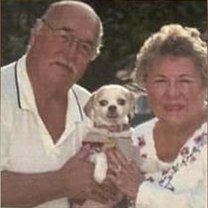
Arrest made in couple missing from nudist ranch
- Aug 30, 11:33 AM
Murder suspect found after falling through ceiling
- Aug 28, 2:09 AM

Puppies missing, man arrested in breeder's death
- Aug 30, 7:28 PM

Stranded man was hiking for World Central Kitchen
- Aug 29, 11:51 AM
ABC News Live
24/7 coverage of breaking news and live events
- Share full article
For more audio journalism and storytelling, download New York Times Audio , a new iOS app available for news subscribers.
Why Tipping Is Everywhere
In the united states, many say tipping is expected in more places these days. here’s how tipping culture exploded..
This transcript was created using speech recognition software. While it has been reviewed by human transcribers, it may contain errors. Please review the episode audio before quoting from this transcript and email [email protected] with any questions.
Hello. Excuse me?
My name is Sabrina. This is Claire. We’re journalists. Could we ask you a question?
You just did.
[LAUGHS]: Another one. [UPBEAT MUSIC]
What is your view of tipping?
I think it’s become excessive. Whatever they do, they got that jar and they’re wanting you to put a tip in there.
They have the iPad. And it’s like, all right, how much you want to tip? And it’s like you bought a $5 coffee. It’s like, all right, well, tip $3.
There’s a lot of pressure. You feel like you have to tip. And I feel like people are watching you at that moment.
Yeah, yeah. I feel a lot more pressure to tip more. Wages haven’t kept up, so I feel like I should be tipping more. And it’s annoying because my wages haven’t gone up either, so it’s annoying.
The other day I just bought a loaf of bread, and the tip thing came up, gave me the option of 15 percent or 20 percent. Do I really have to tip somebody to buy a loaf of bread?
I went to the self-service machine. And it was like, add a tip. And it’s like add a tip for what? I’m the one that did the work, you know what I’m saying?
You’re like, I should be tipping myself.
I actually am a tip worker. We’re literally paid less wages in order for the customers to pay us.
What do tips mean for you and your work?
It’s how I feed my family.
Yes. 100 percent.
Unless you work in the service industry, you don’t really understand how crucial tipping is.
Tips mean a lot. They are 60 percent, 50 percent of my paycheck. And my hourly is pretty low to begin with.
Whatever I get at the end of the night goes towards dinner. Or for example, I didn’t have money for sanitary pads one time. And then that tip, grabbed it.
I feel like a lot of people feel like you did nothing for me. You just put a cup on the counter and I took it. Like, why should I pay you extra for that?
What do you say to someone who says that? You didn’t do anything, you just put my food in a bag.
If you knew what my paycheck looked every week, you would think different. Or maybe not, maybe you don’t feel bad for me and you’re like, get a different job. But like, this is a job I’m good at and the job I like. And I’d like to be able to make a living off of it. That extra dollar or two really makes a difference.
From “The New York Times,” I’m Sabrina Tavernise and this is “The Daily.”
Tipping, once contained to certain corners of the economy, has exploded, creating confusion and angst and now even becoming an issue in the presidential campaign. Today, economics reporter, Ben Casselman, cracks open the mystery of this new era of tipping.
It’s Thursday, August 29.
So Sabrina.
Can I ask you a personal question?
What is your philosophy on tipping?
[LAUGHS]: Exactly.
Sabrina, I think I’m a sucker. Look, I’ve always tried to be a good tipper in restaurants. It feels like part of the deal.
I worked as a waitress for many years. That was the only way I actually made money. If there’s no tip, there’s no salary. Restaurants, it’s a rule.
Absolutely. But now tipping is everywhere. You see these tip screens in places you never would have tipped before. I mean, never mind the coffee shop, you see it at the fast food place. You see it at the oil change place. I’ve heard stories of people seeing it at the self-checkout line. Who’s even getting that tip?
And every time a tip screen pops up, I always tip.
Oh, my god, Ben, so do I.
It’s totally irrational. I hate it. But there’s some part of me, and I don’t love this about myself, that is just convinced somebody is going to be sitting there judging me or I’m terrified that they’re going to. And, oh, my god, if I click No Tip, am I a bad person?
And someone behind me in line might see that.
I can’t click that No Tip button.
I am exactly the same. Every single time I’m presented with this iPad screen thingy, the tips come up. I press max, 30 percent. My husband, an economist, thinks this is ridiculous.
He says, you’re tipping 30 percent on a bottle of water someone just handed you. Don’t do that. That is crazy. But I keep doing it because I can, so I should. I don’t know, I have guilt about it.
Your husband is objectively correct. This is crazy. But tipping is not about objective cold economic logic. It’s emotional. It’s cultural.
There are norms around it. And right now, we have no idea what those norms are. And so we’re all stuck in this panicked moment of trying to decide which button you press and whether you should be expected to tip in this circumstance.
OK, so we are both suckers. We’ve established that. What we need to do now is figure out this panicked moment. I want you to explain this to me, Ben. Why has tipping exploded?
I think there are three reasons. The first of these is just technology. Several years ago, we started to see these tablet-based checkout systems everywhere. And it’s very easy to just add a tip screen onto there, that little, do you want to add a tip, 10 percent, 15 percent, 20 percent.
Right. And as I had less cash and then no cash in my wallet, this was always the way I paid for things.
Yeah, so it became very easy technologically to add tipping. But then the real shift came in the pandemic.
If you think back to that moment, many of us were lucky enough to be able to work from home and to be relatively safe. And we felt a lot of gratitude for the people who weren’t able to do that, who were bringing us food and delivering groceries. And so there was an explosion in tipping. And an explosion in tipping, even in places where we didn’t used to tip.
If you go and pick up takeout at a restaurant, you probably always tip your delivery driver. But if you went to the restaurant and you picked it up, you didn’t tip there. But now in the pandemic moment, they add a tip screen saying, would you like to tip? And yeah, of course, I’d like to tip. These people are risking their lives out there to make my chicken tikka masala.
Right. You basically wanted to tip the UPS guy.
Yes. And so we were tipping everybody. And so that allowed tipping to spread into these new areas. It got a beachhead in places where it didn’t used to be.
And maybe if the story ended there, it would have been this moment in time and then it all would have gone back to the way it always used to be. But that didn’t happen because we had this intense worker shortage when things started to reopen.
And how does that fit into this?
Businesses start to reopen. They need workers. They’re having a hard time finding them. Workers are reluctant to come back for all sorts of reasons. And tipping became a way of attracting workers.
Businesses were paying more, but they were also looking for other ways to get workers. And saying, we’ll add a tip screen that’ll boost your pay further. And if there’s one coffee shop where there’s a tip screen and there’s another coffee shop where there isn’t, you can be pretty sure which one you’re going to go work at.
Completely. I mean, we were talking to workers yesterday, and they were very specific about which chain stores allowed tips and which ones didn’t. And they much preferred working for the ones that allowed tips. I mean, it makes sense.
And I asked them, as a proportion of your earnings, how much are tips? Tips are a lot. Does that mean you make less in the place that doesn’t have the screen that allows it? Absolutely.
We saw workers demanding this. In fact, when some Starbucks stores were unionizing, one of the things they demand is, we want to be able to take tips on credit card payments.
Interesting, yeah.
This became a source of negotiation between businesses and their workers. And the thing is, once that happens, it’s really hard to put the genie back in the bottle.
But why? I mean, this all sprung up into our lives in the matter of a couple of years. So why can’t it go back to the way it was just as quickly?
Imagine that coffee shop worker that you were talking to yesterday, who’s now making, in many cases, 20 percent, 30 percent, even 40 percent of their earnings in tips. The business can’t just say, never mind, we’re going to get rid of the tip screen. Maybe, we’ll put out a tip jar and people can leave $1 or $2 when they want to. That’s a huge pay cut for that worker.
OK, they could instead say we’re going to get rid of tipping and we’re going to raise your pay. Instead of paying you $15 an hour and $5 in tips, we’ll give you $20 an hour. But now the business is going have to raise prices as a result.
And you, Sabrina, the coffee-drinking public are going to say, no way, I’m not going there and paying $8 for my latte or whatever the price may be. And so for the business, they can’t just get rid of the tip, because they can’t just cut off the pay and they can’t raise prices enough to raise pay accordingly.
Right. Nonstarter for the business.
Can’t work for them. And the worker is certainly not going to stick around if they try to do that.
So has there been some experimentation with this? I mean, have restaurants actually tried to go tipless?
Yeah, so we’ve seen an example of exactly this. A few years back, Danny Meyer, a big New York restaurateur, and a bunch of other restaurants as well tried getting rid of tipping completely. They said, this system is unfair, it’s unequal. We’re going to raise wages for everybody, for waiters, but also for cooks.
We’re going to raise our prices, accordingly, to pay for that. And customers will understand. They’ll understand that they’re paying the same amount at the end of the day, it just is in the form of a direct cost instead of a cost plus a tip. And it didn’t work.
For a bunch of reasons. But mostly because customers looked at the price on the menu and people didn’t want to pay it. I also think, look, we all complain about tipping. But customers also kind of like the tip. They kind of like looking generous.
You get to show off to your date or to your father-in-law. And, of course, you can, at least in theory, express your dissatisfaction by withholding a tip or by tipping less. Not you and me, we apparently don’t do that. But some people do, I hear.
The restaurant’s like, suckers, OK, great. Yeah, we don’t even have to worry about them.
Customers rebelled against the idea of not tipping. And most of those restaurants eventually went back to the old model.
Interesting. So we do have this love-hate relationship with tipping.
Yes. We hate being asked, but we like the control. And I think that is part of why all these changes feel so difficult for so many people, because it doesn’t necessarily feel like you have the control anymore.
That screen in front of you with the barista watching you, with the person in line behind watching you —
Oh, my gosh, I’m sweating already.
— you don’t feel like can press the No Tip button. Or at least suckers like you and me don’t.
Exactly. The choice is gone.
The choice is gone. Or the choice, at least, is sort of psychologically more taxing.
Right. [LAUGHS]
You feel pressured to do it.
OK, so that’s the customer experience. But with this new uptick in tipping, one question I always have is, is the worker on the other side of the screen getting this tip or will the business owner pocket it?
The worker is getting the tip with some caveats. By law, the business owner or the managers, they can’t take the tips. If you click a Tip button or you leave $1 in the tip jar or you tip in any way, if that ends up in the pockets of the business owner or the general manager or what have you, that is wage theft. It happens. We certainly hear stories about it happening, but it’s certainly not legal and it’s certainly not the norm.
That doesn’t mean that the worker, the person who hands you your latte, is the person getting your dollar. It often gets pooled across all of the workers who are working that shift or even all of the workers who work over an entire week. But it’s going to the workers.
People like us can rest assured that the workers are getting the full benefit of that tip that you’re pushing.
In many ways, what you are doing as the customer is you are subsidizing the wage. If you, you coffee shop worker, want to get $25 an hour, you don’t care whether that’s $20 in pay and $5 in tip or $25 in pay or any breakdown of that.
$25 is $25.
$25 is $25. When I leave a tip of $1, on some level, that’s $1 less that coffee shop has to pay you, the barista. Tips are helping the business pay their workers. They’re shifting. The business is shifting some of the burden for paying its workers off of its revenue onto its customers.
In other words, you and I, Ben, we are kind of helping foot the bill for these wages.
Absolutely. And from the businesses’ perspective, that’s a pretty great deal, because they basically get to charge, say, $4 for the latte and then for the customers who are willing to pay more, they’re basically charging more. Those people throw on the tip.
It’s a way of the business getting the maximum dollars that it can out of the maximum number of customers that it can attract.
But for workers, this system where they’re increasingly reliant on customer tips carries some real risks.
[UPBEAT MUSIC]
We’ll be right back.
Tell me about these risks of our tipping system.
Look, tipping has always had a lot of problems associated with it. If you think in restaurants, they’re often really big pay disparities where the servers at the front of the house, who are getting tipped, often make a lot more money, especially at a nice restaurant, than the cooks and dishwashers and all of the people at the back of the house.
You hear these stories of people going to cooking school and then basically bailing on the cooking career and becoming waitresses and waiters because it’s just more money.
Yeah. And then within tipped occupations, there’s a lot of inequity here. There have been studies that have shown that a pretty young woman gets tipped better than other people, that white people often get tipped better. There are tons of problems around sexual harassment, because if your earnings are dependent on the table that you’re serving liking you, then maybe you put up with things that workers shouldn’t have to put up with.
Those are the problems that have always existed in this system. But then as tipping spreads, the risk is, first, just more workers have to deal with this, but also that more workers become more dependent on tips for their earnings.
In the short term, this has all worked out pretty well for workers. This has been a period where they’ve been in hot demand, and so their wages have been rising. And at the same time, they’ve gotten all these tips on top of that. And that’s been really great.
But it’s not clear that that’s true over the longer term. Over the long run, you could imagine that all of these businesses get to just raise wages more slowly, that tips sort of eat away at wages over time. And then if we ever see customers pull back a little bit, tip less, then all of a sudden, all of these workers could really suffer.
Basically, you’re describing a system in which the earnings are just more vulnerable, more dependent on the kindness of strangers.
Yeah. And more at risk if those strangers become a little less kind.
Yes. And this issue has become so much a part of the national conversation that it’s actually entered the presidential race. Both former President Trump and Vice President Kamala Harris have announced policy plans to help service workers. And essentially, they’re calling for no tax on tips.
Yeah, that’s right. So President Trump announced this several weeks ago as his big new “no taxes on tips” proposal. Kamala Harris followed up and basically endorsed that proposal, again, a little while later. We don’t have a lot of details on how this would work. But essentially, it would mean that if you earn tips, those tips are exempt at least from federal income tax.
What would that mean?
Let me tell you, economists hate this idea. Left-wing economists and right-wing economists, this is one point they can kind of all agree on.
And why do they hate it?
Because they say it’s unfair. It singles out this one group of workers for special treatment. The person who works at McDonald’s who doesn’t get tipped, they don’t benefit from this. The retail worker doesn’t benefit from this. It’s just this one group of workers who get this special treatment where they don’t have to pay taxes.
Right. Right.
But there’s also maybe an even more fundamental issue, which is that if you think you hate tipping now, if these proposals go through, you’re going to see so much more tipping.
Uh-oh, I’m holding on to my hat.
Because it’s basically a subsidy for tips.
As a worker, we said before, you don’t care whether you make, $25 an hour or $20 plus $5 an hour in tips, except that if some of that money isn’t taxed, you want more of that. You want more tips.
Basically, you want your entire salary to be a tip.
Ideally, right? And so that works great for the business perspective. Great, I don’t need to pay my workers.
[LAUGHS]: Wee!
It’s all tips now. Workers happy about that. What that means is you’re going to see more businesses looking for ways to have their workers count as tipped. Maybe you start to see tips in places that we’re not seeing them at all. Maybe you really do start to pay tips at a retail outlet, at a gas station.
Grocery store?
At a grocery store, why not? And the issue there, beyond just it being annoying for you and me, is that it further ingrains this system. All those problems that we were talking about in tipping now involves even more workers across the economy. And they’re even more vulnerable to that possibility that you and I start tipping a little bit less.
Ben, how would you describe where we are in this tipping moment? Is this just the new normal?
I think we’re still in a period of transition here. The fact that we’re having this conversation on some level tells you that we’re not totally in a new normal yet. You don’t leave a restaurant and say to yourself, man, I can’t believe I was asked to tip. But we’re still all the time having this conversation about, you wouldn’t believe I got asked to tip at the self-checkout.
Right. The bakery, for god’s sake.
It’s still a transition. It’s still happening. Over time, norms will develop. We’ll figure out the places where we tip and the places where we don’t, and how much and all of that.
But the dust hasn’t quite settled yet.
It hasn’t settled. But I think what we do know is that we’re not going back. We’re now going back to a world where we only tip in those set of circumstances where we used to. And remember, this whole transition has happened during a period of relative economic strength, when people have had money to go out and spend and to tip. The question is, what happens when that’s no longer true?
Right. When there’s a recession, people are going to be nervous about their pocketbooks and probably won’t be as generous.
Whenever we get to the next recession, it will be the first one in this new era of tipping.
And there’s a whole new group of workers who are going to lose out when that happens, who are dependent on tips and will suffer when customers start pulling those tips back.
Ben, thank you.
Sabrina, thank you so much. And the screen is just going to ask you a couple of questions at the end here.
[LAUGHS]: Ben, 30 percent.
Here’s what else you should know today. On Wednesday, at least 10 Palestinians were killed when hundreds of Israeli troops launched major raids overnight in the occupied West Bank, targeting Palestinian militants, after what Israel said was months of rising attacks. The operation, the largest since 2023, followed months of escalating Israeli raids in the occupied territory, where nearly three million Palestinians live under Israeli military rule.
And the Supreme Court maintained a temporary pause on a new plan by President Biden to wipe out tens of millions of dollars of student debt. The plan was part of the president’s approach to forgiving debt after the Supreme Court rejected a more ambitious proposal last year that would have canceled more than $400 billion in loans. The scaled-down plan was directed at certain types of borrowers, including people on disability and public service workers. The court’s decision leaves millions of borrowers enrolled in the new plan in limbo.
Today’s episode was produced by Mooj Zadie, Asthaa Chaturvedi, Eric Krupke, and Clare Toeniskoetter. It was edited by Lisa Chow and Brendan Klinkenberg, contains original music by Dan Powell, Marion Lozano, and Rowan Niemisto, and was engineered by Chris Wood. Our theme music is by Jim Brunberg and Ben Landsverk of Wonderly.
[THEME MUSIC]
That’s it for “The Daily.” I’m Sabrina Tavernise. See you tomorrow.

- Apple Podcasts
- Google Podcasts

Hosted by Sabrina Tavernise
Featuring Ben Casselman
Produced by Mooj Zadie Asthaa Chaturvedi Eric Krupke and Clare Toeniskoetter
Edited by Lisa Chow and Brendan Klinkenberg
Original music by Dan Powell Marion Lozano and Rowan Niemisto
Engineered by Chris Wood
Listen and follow ‘The Daily’ Apple Podcasts | Spotify | Amazon Music | YouTube | iHeartRadio
Tipping, once contained to certain corners of the economy, has exploded, creating confusion and angst. Now, it is even becoming an issue in the U.S. presidential campaign.
Ben Casselman, who covers the U.S. economy for The New York Times, cracks open the mystery of this new era of tipping.
On today’s episode

Ben Casselman , a reporter covering the U.S. economy for The New York Times.

Background reading
How to deal with the many requests for tips .
Former President Donald J. Trump called Vice President Kamala Harris a “copycat” over her “no tax on tips” plan.
There are a lot of ways to listen to The Daily. Here’s how.
We aim to make transcripts available the next workday after an episode’s publication. You can find them at the top of the page.
The Daily is made by Rachel Quester, Lynsea Garrison, Clare Toeniskoetter, Paige Cowett, Michael Simon Johnson, Brad Fisher, Chris Wood, Jessica Cheung, Stella Tan, Alexandra Leigh Young, Lisa Chow, Eric Krupke, Marc Georges, Luke Vander Ploeg, M.J. Davis Lin, Dan Powell, Sydney Harper, Michael Benoist, Liz O. Baylen, Asthaa Chaturvedi, Rachelle Bonja, Diana Nguyen, Marion Lozano, Corey Schreppel, Rob Szypko, Elisheba Ittoop, Mooj Zadie, Patricia Willens, Rowan Niemisto, Jody Becker, Rikki Novetsky, Nina Feldman, Will Reid, Carlos Prieto, Ben Calhoun, Susan Lee, Lexie Diao, Mary Wilson, Alex Stern, Sophia Lanman, Shannon Lin, Diane Wong, Devon Taylor, Alyssa Moxley, Olivia Natt, Daniel Ramirez and Brendan Klinkenberg.
Our theme music is by Jim Brunberg and Ben Landsverk of Wonderly. Special thanks to Sam Dolnick, Paula Szuchman, Lisa Tobin, Larissa Anderson, Julia Simon, Sofia Milan, Mahima Chablani, Elizabeth Davis-Moorer, Jeffrey Miranda, Maddy Masiello, Isabella Anderson, Nina Lassam and Nick Pitman.
Ben Casselman writes about economics with a particular focus on stories involving data. He has covered the economy for nearly 20 years, and his recent work has focused on how trends in labor, politics, technology and demographics have shaped the way we live and work. More about Ben Casselman
Advertisement

COMMENTS
Absolutely, there are many brain games suitable for puppies. In fact, starting mental stimulation early can be very beneficial for a puppy's cognitive development. Games that involve basic commands or simple puzzles can help puppies learn problem-solving skills and start to understand the concept of rewards for behavior.
5. Pulling on the lead. Solution: It's not unusual for dogs to pull but you need to teach them to walk calmly and on a loose lead. Firstly, continue to use the comfortable collar or harness you already have, to do this. Now, start the training at home, rewarding and praising your pup for being close by.
7. Redirect Them. When your dog is doing something they shouldn't, do your best to redirect them to a more appropriate behavior. You don't want to encourage the poor behavior by giving them ...
My dog knows the names of about 30 toys, and having her pick specific ones out of a pile is a great way to boost her problem solving skills. Chaser the Border Collie, an extraordinary example seen in the video below, knows the names of 1000+ toys.
The 8 Brain Games for Your Pup. 1. Hide and Seek. This classic game engages your dog's sense of smell and problem-solving skills. Start by hiding treats or toys (or yourself!) in various ...
Tell your dog to "get your toy" or "retrieve," and then show him where to take them. Once he's at the toy box, you say, "Drop it.". It may take some time for him to learn what you're expecting, but training dogs with new skills boosts their confidence and keeps them mentally stimulated. 8. Obstacle Course.
5. Nipping and inappropriate play behavior. Pet owners often worry that their dog is becoming aggressive when they start biting at a young age. But in a young puppy, this is often inappropriate play behavior. Puppies frequently nip at moving hands or legs in an effort to initiate play.
Dog/Puppy Parkour Two Feet On. Where: Indoors/Outdoors. Purpose: Health and Fitness Games. Suitable for: Puppies (<1 year) / Dogs (1 - 6 years) / Older Dogs (>6 years) Game description: Dog Parkour is a fab activity. In this dog training game, the goal is to teach them to put their two front feet of an object.
Embrace a Guided Approach to Problem-Solving. Our problem-solving lessons at The Dog Wizard offer a structured approach, assisting owners in effectively identifying and tackling a range of behavioral issues in dogs. This training process facilitates a more profound understanding between the owner and the dog, establishing a foundation built on ...
Excessive barking is considered a behavior problem. Before you can correct excessive barking, determine why your dog is vocalizing in the first place. The most common types of barking are: Warning or alert. Playfulness and excitement. Attention-seeking. Anxiety. Boredom. Responding to other dogs.
The LOOBANI Wooden Dog Puzzle Toy is great for testing your dog's intelligence and problem-solving skills. Made from durable, non-toxic wooden materials, this toy features either one or three bottles that your dog needs to tilt to release the treats from. You can choose between a small or large size, depending on your dog's breed.
Do dogs work together to solve problems? Cooperation between dogs and humans or between multiple dogs is studied to see if dogs give or receive help when needed. To assess a dog's cooperative nature, a clever test is utilized. First, one dog is presented with a string dangling from a table. When the dog tugs on the string, a treat falls to ...
Dogs are sociable creatures. If you leave your dog home alone for 8 hours, he will feel bored and frustrated. If you leave him outside for hours at a time, he will feel bored and frustrated. If you don't provide enough exercise and activities, he will feel bored and frustrated. Boredom and frustration are major causes of behavior problems in dogs.
How to Solve Your Dog's Fear of Car Rides. Separation Anxiety in Dogs. How to Stop Your Dog From Humping. Dog Body Language: Bared Teeth. How to Solve Your Dog's Fear of Children. How to Stop Your Dog From Biting. Why Puppies Eat Poop and How to Stop It. Nystagmus in Dogs: Why Your Dog's Eyes are Darting Back and Forth.
Intelligence in dogs can manifest in various ways, from their ability to learn commands quickly to their problem-solving skills and adaptability. While large breeds often get the spotlight for their smarts, many small dog breeds are equally impressive in the intelligence department. These small dogs pack big brains, excelling in obedience, agility, and various dog sports. They are quick ...
SMART Dogs Showing Off Their Problem Solving Skills | These Dogs Are Showing Everyone How Smart They Are | These dogs are VERY good at solving problems — the...
Oregon State studies dog problem-solving skills. Astonishingly, 8 out of 10 wolves successfully got the treat, while just 1 in 20 domestic dogs managed to do so in the same test. One such study was conducted by animal behavior researcher Monique Udell of Oregon State University. During the experiment, individual dogs and wolves were presented ...
Dog Problems Solved — Behaviour Problems, Puppy Issues, Rescue Dogs, Dog Training, Dog Breeds. Welcome. "My name is Gwen Bailey and I've been helping owners with problem dogs for over 20 years. Finding solutions to dog behaviour problems has been my specialty throughout my working life and this website aims to make good practical advice ...
According to the experts, one of the ways you can train them like a pro is by agreeing on a command at home so that your puppy associates the term with going to the toilet. Money.co.uk add: "Adding newspapers they've already soiled to their toilet area can also help navigate them to their next toilet break adventure." Wavetop // Getty Images. 3.
Colorado police hope a missing litter of purebred Doberman puppies could be the key to solving the suspicious death of a decorated dog breeder, "a rare case" that left the dog community with jaws ...
However, investigators are focusing on locating 10 missing puppies, which they believe could be crucial in solving the case. "It was reported that many Doberman puppies were missing from Mr ...
Solving a Problem at its Source. The ASPCA Relocation team, which has transported nearly 270,000 animals nationwide since its inception in 2014, ... "She looked like our dog, Beulah, a 9-year-old Bluetick Coonhound, and she had a similar backstory, coming from the south, with birdshot wounds to her face and jaw," said Jackie. ...
Police emphasized that locating Peavey's unaccounted for puppies may also help solve his homicide. MORE: Ramone Alston, escaped murderer convicted of fatally shooting 1-year-old girl, has been caught
Those are the problems that have always existed in this system. But then as tipping spreads, the risk is, first, just more workers have to deal with this, but also that more workers become more ...